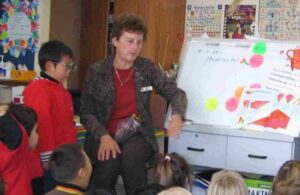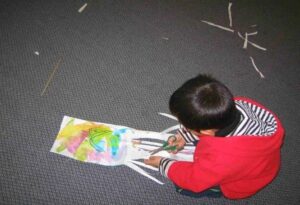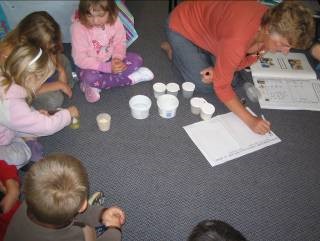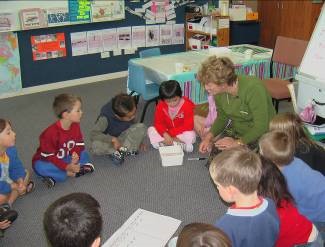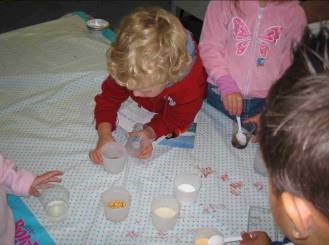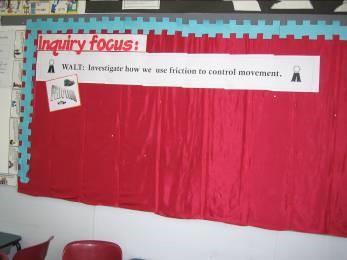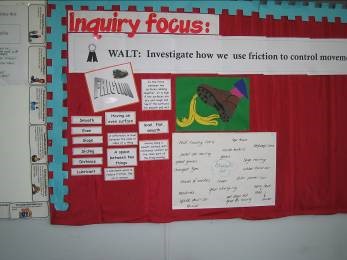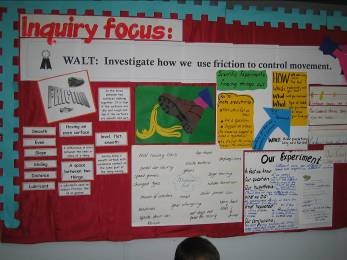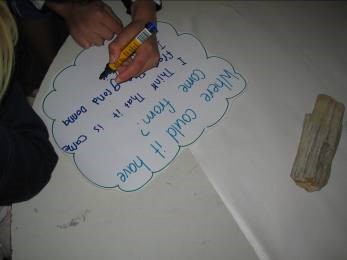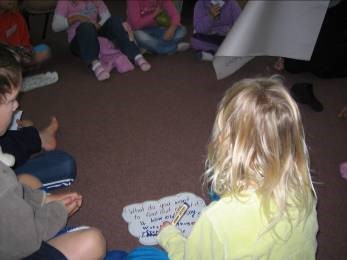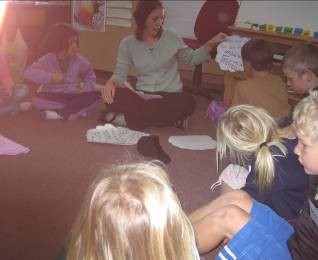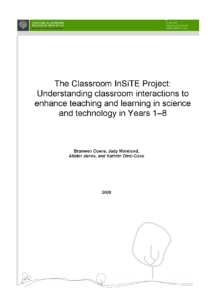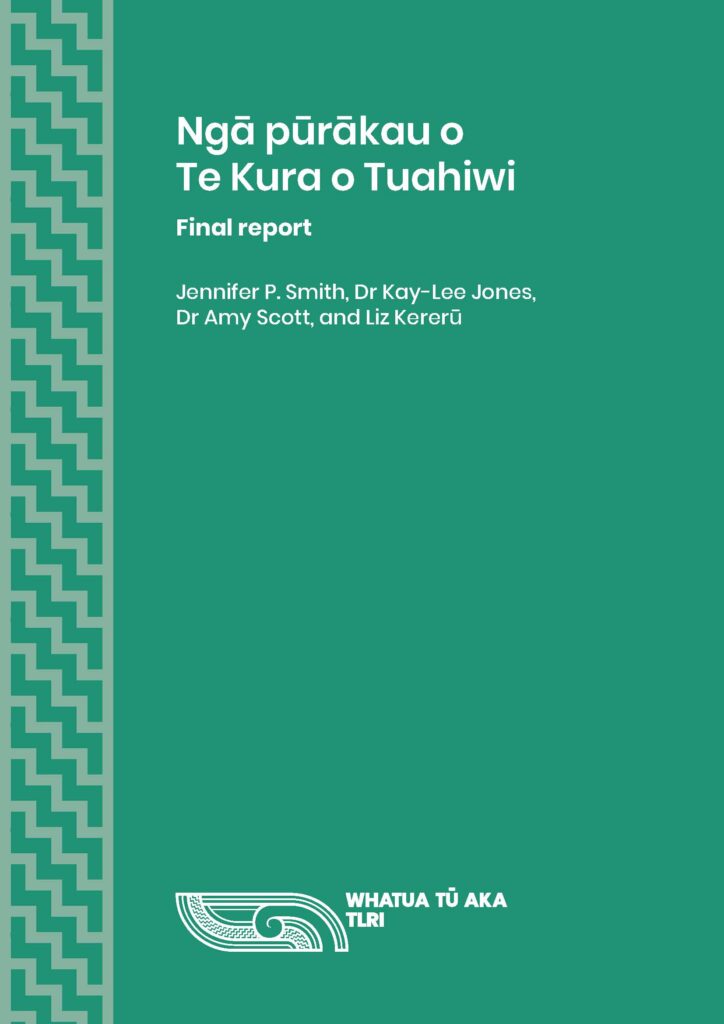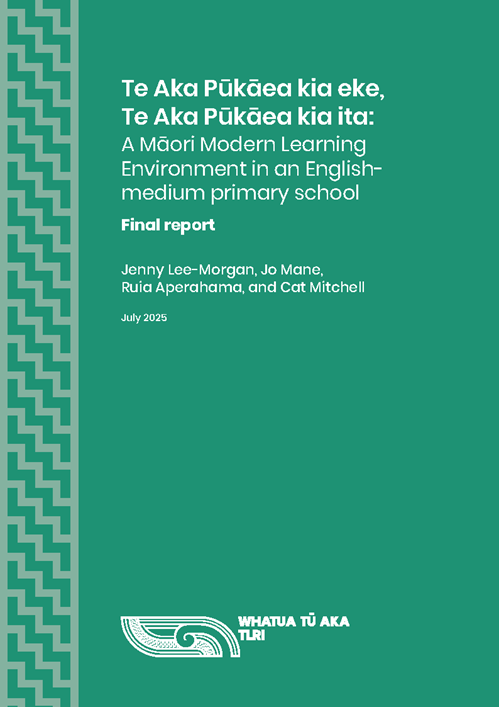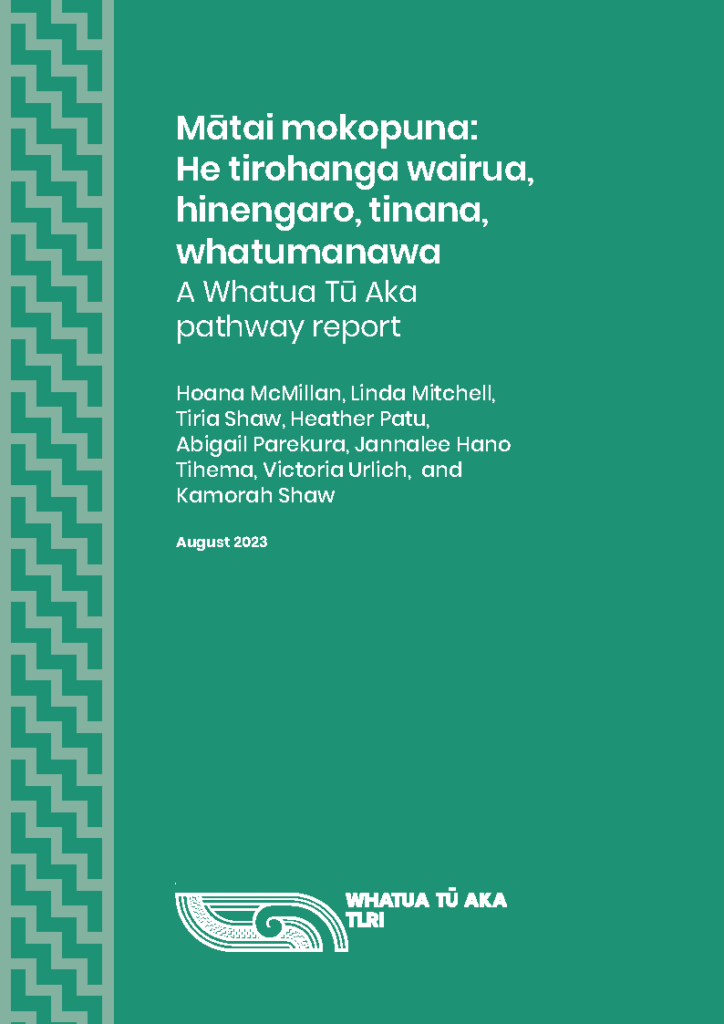1. Aims, objectives, and research questions
What really counts in education is what happens when teachers and students meet. The wisdom of any decision about education is best judged on the basis of whether or not it raises the quality of these interactions. (Atkin and Black, 2003, p. ix)
Background
A significant goal of the Classroom InSiTE (Classroom Interactions in Science and Technology Education) research project was to develop a more robust understanding of and to enhance classroom interaction and those factors that support assessment for learning. International research suggests that assessment for learning (AfL) practices are effective in enhancing student achievement, and may be particularly effective with students who are low achievers (Black and Wiliam, 1998). AfL can be distinguished from other forms of assessment by its purpose, which is to enhance student learning. The ultimate aim of AfL is that it supports student self-assessment. The contingent and emergent nature of AfL means that it is often embedded in and accomplished through teacher–student classroom interactions.
Teacher assessment for learning with diverse groups of students is demanding and complex. Teachers need a detailed understanding of possible student learning pathways along with the ability to develop and deploy pedagogical strategies to ascertain current student understandings and to move student learning forward. The blending of teacher content knowledge and pedagogical knowledge to a form appropriate for their particular students is commonly referred to as pedagogical content knowledge (PCK). PCK is knowledge that enables teachers to clothe content in activities, emotions, metaphors, exercises, examples, and demonstrations so that it can be understood and learned by their students (Shulman, 1987). Teacher PCK has been significantly underresearched, particularly in the primary school area. Up until now there has been very little indepth classroom research that explicates what teachers might do to extend their PCK and what effective AfL interactions might look and sound like. This project is therefore likely to be of practitioner interest, particularly as teachers were actively involved in shaping the research focus and dissemination processes. New Zealand primary teachers have indicated that they often lack confidence in their ability to teach science and technology, and that they are interested in developing their practice in these areas (McGee et al., 2003).
A sociocultural perspective on learning and pedagogy underpinned the InSiTE project. Sociocultural perspectives are increasingly being used to make sense of classroom teaching and learning because they acknowledge complexity and the impact of interactions between people, ideas, tools, and settings over time (Wertsch, 1991). Sociocultural perspectives allow for a focus on individual diversity and on the development of collective understanding by students and teachers as a learning community. A sociocultural approach construes student learning as influenced by student prior knowledge; the social situations in which students learn; the culture in which they participate; and the tasks, tools, and resources teachers use to stimulate and support interaction and learning. Seen this way, learning science and technology involves students increasing their appreciation of what it means to be a scientist or technologist and the ways they develop and validate knowledge in addition to students developing their understanding of the content knowledge of these disciplines. These broader understandings are of interest because they are considered to have a flow on effect on how students conceptualise their present and potential involvement in science and technology. Working within a sociocultural perspective we were concerned to analyse the two-way interactions and relationships between teachers, students, and science and technology ideas and practices both in the moment and over the long term.
The InSiTE project aims
The InSiTE research sought to build upon and extend our previous work on AfL (Cowie, 2000; Moreland, 2003) through a three-year long-term study of teacher and student classroom interactions around the ideas of science and technology. Our previous research has indicated that a least a two-to-three-year time frame is needed if teachers are to become actively involved in research-informed classroom practice and development (Jones and Moreland, 2003). Teacher change is a complex task and short-term studies can struggle to explicate and extend teacher knowledges across each of the dimensions of PCK, particularly as this knowledge needs to be deployed flexibly and generatively during AfL interactions in science and technology. The research aimed to enhance the learning and understandings of science and technology of a diversity of students. The focus was on the interactions between teachers and students around the ideas and practices of science and technology in Years 1–8 classrooms with a complementary interest in student learning pathways. Hence, the InSiTE project involved working with teachers and cohorts of students in Years 1–8 classrooms to investigate and identify over time:
- Subject ideas that teachers perceive as important for student learning in science and technology. That is, what ideas do teachers prioritise and why?
- Pertinent teacher PCK, its sources, development, and the ways it was embodied in teacher– student interactions.
- The anatomy or structure of interactions around science and technology ideas, the factors that afford and constrain interactions, and the implications of these interactions for the construction/constitution of what it means to know, do, and understand science and technology.
- Student and teacher perspectives of interactions that support learning.
- The temporal aspects of teaching and learning science and technology as these play out for students’ and teachers’ learning (including conceptual, procedural, and attitudinal outcomes).
- Student perceptions of the nature of science and technology.
The InSiTE research questions
The aims of the project translated into the following research questions, which can be grouped into five broad themes. A sociocultural view of learning underpins these themes. These themes also reflect our view of assessment for learning as embedded in and accomplished through interaction, and our intention to work collaboratively with teachers to build on their current practices.
- Teacher initial views of what is important and effective
What subject ideas do teachers perceive as important for student learning in science and technology?
What ideas do teachers hold in regard to the progression of student learning associated with these ideas?
- Teacher PCK
What is the pertinent teacher PCK in science and in technology?
What impact does PCK have on teacher–student interactions?
- Classroom interactions around ideas
What is the nature of interactions between students and teachers around science ideas and technology ideas?
What affords and constrains these interactions?
What perspectives do students and teachers hold about interactions that support learning?
- The temporal aspects of teaching and learning science and technology
How does time serve as a resource and a constraint in the teaching and learning of science and technology?
- Student perceptions of the nature of science and technology
How do students perceive and experience the nature of science and technology?
These questions framed the overall direction of the study and informed our data collection, analysis, and planned reporting and dissemination processes.
2. The research design
To address the research aims the research adopted an interpretivist methodology (Erickson, 1998). Multiple methods of data collection were used due to the complexity of the variables to be investigated. Student and teacher reflective interviews, and teacher and researcher joint planning, reflection, and data analysis meetings complemented the classroom case works, broadening the sources of data and at the same time allowing for multiple perspectives to be considered and incorporated in analysis and reporting. This section provides details of those involved in the study and sets out the research design.
The research team
The research team included university-based researchers and 12 teachers from six primary schools in the Hamilton area.
The university-based researchers were Bronwen Cowie, Alister Jones, Judy Moreland, and Kathrin Otrel-Cass. The project employed three project managers over the course of the three years: Paula Wine (2005), Marianne Robertson (2006), and Christine Deeley (2006–2007). Barbara Ryan, who was awarded a New Zealand Teaching Fellowship, worked as a member of the project team in 2006.
The participant schools were approached on the basis of long-standing collegial relationships between the researchers and the principal and/or a teacher at the school. Principals were approached to invite their school to be part of the project. They were asked to nominate teachers who might be interested in participating. We emphasised that teachers were more likely to benefit from their participation if two teachers worked together in the project. In 2005, two teachers from each participating school were involved in the project. Table 1 sets out details of the participating schools.
| Name of school & period of participation |
Location | Type | Roll | Decile | Student ethnicity 2005 (%) |
|---|---|---|---|---|---|
| Crawshaw 2005–2007 |
Hamilton | Full primary | 343 (2004) |
1 | Mäori 71%, Päkehä 12%, Pacific 10%, other 7% |
| Frankton 2005–2007 |
Hamilton | Contributing | 578 | 3 | Päkehä 45%, Mäori 42%, Pacific 8%, Asian 4%, other 1% |
| Hillcrest Normal 2005–2007 |
Hamilton | Contributing | 492 | 9 | Päkehä 60%, Mäori 7%, Asian 24%, other 9% |
| Maungatautari 2005–2006 |
Waipa District |
Full primary | 36 | 9 | 2005 data Päkehä 68%, Mäori 32% |
| St Andrews middle school 2005–2007 |
Hamilton | Restricted composite Years 7–10 |
268 | 6 | Päkehä 57%, Mäori 22%, Pacific 5%, Asian 11%, other 5% |
| St Josephs Fairfield 2005–2006 |
Hamilton | Full primary | 300 | 7 | Päkehä 77%, Mäori 13%, Pacific 4%, Asian 2%, other 4% |
| Tauwhare 2006 |
Waikato District |
Contributing | 92 | 6 | Päkehä 72%, Mäori 28% |
Initially 12 teachers were involved in the project. Details of their experience are set out in Table 2 below.
| Name | Years of teaching experience | Year level | Science/technology education background | Period of participation |
|---|---|---|---|---|
| Ellie | 20 | 3/4 | Preservice training in science PD in technology curriculum |
2005 |
| Jenny | 5 | 6/7 4/5 |
Preservice training in science | 2005–2007 |
| Gail | 32 | 3/4 | PD in science | 2005–2007 |
| Brenda | 10 | 5/6 | Preservice specialisation in science and technology | 2005–2007 |
| Jane | 17 | 0/1 | Preservice training in science Work on science and technology exemplar projects | 2005–2007 |
| Martha | 16 | 1 | Preservice training in science Work on science exemplars PD in technology HOD of ICT |
2005 |
| 5/6 | To June 2006 | |||
| Lois | 3 | 0/3 | Preservice training in science and technology | 2005–2006 |
| Grant | 4/5/6/7/8 | University maths, science, technology papers | 2005 | |
| Carol | 17 | 7 | B.Hort. PD in technology NEMP assessor in science |
2005–2007 |
| Tayla | 10 | 7/8 Digital classroom | Preservice training | 2005–2007 |
| Donna | 13 | 5/6 | PD in ICT | 2005 to June 2006 |
| Gerald | 5 | 7/8 | 2005 |
The teachers who left the project did so for a variety of personal reasons and to take up promotions and travel overseas. Six teachers were involved in the project in 2007: Jenny, Gail, Jane, Brenda, Carol, and Tayla.
Research methods
There were two main forms of data generation—classroom observation of teaching and learning units, and teacher and researcher team meetings. These alternated over 2005, 2006, and the first half of 2007. In the second half of 2007 individual teachers and the researchers they had worked with in the classroom prepared case studies of an aspect of the teaching and learning deemed by the teachers, and the researchers, to be of potential interest to a wider audience of teachers.
The research timetable
Data on teaching and learning in the three years was gathered over two phases. In each phase information was collected from classroom work and from meetings with the teachers. In total there were five cycles of classroom work and meetings; two in each of 2005 and 2006, and one in 2007. Teachers were formally interviewed at the beginning and at the end of the three years. Phase one concentrated on exploring existing practices. The focus of phase two was on enhancing interaction and learning. The exploration of new ideas to enhance interactions and learning in the classroom through the sharing of knowledge between the teachers and researchers was a characteristic of this phase. In 2005 these two phases ran concurrently, particularly in the second half of the year. We were focusing on both understanding existing practice and beginning to collaborate on how to enhance interaction and learning. Data was analysed either by the researchers or conjointly with the teachers. Table 3 below details this process.
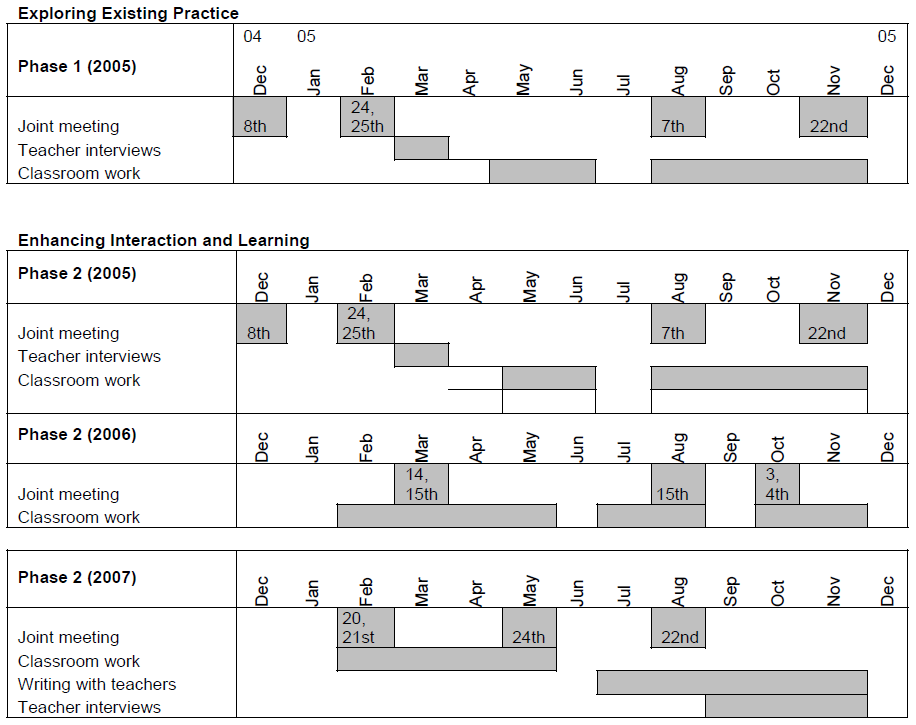
Classroom work
Teacher and student interactions were a key focus for the study and so the project involved five cycles of classroom work. To fit with school planning it was decided that rather than asking all of the teachers to teach the same unit topic at the same time the teachers would all teach a science unit for the project in the first half of 2005 and 2006 and a technology unit in the second half of each year. In 2007 the teachers chose the subject they wished to teach.
The first units the teachers planned were of three to four weeks duration, making it impossible for the researchers to attend all lessons for all 12 teachers. Instead, the teacher and the researchers who would be involved in the classroom observations came to a joint decision about which lessons would be observed. The team as a whole discussed the implications of not collecting data from a complete unit and the full range of interactions. At the researchers’ suggestion, the teachers agreed to plan the second research unit for 2005, their technology unit, to be somewhat shorter in length. This change involved negotiation of the differences between what the teachers might do for the research project and what they needed to teach to meet their overall obligations for their students’ learning.
The research team employed a number of data collection methods to generate and record data on the teaching and learning interactions. These were:
- Digital video of teacher interactions with students. One video was dedicated to following the teacher. When it was available a second video was used to record small-group interactions. y Digital audio of teacher talk. With the one exception, all the teachers agreed to wear a microphone.
- Digital photographs of teacher–student and student small-group interaction and teacher- and student-produced artefacts.
- Field notes of classroom interactions.
- The collection of teacher planning documents and any materials produced by the teacher during a lesson.
- The collection of student work samples and products. From the second round of classroom observations the teachers agreed to their students recording their work in a book provided by the project for this purpose. Student books were collected and retained for analysis.
Two researchers were present during most of the classroom observations. This allowed us to enhance the data collection and analysis process through the incorporation of multiple perspectives.
Postlesson conversational teacher interviews were undertaken. These conversations discussed events of interest and explored options for tasks and activities in the following lesson(s). In 2005 and 2006 teachers were asked to make time available for this and most did. In 2007 all teachers arranged for someone to supervise their class so that they were free to talk with the researchers after each observed lesson. This allowed for a more relaxed and focused reflection on the preceding lesson. Over time the teachers became more at ease and confident to add their own thoughts and analysis to the classroom work.
Students were interviewed before and after an observed unit, where this was possible. They were interviewed as individuals or in small groups, based on researcher judgement, student preference, and teacher recommendation. When a teacher did not elicit student prior knowledge, and occasionally in addition to a teacher doing this, students were interviewed about their ideas. Students were also questioned about their experiences during and after lessons, often using their own work as a prompt or focus for talk.
Joint teacher and researcher meetings
Joint teacher and researcher meetings provided an opportunity for the whole team (teachers and researchers) to contribute jointly to the focus and direction of the research, to planning for enhanced teaching and learning of science and technology, and to the analysis of classroom data. An initial researcher analysis of the classroom data was reported to the teachers for member checking and discussion at the meetings. These discussion results informed planning for the next round of classroom work.
Approach to analysis
Postlesson teacher–researcher discussions and team meeting days provided a forum for joint data analysis. Teacher and student interview data, classroom observational data, and student and teacher work samples were categorised and analysed for telling examples and themes. Teachers and researchers jointly contributed to the construction of the analysis of student learning pathways and the interactions that supported these. An important part of this process was the development of a more nuanced language for describing and discussing classroom interactions, student learning pathways, and teacher PCK.
An initial analysis of the video data has been undertaken using StudioCode, a program for coding and analysing video data. The team spent considerable time exploring the affordances of this programme and developed a number of categorisation trees. At this time a first-cut analysis has been undertaken based on the social context of interaction and apparent teacher purpose for interaction. The social categories used were whole class, small group, and individual student. The purpose categories used were eliciting student ideas; introducing tasks, ideas, skills, and procedures; and following up and developing student learning. A more detailed analysis of the video data is planned for 2008.
Ethical considerations
Informed consent was gained from school principals and participating teachers in 2005. Teacher consent was reconfirmed at the beginning of each year. During the study, consent was gained to continue the study from principals new to a participating school and from the principal when a teacher moved to a new school.
Informed consent was gained from the participating students in each of the three years. This proved a time-consuming and challenging task for the teachers. As a consequence of the difficulty teachers experienced in collecting signed parental consent forms, the consent forms were revised for the second half of 2006. The researchers acted on advice from the teachers to reduce the degree of complexity and quantity of detail in the consent form. The revised ethical consent form proved more successful. The revised form was used again in 2007.
Strategies employed to develop effective partnerships and relationships
Given the complexity of the focus of the project it was important that teachers were actively involved in and contributed to the research. One of the participating teachers, who was at Centre for Science and Technology Education Research (CSTER) on a New Zealand Teaching
Fellowship at the time the proposal was prepared, was actively involved in the initial planning and writing of the proposal for the project. Principals and teachers, as they were approached to be part of the study, were invited to contribute to and comment on its structure.
The project was set up as a collaborative research project based on the notion of negotiated intervention. The negotiated intervention process acknowledges that researchers come to a research project with particular knowledges, interests, and skills. It acknowledges that teachers come to a research project with their own knowledge and expertise. Within a negotiated intervention approach the aim is that together the two professional groups will negotiate, in an ongoing and responsive manner, the course of the research, albeit within the broad framework of goals that both agreed on at the inception of the study. This philosophy underpinned the iteration between classroom work and joint meetings to reflect on and plan for further classroom work. It underpinned the initial focus on the researchers developing an understanding of what the teachers considered important for student learning in science and technology and the nature of their existing classroom practice. It also underpinned the ways the teachers and researchers worked together in the classroom.
Issues of significance for investigating classroom interaction
The importance of the three years
The project evolved over the three years as the researchers and teachers together clarified and refined the focus of the study, how they might work together, and how they might enhance interaction around science and technology ideas.
The first year served as a time for the teachers and researchers to get to know each other and to begin to develop a shared understanding of the focus of the study. In particular, there was considerable discussion around the definition of PCK and what its instantiation might look like. Similarly, the team discussed the meaning and possible practical embodiment of student learning pathways. The first year of classroom work also allowed both parties to experience and think about what was happening in the different classrooms. Time was spent developing mutual understandings of, and language for the description, analysis, and discussion of, classroom interactions, student learning pathways, teacher PCK, and educational research.
On the basis of mid-2005 discussions, the decision was made to introduce to the teachers a planning framework that had been developed by teachers in a previous study (Jones and Moreland, 2003). The purpose of this was to provide a basis for collaborative planning between the teachers and researchers, and between the teachers. Another purpose was to encourage the teachers to provide more detail of their intentions for student learning and the interactions they anticipated they might have with their students. In conjunction with the classroom work, the planning framework served as a resource that enhanced joint reflection on, and analysis of, the teaching and learning, and joint thinking about where to next with the project. The process of collaborative planning and reflection appeared to support the teachers in taking a more active part in shaping the direction of the project.
The second year began with a two-day meeting. This served as an opportunity for extended reflection on and analysis of the first year of the project. The researchers introduced a refinement of the planning framework based on their analysis of the second cycle of classroom work. At this meeting the teachers and researchers, in various groupings, had ample opportunity to plan and prepare for the third cycle of teaching and research. Teachers and researchers agreed on the need to collect student work samples. To facilitate this the project provided books for the students to use. Subsequent joint meetings, and cycles of data collection, were completed collaboratively. The meaning and actualisation of PCK, the nature of learning pathways, the dimensions of classroom interactions, and issues around how students might represent and make visible/audible what they knew and could do continued to be a focus for discussion and debate.
The teachers and researchers began the third year with a two-day meeting, which again focused on planning for teaching and reflection on the previous year. The teachers decided whether they would focus on science or technology and identified a topic of interest to their class. The planning process was notable for the extent of the sharing and critique among the teachers. Some teachers built on unit plans that had been taught earlier in the study, seeking advice and guidance from those who had taught them and from the group as a whole.
From the researchers’ perspective, the three years allowed them to develop rapport with the teachers as individuals and as a group. Where possible each of the researchers worked with the same teacher throughout the project. By the third year the researchers were able to draw on previous classroom observations to help them observe and understand classroom events. This assisted in the postlesson discussions because the teacher and the researchers could compare and contrast the current and past lessons, interactions, and student responses. By the third year the researchers had a deep understanding of teacher classroom practices and the thinking that underpinned these.
The three years also allowed the researchers time to consider and develop their theoretical understanding of PCK, interactions, and the temporal aspects of teaching and learning science and technology. The cycles of classroom work interspersed with data analysis, writing, and reading meant that insights gained from one cycle could inform the next so that the data collection and planning and preparation process could be refined.
Working across two curriculum areas
Working across two curriculum areas has proved to be both a benefit and a challenge. Both science and technology were somewhat peripheral to the main thrust of the classroom and school curriculum in the InSiTE classrooms. They were both areas that the teachers were concerned to enhance, and in which they considered they lacked confidence in their teaching. Added to this, both science and technology have a specialist terminology, set of skills, and tools for representing and communicating ideas that need to be taught and learned. On the other hand, our focus on two subjects highlighted the subtle differences in the nature of effective teaching and learning of science and the effective teaching and learning of technology. These were most obvious in the different demands in planning. The technology units tended to revolve around students accomplishing a multifaceted task, typically the production of an artefact. Teacher planning benefited from considering the subtasks the students needed to achieve, along with the skills and knowledges they needed. The science units tended to revolve around a key idea with a sequence of tasks designed to provide students with an accumulating set of experiences that would enable them to develop this idea.
For the teachers, too, we think there were benefits and disadvantages to their working in two curriculum areas, both of which they considered challenging to teach. At this time we consider we have been able to extend their thinking about science and technology so that they realise that concepts and skills, as well as processes, need to be taught and learned. In both subjects they consider they have gained from a greater attention to, and time spent on, planning, the artefacts they might use, and the interactions they might have. The teachers have indicated they consider they have made greater progress in understanding the nature of technology and technology education, perhaps because they were initially less confident about teaching technology than teaching science.
Negotiating roles
The InSiTE study, as a TLRI project, was set up to enhance teacher research capacity through involvement in the study as a teacher-researcher. The InSiTE teachers did not, however, take on all aspects of this role. Rather they were interested in working with the researchers to research their own practice, with the teachers taking major responsibility for the teaching and the researchers taking the main responsibility for the research, and each contributing to the work of the other. Over the course of the study the classroom role of the researchers evolved to that of a “colleague in support of the teacher”. The teachers’ role evolved to that of a “colleague in support of the researcher”.
As researchers in the classroom, we juggled to balance documenting what was happening with providing on-the-spot support and advice about teaching and learning. During lessons we would consult with each other as researchers and we would talk with the teacher about the teaching activities and student learning. The teachers would refer us to student interactions and to events that might be of interest in the project. During the after-lesson discussions we all described and discussed what we considered interesting and noteworthy events and interactions. This was a time of pooling of information about student actions and demonstrated understandings, of teacher intentions, and the perceived impacts of teacher actions and interactions. It was also a time for collective discussion of possible tasks and foci for the next lesson(s). We consider this dynamic two-way interaction enhanced the trustworthiness of the processes and outcome of our research.
During the lessons the researchers tended to interact with students as an adult who might help them and who was interested in their learning. Students in all the schools we worked with appeared very comfortable with adults other than their teacher being present in the classroom. After an initial introduction by the teacher we fielded very few questions about our physical presence. The younger children tended to ask us for help much as they did other adults in the classroom, leading to a danger that this role would dominate. The older children seemed to exercise more discretion in terms of the help and questions they asked. They appeared to differentiate between us and other adults in the room. Students of all ages were always willing to talk to us about their ideas and show us what they had done.
In the next section we set out the main findings of the project.
3. The findings
This section sets out the main findings of the project in terms of the research questions framed in the original proposal. They are addressed in clusters relating to teacher initial perceptions and practices, teacher PCK, the nature of classroom interactions around ideas, and temporal aspects of teaching and learning.
Initial teacher perceptions and practices
Here we comment on some of the themes that emerged from the initial interviews and classroom work.
Teacher goals for science and technology in the first year
The interview evidence indicated teacher goals for student science and technology were that student learning should be fun and that students should develop a positive attitude and interest in both subjects. The teachers wanted science and technology to be authentic and relevant to the children’s lives:
Quality experiences and something that is authentic for the children so they’ve got a real purpose for what they’re doing … what I find hard is they can come up with all these ideas but a lot of times the materials aren’t what they can work with so it’s only a model and I quite like to try and keep it something that could actually be real for them as opposed to ‘I’ve made a letterbox but it’s out of cardboard because I can’t make it out of metal’ and then they can’t use it anyway. (Jane)
I want them to look at an idea and link it back to them, I want them to relate to it, have personal involvement in areas that they can relate to. (Ellie)
The teachers emphasised the importance of learning the language of science, this tied up with students learning the concepts of science. All of them taught science vocabulary—for example vibration, stem, tuber, camouflage, habitat, constellation, planisphere, gravity, substance, metamorphosis, igneous, hypothesis, results, conclusion, and so on. The teachers provided opportunities for their students to use these words in conversation in both whole-class and small group/paired contexts. Two teachers explained why they valued students learning the language:
[I have a] big focus on oral language … like when I did magnets last year I have a list of vocab that I want children to learn, or understand about what they are, so you have your lists of vocab and then your oral language activity just sort of reinforces what’s been taught. (Lois)
I think one of the most important things is that the children are able to clearly articulate their science ideas. I think one of the most important things we can do in the first year at school is actually to develop their language skills … to develop their vocabulary and to develop their language-processing skills because some children have quite good learning experiences but they aren’t always able to retrieve those experience. (Jane)
Some teachers talked about the importance of investigative skills in science, intimating that they saw these as a key element in science learning, and thereby revealing their view of the nature of science. This view of the nature of science appeared to underpin the tasks teachers selected, such as designing and/or carrying out science investigations and fair tests:
I’d expect them to be able to construct and carry out a fair test and, obviously, to be able to write a conclusion using scientific ideas. (Carol)
In some instances the teachers appeared to conflate science investigations with fair testing.
Some teachers talked about the importance of designing, making, and testing in technology, intimating that they saw these as a key element in technology learning, and revealing their view of the nature of technology. The teachers emphasised students learning technological knowledge and becoming technologically capable. They placed less emphasis on the links between technology and society in the interviews.
Just developing the skill of being able to independently plan or design something and then start to be able to use the plan. (Lois)
There will be times when they are doing purely technology as far as the designing of the traps goes. (Grant)
Actually making pinhole cameras as a truly technology focus. (Gail)
In some cases the teachers highlighted the importance of product testing to the extent that this was construed as an expected and essential procedure.
Emerging themes for classroom interaction
The InSiTE project was focused on classroom practices as expressed in the interactions between teachers and students around the ideas and practices of science and technology. Consistent with the goals they had expressed, the teachers considered effective teaching to be hands-on, purposeful, and engaging for their students. As one teacher commented:
I think them actually seeing things and doing things … like you can tell them things and it’ll be forgotten or they may not even hear it, but if they are actually there, hands-on, seeing and doing, that’s really powerful. (Tayla)
It’s got to be of interest to the children and the learning is purposeful. (Lois)
A perceived outcome of hands-on activities was that students would develop positive attitudes and confidence about learning and doing science and technology:
I think lots of hands-on … they were so delighted they could make a light, their sense of achievement that they got when they actually got the light going. It’s hands-on. They can do it. They can see whether it works or see whether it doesn’t. (Martha)
When children want to go and do their own investigations they will have the tools to go and do their own no matter what the topic might be and realize they can do science no matter what it is. (Carol)
Science and technology as add-on subjects
Several teachers explained that science and technology tended to be “add-on” subjects competing for attention with other educational priorities such as numeracy and literacy in an “overcrowded” curriculum.
When you have an overcrowded curriculum, as you do, people will water things down to fit everything in and that’s just how it goes. The numeracy project, it’s in your face all the time, so it’s a ‘have-to’. Science is in a green book on the shelf. (Jenny)
For this reason the teachers sometimes combined technology with science, beginning with the science content and moving on to a technology task that required that science content.
I thought I could integrate what I’m doing with science … I’ll be looking at flight next term so I’m hopefully going to make kites and how the aeroplanes relate to technology as well. (Tayla)
Term 2 we are doing living science … basically we’re looking at what they are doing up on the mountain here. That’s part of the unit and why they are fencing it off and how to save an endangered species … and then on the technology side of things we’re doing pest traps which sort of ties in. (Grant)
Limited professional development in science and technology
The peripheral position of science and technology was reinforced in the interviews as teachers recalled having had little or no professional development in science and technology, especially compared to numeracy and literacy:
I mean, I did science at secondary school right through to sixth form and I stopped. You know I enjoyed science … but you don’t get an awful lot of it. As a teacher I haven’t had a lot of science development. The focus has always been on numeracy and literacy. (Lois)
I’ve been teaching for a while now and I’ve never had any in-services in science, but I’ve had in-services in the social studies, in maths, in English, all parts of literacy … there’s no driving force behind it [technology]. (Donna)
The teachers also highlighted that although in-service provision for science and technology was low compared with other curriculum areas, this was also true for preservice teacher education.
We come out of that programme [preservice training] with not enough, especially in science and technology. Once in school, there is a lot of support in English … overload … but there is a lack of enthusiasm or passion in schools to push and lead in science and technology. (Carol)
Throughout the interviews there was a general sense that teachers felt less confident about teaching technology compared with science. In interviews the teachers explained how they believed that they did not always plan, teach, or assess technology to their satisfaction.
Technology is one of those subjects for me that I can put down that we’ve visited. Quite often I don’t assess it properly, or actually I don’t think I teach it very well either. (Ellie)
I don’t know too much about technology to be honest. I know the document is here and I just look through that. (Tayla)
Teacher goals for being involved in the InSiTE project revolved around addressing this lack and improving their teaching and learning of science and technology. For example, they were hoping to improve their practice, think about why and what they did in science and technology, improve the quality of their questioning, and raise the awareness of science and technology throughout the school.
The need for a broad and flexible knowledge for teaching
For teachers, planning topics and using contexts that were familiar to their students sometimes presented challenges to their knowledge of content and how to teach this. Everyday events and artefacts can have complex science and technology underpinnings. In technology, for instance, familiarity with an artefact may obscure any ideas inherent in its construction. One example of this complexity arose for Donna in the unit in which she had planned for students to design and make an umbrella. Her preparation had not alerted her to the function of hinges as a key mechanism of umbrellas. When the students examined and then attempted to design their own umbrella they did not identify the hinges as significant, in part because Donna had not drawn their attention to them. This proved to be a stumbling block for the students, one that required Donna to undertake further research. Instances like these highlighted the challenges inherent in teaching science and technology.
Because the teachers tried to be responsive to their students, they faced a number of challenges in responding to student questions in topics and around ideas. For instance, Tayla, a Year 7/8 teacher, described herself as having limited experiences and knowledge in science. During our first two classroom observations Tayla facilitated learning experiences where the students were “doing” activities, rather than necessarily interacting around ideas. Tayla had planned another activity-based lesson for our third observation but had to change it at the last minute. The lesson ended up as a follow-up discussion about the previous day’s lesson on physical and chemical changes. Early in the lesson it was evident that while Tayla had some knowledge of physical and chemical changes she was finding the dynamic, unpredictable nature of the class discussion problematic. Tayla confidently explained water freezing as a physical change, using the criterion that the process is reversible. However, when the students suggested other examples such as “a seed growing”, “a glass breaking”, “an egg boiling”, or “chocolate melting in your mouth” she struggled to respond. Although Tayla had learned and read about these concepts herself, the students’ questions and comments moved beyond the examples and contexts with which she was familiar. This is an example of a primary school teacher who was self-reflective enough to actively improve her own content knowledge prior to teaching, yet her reliance on definition and a restricted set of examples, along with her limited experience in applying the concepts, restricted her ability to respond to student ideas. Tayla’s acknowledged lack of PCK may have been what led her to focus more on activities than ideas.
These examples highlighted for the team that even with preparation, interacting with students around ideas can be difficult and daunting. Teachers cannot provide experiences and activities that guide student progress toward understanding of ideas if they themselves have limited experience with the relevant science and technology concepts and processes, raising issues around the extent of teacher PCK.
The influence of tasks on classroom interaction
Classroom observations raised our awareness of the influence of tasks and their associated materials and resources on student learning. We observed episodes where the teacher’s choice of task appeared to stimulate student interest, engage student prior knowledge and experience, and extend student thinking. When a task or resource was unfamiliar it appeared to distract students from the learning the teacher was aiming for. An instance of this occurred when Martha, an experienced Year 1 teacher, introduced a plant unit with a labelling task she had used successfully before. She began by discussing the meaning of the word label, then proceeded to model the skill of labelling by labelling a familiar stick figure of a girl on the whiteboard. Martha, with the help of her students, labelled the relevant parts of the diagram with “head”, “arm”, “skirt”, and “leg”. She then gave the students a computer-generated picture of a flower and asked them to label the parts. This task appeared to be problematic for several students: some students labelled the flower with “head”, “arm”, “skirt”, and “leg”, simply copying from Martha’s example on the board; other students completed the task in a similar way, but labelled the picture with “head”, “hair”, “neck” and “legs”; other students left the labels blank and focused on colouring the flower instead; and others mislabelled the diagram with plant names. There are several possible reasons for the students’ inaccurate labelling: the task itself was unfamiliar to the students (both in the symbolic representation of the flower [computer generated] and the skill of labelling); the use of teacher modelling as a pedagogical approach was confusing for students; the students may not have known the parts of the plant; or, they may not have known how to write/spell the parts of the plant. Martha was an experienced teacher who had demonstrated a repertoire of pedagogical approaches, yet even she was surprised by the outcome with this particular group of students.
In another example, Tayla, a Year 7/8 teacher who taught in a “digitech” classroom, set her students the task of working through an interactive computer programme, which simulated chemical and physical changes. The students made predictions about changes, observed the changes and then read the explanation of the changes. The computer gave the students information about the science concepts and feedback on their responses. Whilst the computer programme had the potential to enhance learning, we observed that many students focused on completing the task, racing through each simulation without reading the information or discussing the ideas with their partner. We observed teacher–student interactions to do with “writing in complete sentences” and managerial tasks of how to operate the programme, but with very little dialogue about the science ideas. In the absence of the teacher, there was very little student– student interaction about chemical or physical changes or justification of ideas. The students’ attention was on the tool itself and “getting through” this unfamiliar programme.
These examples, amongst others, highlighted for the team the way tasks and task resources and how the teacher talks them into meaning then impacts on student perceptions and interactions. When a task, its resources, and embedded ideas are not familiar to students they do not always engage with the task as the teacher intended. This could act as a barrier to a student fully communicating and developing their knowledge and understanding, raising the issue of task design as one that was worthy of investigation as a means for enhancing student–teacher interaction.
Students representing their ideas
Classroom observations revealed a tension around the role and importance of writing within science and technology lessons. In the early primary years, science and technology topics often provided a focus for writing as part of teachers’ language programmes. In the upper primary years, writing appeared to function as an activity for students to reflect on and articulate what they had learned, and to clarify, reinforce, and focus ideas because, in the words of Tayla, writing “helps them remember”. In technology students thinking through and developing their ideas by drawing emerged as an issue because the students often lacked design drawing knowledge and skills. Initially, though the teachers discussed this as a problem, they did not see that the solution was to deliberately teach this design knowledge and skill. This contrasted with their commitment to teaching the language and language processes of science and technology, and contributed to a shared concern with the ways students might represent their ideas.
Making connections between ideas and tasks
Some classroom observations highlighted the difficulty students had in making links between the science concepts being learned and the use of these concepts in investigations; and between technology conceptions and how they are played out in the design process. For example, we observed a class who were asked to design an investigation to find out more about milk after learning about the properties of milk and making milk products such as butter and yoghurt. There was little evidence that the students were transferring these concepts to their experiment designs, or that they were finding out more about milk. These investigations did not appear to contribute to students’ science concept development. Sometimes interactions in technology were around particular techniques that students were required to undertake, such as drilling and measuring, without an attendant concern with the need to drill in a particular place for a particular reason or the need for accuracy. At other times teacher–student interactions converged on students’ production of a particular artefact without a complementary push on the concepts or procedures integral to this process. Thus, making connections between the different student learning outcomes was raised as a potential issue for further investigation.
Summary and conclusions
This section has reported on some findings from the first year of the Classroom InSiTE study. Our teachers had a commitment to providing their students with stimulating, relevant, and purposeful learning experiences in science and technology. However, teacher commentary highlighted that students’ science and technology learning was only one of their responsibilities. Most teachers believed that science and technology should be hands-on, purposeful, and engaging for students. Teachers had less confidence in teaching technology than science. Teacher descriptions and choices of science and technology tasks, and associated classroom interactions, provided an insight into their pedagogical knowledges and also their understandings of the nature of technology/science.
Having gained some understanding of teacher perceptions and practice our next step was to work together to extend this understanding and to enhance teaching and learning in the classroom. In the next section we elaborate on the nature, sources, and development of teacher PCK, and illustrate the part it plays in interactions. In the following sections we address the aims and questions to do with interactions and the temporal aspects of teaching and learning.
Teacher PCK
PCK describes the special knowledge that effective teachers employ when they transform their subject matter knowledge into learning experiences by using appropriate strategies and representations that make sense to their students. Teachers are able to use pedagogically powerful ways of representing the content when they take into account their students’ preconceptions and understandings. Primary teachers generally have a deep knowledge of their students and a broad repertoire of pedagogical practices. However, they often lack indepth science and technology content knowledge and tend to have a limited repertoire of science- and technology-specific pedagogies (Goodrum, Hackling, & Rennie, 2001; Harlen, 1997), which impacts on their PCK, and exacerbates the challenge inherent in any AfL interaction. These require teachers to confront simultaneously issues to do with content; pedagogy; and student skills, interests, and understandings. In this section we detail the ways the InSiTE teachers developed their PCK, and some of the ways this played out in classroom interactions.
Articulating and developing teacher PCK
Several means for the development of teacher PCK have been identified in the literature, including classroom observations, studies in science and technology, teacher professional learning programmes, and personal classroom experiences (Grossman, 1990). The analysis of student work can also contribute to the development of teacher PCK (Ball, 2000). So too can the analysis of videotapes of classroom lessons (Lampert & Ball, 1998; Stein et al., 2000). Additionally, welldesigned curriculum materials have been shown to support the development of teacher knowledge through the way they represent concepts, tasks, procedures, and teaching approaches (Ball & Cohen, 1996). Activities that teachers identify as successful for developing particular science ideas are an articulation of some aspects of a teacher’s PCK (Appleton, 2003) and so recommendations from trusted colleagues about what worked for them in their classrooms can also be a resource for the development of PCK (Appleton & Kindt, 1999). Working with our teachers we identified several means for developing teachers’ PCK. These included the use of subject-specific planning frameworks, personal classroom experiences, and teacher–researcher meetings as professional development that included analysis of student work, recommendations from trusted colleagues, time for planning next teaching, and discussion of research findings.
Subject-specific planning frameworks
One of the most effective means for developing the InSiTE teachers’ PCK was the use of a planning tool specific to each subject. We had already successfully used a subject-specific technology planning framework in promoting the articulation and development of primary teacher PCK in technology education and therefore decided to build on this success. In this study we adapted the framework to better fit the nature of science and added a second layer. The first layer of the planning framework focused on the intended learning outcomes and the second on the intended ways the learning outcomes would be put into action in the classroom. We instigated the use of the first layer of the planning framework in the second half of 2005. The focus was on technology, and the planning sheet the InSiTE teachers used was an exact replica of the planning framework already successfully used by primary technology teachers in the LITE (Assessment) project. From our interviews with the InSiTE teachers, and their indication that they wanted help with their technology teaching, we decided to introduce the LITE planning framework in a teacher–researcher meeting after the teachers had taught science but before they taught technology.
The technology planning framework
The first layer of the technology planning framework focused on teachers identifying intended learning outcomes. It included spaces for articulating the task definition, the technological area/s, the overall dimensions of technology, and the conceptual, procedural, societal, and technical learning outcomes (see Figure 1).

When teachers defined the main task and the particular technological area and/or areas, they were compelled to think about the overall direction for learning within a particular technological area/s. The main task was the overall technology task that the teacher designed for students to achieve, for example to use materials found on the farm to make musical instruments for a public performance. Teachers also specified learning outcomes in four categories: conceptual (knowledge and understanding of relevant concepts and procedures); procedural (knowing how to do something, what to do, and when to do it); societal (aspects related to the interrelationship between science and technology and groups of people); and technical (skills related to manual/practical techniques). This helped them to think about the specific learning outcomes inherent and nested in the overall task and related to the particular technological area/s. As well, teachers considered how the learning outcomes in the four categories might coalesce and work together in a more holistic manner. When teachers were completing this layer they used an iterative process where they moved back and forth between defining the main task, articulating the concise intended learning outcomes within the four categories, and conceptualising and bringing together the technological practices embedded in the main task. This iteration helped them to keep the categories coherent, interconnected, and consistent.
Figure 2 shows Jenny’s planning of intended learning outcomes for her students’ percussioninstrument-making unit. The students were going to be involved with a school production and needed to produce a musical item. This context provided an authentic rationale for creating percussion instruments. As well the students were studying dairy farming in social studies, hence Jenny’s decision to use the farm visit for the students to gather material from which to make their instruments. A further aim of developing her students’ environmental consciousness led to her deciding to focus on the use of found/recycled materials.
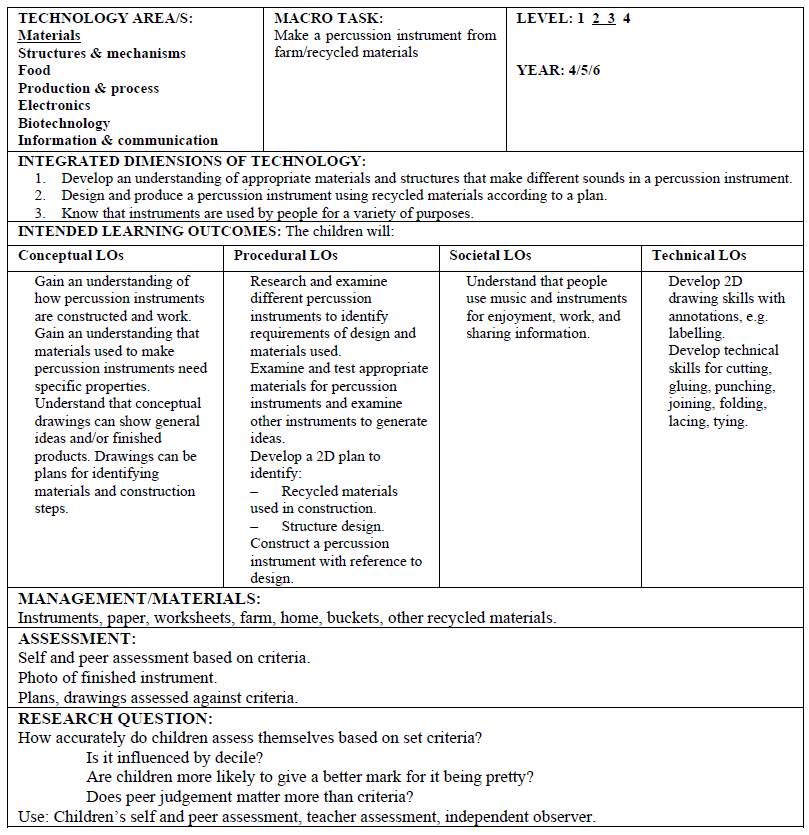
Jenny has defined the technology learning in detail and with precision. She has focused on the key ideas and skills of percussion-instrument-making technology that she wanted her students to learn. She has defined the main or macro task to provide overall direction for learning, i.e. “Make a percussion instrument from farm/recycled materials”. Below the macro task she has specified three broad technology learning outcomes: 1) develop an understanding of appropriate materials and structures that make different sounds in a percussion instrument; 2) design and produce a percussion instrument using recycled materials according to a plan; and 3) know that instruments are used by people for a variety of purposes. These clarify the macro task and identify broad technological concepts and procedures. More specific learning outcomes of technological, conceptual, procedural, societal, and technical nature were then defined. These are written for her Year 4 and 5 students. This list of outcomes demonstrates her understanding of technology and her PCK. For example, she defines drawings in ways that her students can understand— “conceptual drawings can show general ideas and/or finished products” and “drawings can be plans for identifying materials and construction steps”. She also specified the materials she would need and her assessment means (self and peer assessment, photo of finished instrument, plans and drawings) and foci (the criteria). Finally she has included her focus research questions for this unit, indicating her growing interest in researching her teaching.
The second layer of the planning framework was not introduced to our teachers until 2006 after we realised that they needed help to make closer connections between the intended learning outcomes and the tasks they used. This layer required the teachers to outline in series the nested meso and micro tasks that would assist the students to achieve the main (macro) task, and in the process work towards the intended learning outcomes (Moreland and Cowie, 2007). This segmentation and sequencing allowed the teachers to structure the tasks in a nested and interrelated manner. The macro, meso, micro task structure helped them think about how they would connect the various tasks together in a coherent manner so that they would help their students learn particular technology ideas and skills. Also included on the planning sheet were spaces for specifying any resources or focal artefacts (Roth et al., 1999) and for detailing any planned interactions and the specific student outcomes associated with each task. The focal artefacts were the teaching materials to be used to help structure their lessons, to focus student attention, and to introduce and develop student ideas. The planned interactions space was to encourage the teachers to think about how they might interact with their students and what they might say when tasks were introduced and worked through. The second layer of the planning framework helped our teachers anticipate student actions and undertake a dress rehearsal/dry run before classroom teaching. When teachers were completing this layer they used an iterative process where they moved between defining the meso and micro tasks, the focal artefacts, the planned interactions, and the key outcomes. In addition they moved iteratively between the two layers to help ensure that were connections. The macro task is included on both layers to provide an anchor between the two. As an example Jenny’s partial lesson outline is shown in Figure 3. It details three of the nine technology teaching tasks she planned for her Year 4/5 class for their designing and making of percussion instruments.
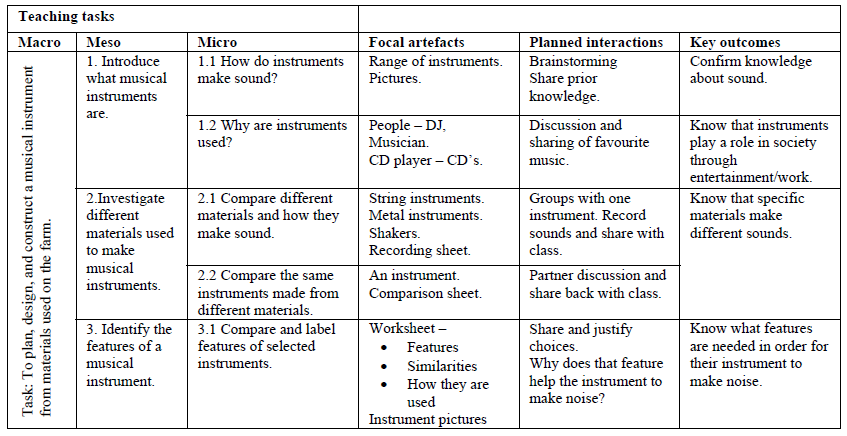
Each lesson was unpacked into meso and micro tasks. Figure 3 shows three lessons and these divisions, the focal artefacts, the planned interactions, and the key outcomes Jenny would look for. The division of the macro/main task into meso and micro tasks helped Jenny to articulate her PCK to structure the lessons so that links between lessons and within tasks were promoted (Moreland & Cowie, 2007). The linking between focal artefacts, planned interactions, key outcomes, and tasks indicated that Jenny had thought about ways to communicate to her students what she knew about musical instruments and how to make them, in forms that were learnable. For example, she planned for the students to examine real percussion instruments to discern their salient features before designing their own, as this task would help the students extend their knowledge about percussion instruments.
In looking across all our teachers’ technology planning we noted two aspects that demonstrated technology PCK:
- The development of a sequence of nested tasks with the potential to help students maintain a focus on the overall macro task whilst developing their appreciation of its inherent technological conceptual, procedural, societal, and technical aspects.
- >An explicit focus on helping students design, make, and test iteratively within a focus on the intertwined technological conceptual, procedural, societal, and technical aspects.
The science planning framework
Like the technology planning framework, the science planning framework had two layers. The first layer was the learning outcomes plan. This part of the planning framework helped the teachers to identify, clarify, and phrase science learning outcomes in a manner that would be appropriate for their students. It included a space for articulating the main (big) idea that was the overall purpose for student science learning. Another space was included for teachers to tease out the learning outcomes embedded in the main idea. The first layer also included spaces for unpacking and specifying four categories of more specific learning outcomes: conceptual, procedural, nature of science, and technical. Conceptual learning outcomes included knowledge and understanding of relevant scientific concepts and procedures. The procedural learning outcomes involved the strategic application of procedures and processes such as those used in science investigations. The nature of science outcomes related to, for example, what counts as evidence, and methods appropriate for the communication of scientific ideas. Technical skill outcomes related to practical techniques and equipment use. The specific design of this framework compelled the teachers to consider all categories, resulting in a broadening of the range of possible science learning outcomes and the articulation of specific science ideas.
Figure 4 is an example of the first part of a completed framework, developed by Lois in 2006 for her Year 1–3 students (ages 5–7). Her main idea was that fossils provide clues to the past. In the development of her specific learning outcomes in the four categories Lois had to think about her students and what would be appropriate for them. She knew there were fossils in the area and that many of her students had read in the paper that a child of their age had found a large fossil at a local beach. She used their curiosity about this event as a springboard to enhance the relevance of this unit. When Lois was undertaking her planning she identified specific learning outcomes in the different categories. In the articulation of these outcomes she was able to identify what she needed to know to teach and any gaps in her own knowledge. To help her close her knowledge gaps she did further reading, talked with the other teachers and consulted one of the research team about the development of scientific thinking around palaeontology.
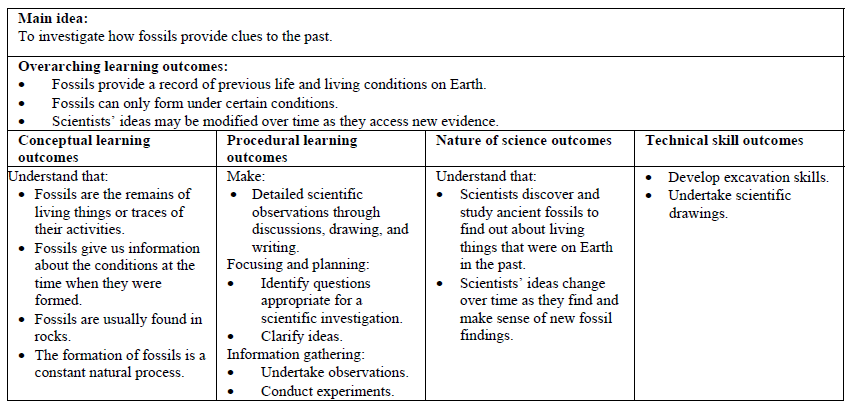
In Lois’ learning outcomes plan it can be seen that Lois has identified the main idea for the unit, which is the macro focus for her science teaching. Below the main idea are three broad science learning outcomes which clarify the macro focus. Specific learning outcomes in terms of conceptual, procedural, nature of science, and technical skills are defined for her own students.
The outcomes she has articulated indicates her PCK as she has transformed her understanding of fossils into language and concepts that her young students have the potential to understand. For example, “fossils are the remains of living things or traces of their activities”. It takes account of her expectations of what they can achieve and what she believes they already know. It also demonstrates the connectedness of science ideas as well as the way in which scientists work. Figure 5 shows the second layer of Lois’ planning. It details her teaching tasks plan for her fossils unit.
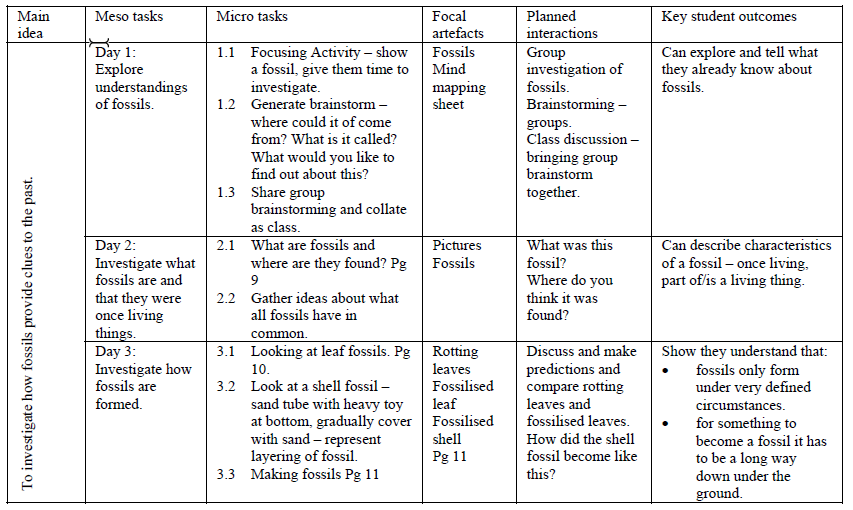
It can be seen that Lois unpacked the fossils main idea into meso and micro tasks associated with different understandings about fossils. She also detailed the associated focal artefacts, interactions, and key student outcomes. The articulation and linking between focal artefacts, planned interactions, key outcomes, and tasks indicated that Lois had thought carefully about the ways she could teach ideas about fossils to her students. For example, she planned an examination of fossil pictures and actual fossils as a means for her young students to develop beginning concepts about fossil characteristics, such as having been once living or part of a living thing. Note that the vocabulary Lois used to describe the concepts is at an appropriate level for her young students. This indicates that she knows that she needs to transform her understanding of the concepts into forms that are learnable for her students.
In looking across all our teachers’ science planning we noted two aspects that demonstrated their science PCK:
- An identification and distillation of a main (big) science idea and a concern to help students maintain a focus on this and its associated conceptual, procedural, nature of science, and technical aspects.
- The inclusion of strategies to help students undertake and evaluate an investigation that would contribute to their understanding of the main science idea.
Enhanced teacher planning for science and technology
This section presents evidence of the enhanced teacher planning in both science and technology from 2005 to 2007. Teachers’ planning is a representation of how teachers have transformed subject matter for teaching. It also illustrates how teachers think they will make the subject ideas accessible to their students. In other words, teachers’ planning reveals something of how they intended to organise, adapt, and represent subject ideas for teaching and learning for their own students. As part of planning the teachers include explanations, artefacts, representations, illustrations, models, examples, analogies, and demonstrations that they consider will best help their students engage in and learn the ideas they intend. As such, planning can be taken as a reflection of at least some aspects of teacher PCK. The changes in the InSiTE teachers’ planning indicate a development in their PCK over time, and particularly in relation to their understandings of the nature and structure of key ideas in science and technology and appropriate pedagogical approaches for their students. First we present Carol’s science planning from 2005 and 2007 to show her shifts in understanding. Second we present Lois’ technology planning from 2005 and 2006 to show her shifts in understanding. These two examples are representative of the shifts that all the teachers made during the project.
Shifts in teacher planning for science
When teachers prepared their science units in 2005 they typically specified the broad learning outcomes related to the science curriculum and achievement objectives. Specifics such as conceptual, procedural, nature of science, or technical learning intentions were often not identified. For example “investigate and report on temporary and more permanent changes that familiar materials undergo”, does not identify what particular changes, what materials, and the related science concepts. The teachers identified tasks for each lesson and the equipment and resources required. However, the links between the tasks and the learning intentions were not always made explicit. Initial teacher planning at that stage represented a very open approach to teaching science. Figure 6 shows the first lesson of Carol’s 2005 science unit on milk.
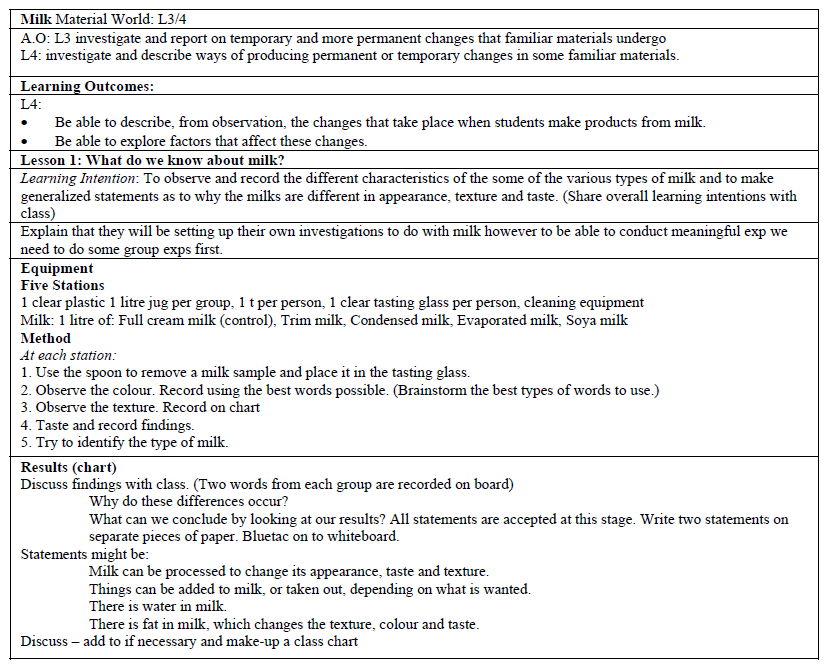
The example in Figure 6 shows that the teacher’s focus is on the general aspects of investigating and reporting. She has not specified the main idea she aimed for the students to understand, or the underlying ideas inherent in the main idea. Little attention was paid to articulating specific science ideas and skills and the methods for student development of these science ideas and skills. She has articulated the types of questions she wants the students to answer and the questions she will ask. However, the questions are of a more general nature. Carol’s own knowledge of science was extensive, as was her knowledge of science pedagogy. However, her knowledge of how to best teach these science ideas so her students could effectively learn them was less extensive.
Figure 7 shows the first layer of Carol’s 2007 science planning for a unit on adaptation in the context of a rocky shore. It details the learning outcomes she devised.
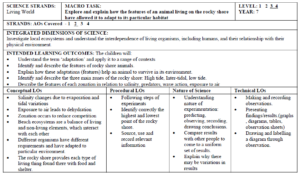
As she had in 2005 Carol identified the science strand (Living World) and her level focus (3 and 4). But from then on her planning has altered. She identified the main science idea related to adaptation for the unit. This was the macro focus for her science teaching—“Explore and explain how the features of an animal living on the rocky shore have allowed it to adapt to its particular habitat”. Below the main idea she specified five broad intended learning outcomes which clarify and unpick the macro focus and identify particular science concepts.
In 2007 the InSiTE teachers defined more specific learning outcomes in the four categories of conceptual, procedural, nature of science, and technical. The teachers also devised these outcomes in recognition of their students’ conceptual and procedural level of understanding and their skills. Figure 8 shows the second layer of Carol’s planning. It can be seen that she has unpacked the main idea of adaptation in the context of the rocky shore into meso and micro tasks indicating she had thought about how she would segment, sequence, and interrelate these tasks into a coherent and engaging learning experience. Carol has also specified the associated focal artefacts, interactions, and key student outcomes and formative assessment. Figure 8 shows the detail of the first meso task Carol had planned.
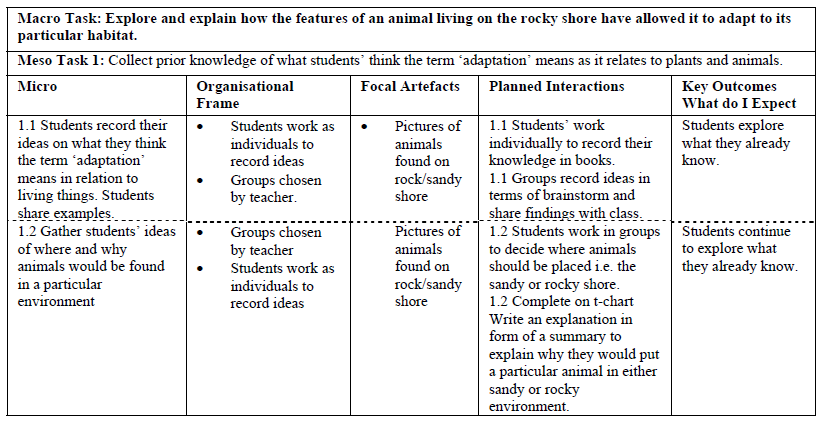
The articulation and linking between focal artefacts, planned interactions, key outcomes, and tasks in teacher planning sheets in 2007 indicated careful consideration about the ways science could be taught to the students so they could effectively learn these ideas. This was in contrast with the teachers’ science planning in 2005 where their planning was more general and focused on investigating and reporting without reference to specific science ideas. These changes in planning are indicative of changes in the teachers’ PCK in relation to knowing how to teach particular science ideas and concepts to a particular group of students.
Shifts in teacher planning for technology
Over the three years teachers also shifted their thinking of how to prepare and plan for technology teaching. The InSiTE teachers’ technology plans in 2005 tended to focus on broad achievement objects from the technology curriculum. The teachers’ planning did not identify specific technological knowledge and skills.
The example from Lois’ technology teaching plan designed in 2005 (Figure 9) showed that while she identified some aspects of technology they were not detailed in relation to her students. For example, it was not clear what Lois thought her students would understand by mock-up—whether it was a means to test ideas or a scaled-down replication of the real thing.
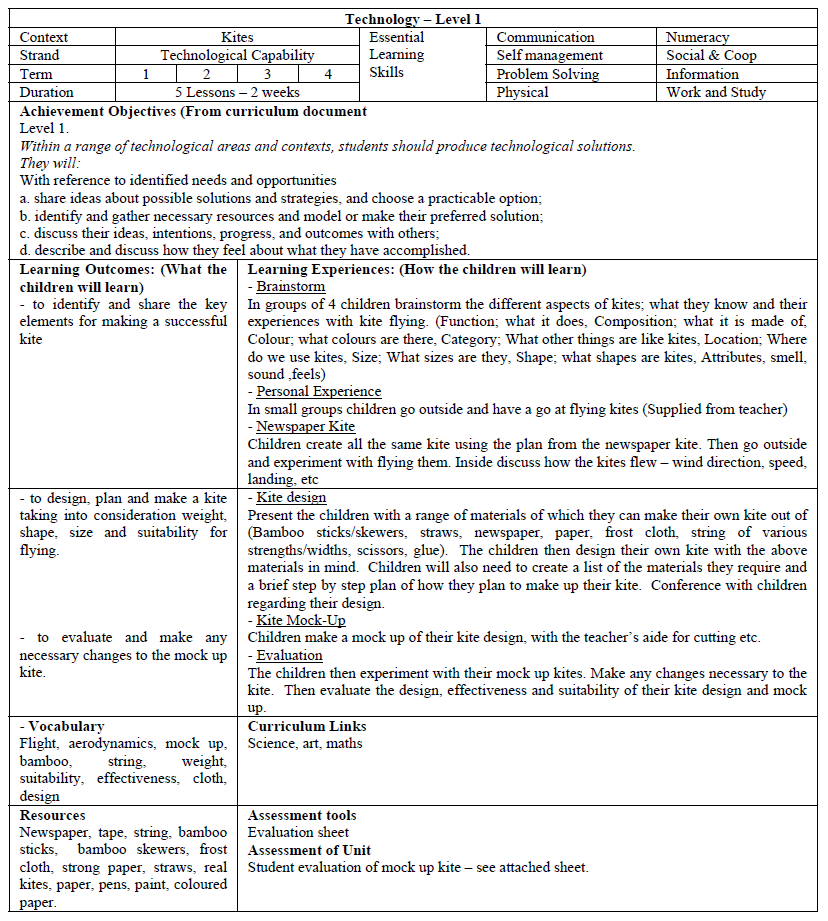
In 2006 Lois demonstrated more in-depth thinking in her preparation for a technology unit on designing a healthy snack (Figure 10). In contrast to her unit in 2005, she considered what her planned learning outcomes would mean to her students. For instance, she identified that her students would understand how a production line works, including the roles and processes of a production line, through the process of designing, producing, and evaluating a healthy snack. Figure 10 shows the first layer of Lois’ 2006 technology planning for a unit on healthy snacks. It details the learning outcomes she devised.
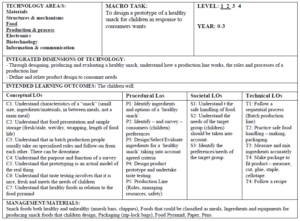
Compared with 2005 Lois has defined the technology learning in much greater detail and precision. She has defined the main (macro) task and this provides the overall direction for the unit. Below the macro task she has specified two broad technology learning outcomes in the integrated dimensions of technology space. These are: 1) “through designing, producing, and evaluating a healthy snack, they will understand how a production line works, including the roles and processes of a production line”; and 2) “define and relate product design to consumer needs”. These two learning outcomes unpack the macro task and identify technological concepts and procedures in a broad manner. More specific learning outcomes of a technological conceptual, procedural, societal, and technical nature are then defined. Conceptual learning outcomes include technological ideas about food presentation, food storage, batch production and taste testing; procedural learning outcomes include the procedures and processes of surveying and designing; societal learning outcomes specify the people and environmental considerations, such as the preferences of the target group. The technical learning outcomes specify the technical skills required, such as practicing safe food handling. These specific learning outcomes have been especially written for her year 1–3 group of students. For example, Lois has unpacked the concepts inherent in “understand characteristics of a snack” as “small size, ingredients/materials, in between meals, not a main meal”. This description of concepts within snack characteristics “fits” her young students. Lois’ extensive list of specific outcomes and the ways she has interrelated these with the integrated dimensions and the macro task description demonstrates her understanding of technology as multidimensional. It shows the depth of her PCK because it shows how she has thought about the ideas and skills she intends her students to learn in ways that they can understand. This is in contrast with the 2005 example of mock-up.
Teacher feedback on using the planning frameworks
The two-layered planning framework helped our teachers identify the science and technology ideas and skills appropriate for their students, the knowledge they needed in order to teach, and the appropriate pedagogical approaches for teaching the ideas and skills. By working iteratively between the two layers of the framework the teachers developed and refined their PCK prior to, and in preparation for, teaching in the classroom. The framework structured and supported indepth collaborative discussion and analysis of what might be required to teach and learn a particular science idea and a particular technology task.
The teachers saw that their rehearsal of tasks before they began teaching was useful for developing their PCK. Such dry runs enabled them to explore the knowledge, understandings, and skills most salient in the tasks; to assess the appropriateness of the tasks for their students; and to foreshadow potential problems.
It was good that I tried out how to make cheese at home before I had the children try this. I found how long it would take and I thought about easier ways they could do it. (Brenda)
They also commented on the benefits of thinking about and planning for interactions, including the sorts of responses their students might make. Such forethought meant that they could optimise learning within their AfL interactions with students.
It made me think through each stage thoroughly instead of always having to think on my toes, which can often mean missing good opportunities, or not choosing the best way to do something. (Jenny)
In our final meeting for 2007 teachers acknowledged that they now understood the frameworks better and their use had impacted on their teaching of science and technology.
I aim to keep my planning thorough and really get into the terminology and ensure the children are learning the best ‘correct’ explanation or method for things that suit their learning needs. (Brenda)
In 2005 I was not ready for this. But now I am. I want to try them again next year. (Carol)
Several teachers found the frameworks so worthwhile that they had introduced them to colleagues in their schools. They commented on how these colleagues were also finding them useful, as they helped them focus on the ideas and skills they wished their students to learn.
The planning frameworks have helped me with my thinking. I think they are very worthwhile so I have introduced them to two teachers in my team and they are using them for their teaching of science. (Carol)
I’ve used the planning frameworks as scaffolds with my team in 2007. They helped them to understand the ideas in their science teaching. Before they wanted to only plan activities. I used the same process as you did and the teachers changed in their planning from focusing only on the activity to focusing on the science ideas, such as germination in plants. (Tayla)
Considerable skill and knowledge are required for planning in this way and teachers require time and support to understand how to use it in a beneficial manner for student learning. Despite this limitation our teachers believed that the benefits outweighed any negatives.
My in-depth planning in technology produced the best teaching I’ve done all year. If I went in that depth for everything, my teaching would be better. It helps me know exactly where we’re going, what to do and what questions to ask. (Jenny)
It is time-consuming to think it all through, but I like working with it when it’s done. It really helps me remain focused on what I should be doing. It helps me make connections for students and the students for themselves. (Tayla)
Teacher–researcher meetings
Teacher–researcher meetings which included opportunities for professional development and reflection were another source for developing teacher PCK. These meetings were held several times throughout the three years and always after the teaching of science and technology units. The meetings were used as a forum to discuss the developing research findings. This meant that the teachers were informed of our developing theoretical ideas and we were able to find out their reactions to these. We were all able to consider how the teachers might use the ideas in their teaching. Because there was always time to discuss these findings in the light of teachers’ classroom experiences and against the backdrop of the InSiTE project, the teachers could make informed decisions about the degree to which they would incorporate the findings into their next teaching cycle.
Conversations between the teachers and between teachers and researchers were important for helping to tease out the learning outcomes and the associated pedagogies in the unit the teachers planned to next teach. It was important to talk about what worked or did not work. It was in these discussions that teachers used each other, and the researchers, as sounding boards about the effectiveness of the ideas they were planning for their next teaching. Some used the planning from another teacher as a basis for their planning. For example, Tayla used Jenny’s technology plan for making musical instruments as a basis for planning her unit on making musical instruments. However, because of the conversations she had with Jenny where Jenny indicated that the unit might have been more successful if her students had understood how musical instruments can be modified to produce different sounds, Tayla focused more intensively on developing students’ ideas about sound before they embarked on the development of musical instruments. As her students were older that Jenny’s, and some had already had the experience of making musical instruments the previous year, she altered Jenny’s unit to include a greater range of instruments. Jenny planned for her students to develop either an idiophone or a membranophone, whereas Tayla’s students chose to develop idiophones, membranophones, electrophones, chordophones, or aerophones.
In another example Lois planned a technology unit for her Year 1–3 students where they developed a kite. Jane also taught young students, Year 1, and so she took Lois’ plan and adapted it. A minor but significant change came about because of teacher and researcher observations and discussion. When Lois was teaching the unit her students had considerable difficulty with the technical skill of cutting the material for the sail of the kite. We talked about the need for students to cut—was this a skill that needed to be a student learning focus in the context of the whole unit? We concluded that it was not, that other learning outcomes were more important. Therefore, Jane prepared the sail material beforehand, thus eliminating the time-consuming task of cutting. In both of these examples, the teachers developed their PCK about specific aspects of teaching technology through discussion with trusted others. Talking about what worked and did not work in classrooms was a source for developing PCK as several teachers commented:
Planning together meant our units were more thought through, so therefore it was better for the students. (Jenny)
The time to plan at the workshops, and having everyone at the meetings as resource people, were great. (Brenda)
From our meetings I have valued the time to plan and think in-depth about how to teach a unit and the sharing of ideas. (Jane)
In the meetings we discussed PCK as a theoretical idea because we thought that this would be a worthwhile way for teachers to think about their own knowledge development and teaching. Towards the end of the three-year project we asked the teachers what came to mind when they thought of PCK. They all talked about its importance. For example:
It is the essential stuff that helps us teach. If you have a good understanding you can help someone else get a good understanding. You can help them make connections much more than if you don’t have PCK. (Tayla)
PCK is the knowledge that I bring to the task, lesson and/or content of what I am doing. It can be information, ideas, and skills. It’s marrying those up and being able to help students develop their own knowledge and skills. It is about me using my knowledge to help students learn. (Carol)
PCK is what a teacher needs to know to effectively teach a unit. It is about teacher prior knowledge and I have to understand the ideas and how to teach these. (Gail)
I have to know how to teach the concepts to my children. (Jo)
The teachers came to understand that PCK was about them knowing the ideas and concepts so that they could teach them to their students. They emphasised that coming to know the ideas for teaching was an important step in the teaching process. As Jo and Tayla commented:
I have to be able to grasp the concepts and learn about what I want to teach before I teach them to my children. (Jo)
I have to find out to get a better understanding of the science concepts for teaching. Then I can help students in class understand the concepts. (Tayla)
In the teacher–researcher meetings we also examined and analysed portfolios of student work that were produced in our teachers’ classrooms throughout the three years. Examining student work proved to be another source for developing teacher PCK. When they looked at each other’s student work and talked about it they thought of their own students and how the work related to their students. They made comparisons between the different students, projecting where their students might go next and reflecting on what they may have accomplished as younger students. Their examination of student work helped the teachers to imagine possible before and after learning accomplishments for their students. Class portfolios of student work helped the teachers “see” student-learning progression. Student work became a site and a tool for meaning-making conversations. Portfolios of student work from Years 1 to 8 science and technology classrooms enabled the teachers to discuss concrete examples and thus to better “see” the science and technology ideas inherent in this work.
PCK in action and interaction in primary classrooms
Atkin and Black (2003) pointed out that “What really counts in education is what happens when teachers and students meet” (p. ix). Teachers can reflect to distil what they know about how to teach a particular idea to particular students, but this knowing gains authenticity through action and interaction in the classroom. PCK is put to the test in the classroom. A rich and flexible PCK is required for teachers to be able to respond to the learning of diverse students in the moment. In this section we describe and discuss examples of teacher–student interaction in the classroom, where teacher PCK was highlighted. First we give two examples to illustrate teacher science PCK in action in the classroom. Second we describe two examples to illustrate teacher technology PCK in action in the classroom. In each example some contextual information is provided to help locate the example within the teaching sequence we observed.
Clarifying subject matter: solids and liquids
The first example is about solids and liquids. It is from the classroom of Jane and her Year 1 students (age 5). It illustrates how our teachers juxtaposed and juggled demands from various subjects to enrich their students’ learning experiences. Jane partitioned the lesson into several tasks to help her students understand the concepts of wet/dry and solid/liquid. First Jane made vanilla biscuits with her students to help build their understandings of wet and dry, solid and liquid. Jo chose to make vanilla biscuits because she knew that she could expand her students’ language experiences at the same time as helping them to think about wet/dry and solid/liquid. V had been “the letter” of the previous week and very few of the students had known what vanilla was. Having reminded the students that they had been interested in what vanilla was, she explained that they were going to make vanilla biscuits as part of their science unit.
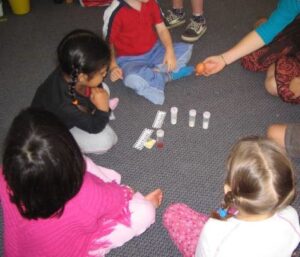
She first handed around small plastic vials of flour, sugar, baking powder, and vanilla and gave the students time to look at, feel, and taste them. There was also a small pat of butter and an egg for the students to look at. Next Jane handed out two labels—one said “wet” and the other “dry”. She asked the students to sort the ingredients accordingly (see Figure 11). She knew her students could sort into either/or categories when they used real artefacts for categorisation. Later she asked them to sort the ingredients into solid and liquid. With the exception of the egg the students had no difficulties categorising the ingredients. They debated the placement of the egg, with different students moving it back and forth between the solid and liquid labels. When Jane noticed this she asked the students to explain the basis of their dilemma. The students pointed out that the eggshell was solid, but they knew the contents were liquid. In a later interview Jane explained that she had deliberately “planted” the egg knowing that it would generate debate. As she had planned, the dilemma of where to place the egg stimulated active student engagement and discussion around the distinction between, and definitions of, dry and wet and later liquid and solid. Jane’s intervention in discussing the egg placement with the class ensured all the students were aware of the dilemma it posed and that the talk evolved in the direction of her intended learning (to think about the differences between liquids and solids). In this example, the depth of Jane’s science PCK for the teaching of these concepts to very young students was evident in the synergy that emerged between the task and the focal artefacts, the students, and the science ideas of solid and liquid.
Partitioning subject matter: a series of circuit activities
The second example is from Brenda and her Year 4/5 class (ages 8 and 9). They were investigating electrical circuits in the context of designing a light tower for a model of a theatre. At the time the school was rehearsing for a school production. Brenda wanted the students to appreciate what was required to make a circuit. She asked the students to experiment with a number of bulbs and batteries. To ensure some continuity between the trials they undertook to determine what “worked”, she set up a series of activities to establish the need for a precise record that could be understood by others. Initially she asked the students to set up and draw a picture of a working circuit of a bulb, a battery, and wires. It became evident that there were two possibilities: the one-wire version and the two-wire version. The next day, when the students sought to replicate each other’s circuits as represented by their drawings, they had difficulty following the drawings because of the imprecise way the students had represented the connects with the bulb. This situation led to a productive discussion on the parts and function of the bulb. The students’ drawings were also used as artefacts to focus group and class discussion of ideas related to circuits.
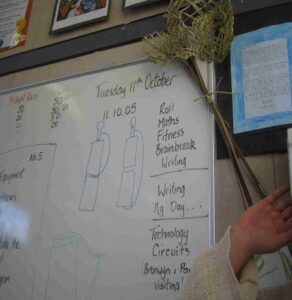
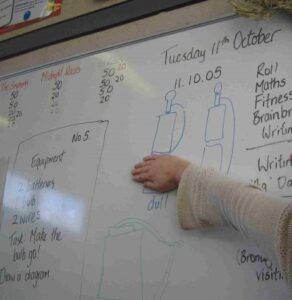
As shown in Figures 12 and 13, Brenda reproduced versions of student drawings on the whiteboard to focus discussion on the implications of the different drawings. In this instance, she highlighted the significance of the different physical arrangement of the batteries and wires for the brightness of the bulb. Brenda asked the students to swap drawings of working circuits. The students struggled to set up the circuits as shown in the swapped drawings. This brought home the need for a commonly understood convention for representing electric circuits. The issue of representation was exacerbated when the students worked with more batteries and bulbs. Only when she had raised student awareness of the need for a concise convention did Brenda introduce how electricians draw circuit diagrams. The students then readily adopted this convention for their own light tower circuit design diagrams. Brenda commented that this entire sequence of tasks had been deliberate: Brenda’s science PCK was evidenced in her sequencing of the activities to generate the need for a convention for representing an electrical circuit. It was also evident in her pacing of the activities; she needed to balance student frustration with student interest in pooling ways of making a working circuit.
Examining real artefacts: understanding the relationship between the parts of a xylophone and functionality
The first example in technology is from Tayla and her Year 7 and 8 students when they were involved in creating musical instruments from recycled farm materials. Before the students designed their own instruments, Tayla had them examine a variety of existing percussion instruments to discern their essential characteristics and parts. What was important was that the students understood how the various parts of each instrument related to their functionality. First Tayla instructed the students to “have a close look at your instruments so that you know the parts and how they are attached, know the materials used, and to find out about how they produce sound including different pitch. You will be building up ideas about these instruments to help us design our own instruments”. Next she provided each group with a worksheet to direct the students’ examination and analysis. The students were prompted by instructions on the worksheet to name, and classify, three different percussion instruments. Then for each instrument, the students were to identify materials, parts, and size; describe how each instrument made sound; identify loudness levels; and identify how to change the pitch. Tayla had selected a large range of percussion instruments that she thought her students could make. From this collection the students chose their three instruments to examine, one of which was the same as the one they would most likely make. Three boys chose a xylophone as one of their three instruments. They examined and discussed the xylophone in their group using the worksheet to guide their examination and as a prompt. They concluded that the xylophone had a number of graduated tubular keys, a pin for each key to fit on to help keep it in place, a horizontal rack on which the keys rested and a hard mallet for striking the keys. They recorded these ideas on their worksheet. When they got to this point in their analysis, Tayla came to talk with them to check their progress.
Tayla: What parts has it got? I see you’ve written down ‘keys’. I’m presuming when you talk about keys you’re talking about the bars?
David: Yes, the metal bars.
Tayla: If I take off a few of these, [bars] do you see any additional parts that you didn’t see before? [Tayla lifts several bars off their pins].
Tim: Yes, [points to material winding through the pins on top of the wooden rack] this ropey bit.
Tayla: There must be a reason for that being there? It looks like a shoelace.
David: Perhaps it’s got something to do with the sound.
Tayla: Mmmm. And you’ve got these here [points to dividers on the rack on the opposite side from the pins] to keep the bars separated and in place. So you will need to write those parts down too, because if you’re going to make one, you’ll need to know the parts to include so your instrument will make good sound.
In this conversation Tayla knew the correct terminology and she introduced it to the boys (bars not keys). She encouraged the boys to look more deeply than just at the surface features by taking apart the xylophone and asking them if they could “see any additional parts that you didn’t see before”. When Tim noticed the material that lifted the bars off the rack, Tayla wondered out loud about its purpose. Her deliberate tactic of sharing her perplexity about this material encouraged David to surmise that it might be related to sound in some way. Tayla responded vaguely so that the germs of this idea were kept open. Next she pointed out the dividers that kept the bars in place and separated from each other. This prompted the boys to examine this feature. Tayla concluded this part of her conversation with the boys by indicating the importance of noting all the parts of a xylophone so that they would be more likely to produce a successful instrument. Her technology PCK was evident in how she knew that technological development is often based on knowing the constituent parts of the artefact for development. Her technology PCK was also evident in how she helped the students carry out the examination by the use of a worksheet she devised that focused their attention on the salient aspects. As well her technology PCK was evident in action when she supplied the boys with the correct terminology and how she directed the boys to look in more detail so that they could discern less obvious, but significant, features of the percussion instrument that would impact on the functionality of the instrument. Her actions and conversation demonstrated that she understood the need to know about functionality of an instrument so that it would work. Her actions and conversation also demonstrated that she understood the need for the boys to know the salient percussion instrument aspects to design a functional instrument of their own.
Making connections: understanding technology as a long-term activity
The long-term and multidimensional nature of many technology tasks means that students may struggle to see the connections between days, between activities, and between ideas. Teachers therefore need effective technology PCK in order to help students build continuity and coherence. One way they do this is to structure lessons so that they take the time to make links between lessons. We have found in our research that if they also focus on the technology aspects during these times when they help students to make links, students are likely to make effective connections. This second technology PCK example is from Ellie and her Year 3 and 4 students creating masks for their school production. For each of the five days that Ellie and her students worked on this technology task, Ellie opened and closed every lesson with a whole-class discussion. Beginning lesson conversations focused on two aspects: first, she orchestrated class conversations to look back at what had already been achieved; and second, she introduced the tasks and ideas for that day. End of lesson conversations also had two aspects. First, Ellie orchestrated them so that the tasks and ideas for that day were reviewed. Second, Ellie and the students talked about what might happen the next day. For example, at the beginning of the third day Ellie asked the students to recall the ideas and tasks from the previous day. She also introduced the task and ideas for this third day:
Ellie: Today we are going to carry on with our ideas about masks. Can you tell me about your sketching from yesterday? What does it mean?
Tama: It doesn’t need to be good. Paru: It’s fast, and quick pictures.
Ellie: Aye [yes]. So what did you sketch?
Tama: We sketched pictures of the mask we are going to make.
Ellie: Aye, kapai (good). You did sketches of the masks you will make, so you could decide on what you might make a mask of, and how they might look. Today we’re going to go on from there and take a look at the specifications your mask will need to have. We’ll talk about the specifications now. What do you think this big word might mean?
This dialogue first allowed Ellie to check on student understandings about sketching from the previous day. She reiterated the purposes of the sketching—to decide on aspects of functionality (which materials for making) and to decide on aspects of form (how they might look). Her welldeveloped technology PCK meant that she focused on both form and function, the two cornerstone ideas in technological development. She then introduced the task for the day—to look at the specifications. But she did not expect her young students to understand specifications, so she made space for a conversation about the idea of specifications. Using phrases like “Today we’re going to go on from there” helped make visible to her students the connections between tasks and days. Her students were helped to see how the tasks they were undertaking linked to each other and contributed to the overall macro or main task. Students were able to build a sense of connectedness and continuity across the technological ideas and activities. Because she encouraged her students to think ahead to next steps and to think back to what had happened and what they learned, the students had opportunities to monitor their technology ideas and progress over the course of the five days of the unit.
Teacher comments about PCK in action and interaction in classrooms
In interviews at the end of 2007 the teachers gave examples of when they thought they had been effective in teaching particular ideas in science and technology. For example, Jenny gave a science example for teaching her Year 4 and 5 students about sound waves and how she helped them to understand that sound travels. She said:
The sound waves activity was an example that was particularly effective for teaching the fact that when sound is travelling, it may take a while to get from one place to another. We took a big drum out on the field and got a kid to run across to the other side of the field and we watched him bang it and then we heard the sound come. I think that just really helped them to get the idea that you can see someone hitting the drum before you hear the sound. That means sound has to be travelling. Whereas when you’re sitting next to somebody it comes straight away and it is hard to hear the gap between the hit and the sound. You know the fact that we actually demonstrated that. First we sat next to somebody and then we went all the way across the field. They had an absolute ball but I think that’s something that they will remember … I think it worked because it was so visual … because the drum was big and so they saw it really well and it just cemented that idea … The fact that they could show their classmates sound travelling in a visual way as well helped them to grasp that concept and kind of take it as truth. Whereas if I’d just told them it, they probably would have understood it, but it wouldn’t have been so connected.
By Jenny using comparative examples her students could see and hear the difference between the two and thus understand that sound travels. In another example, Jane demonstrated her technology PCK when she talked about teaching sound so her five-year-old students could make musical instruments that would work. She said:
The musical instruments and sound activities were an example for helping the children understand a little bit about sound, so that then they could create a more effective musical instrument. I didn’t go into sound particularly deeply because I decided that it was quite a complex topic to teach and five-year-olds actually need a lot of concrete rather than abstract things for their learning. To me sound is a little bit too abstract, so I just did one or two little experiments like a thin piece of bamboo and a thick piece of bamboo and listening to the different sound. And we had a violin and a cello and talked about why the sound might be different. And when the children made the musical instruments and they did a selfreflection, they did things like, ‘If I had used a bigger piece of bamboo the sound would be better’, or ‘If the strings on my guitar were tighter it would make a better sound’.
In this example, Jane demonstrated her PCK by giving her reasons for not dealing in-depth with the science of sound when teaching young students. She knew to teach some aspects of sound by fostering the students’ understanding of sound in the context of designing workable musical instruments. The tasks she designed for her students were appropriate for students aged five years. The tasks assisted the students to clarify the subject matter in enough detail for them to then apply these science understandings to their technology task.
The teachers also talked about having more confidence and knowledge to respond constructively to student science and technology understandings when they were teaching. They commented that now they deliberately planned to interact with students and question them with the intention of enhancing their learning.
Previously I would have thought that just getting an answer from them was OK, now I challenge them in their actual understanding. (Brenda)
My questions got them to think about things, their ideas, so they could change them on the way. They could improve while they were going. (Carol)
They indicated that they had changed their interactions to be more focused on science and technology. They indicated that clear planning helped them to stay focused on the topic.
When I was teaching I could see the benefit of having a clear outline of what I wanted to achieve. It stopped me from going off the point and the children from doing the same. (Lois)
A few years ago when I was teaching older kids, the Year 6 and 7s, I did a flight unit. It was very much facts. ‘This is a fact. This is a fact. This is a fact. This is a fact. I imparted that knowledge’. We did lots of activities, but it was like, ‘This is the way it works and if your balloon activity where you were making a balloon travel along a string with a straw didn’t work, well then that’s because you didn’t set it up properly’, as opposed to, ‘Well, can we think about why that didn’t work?’ Whereas now, if I was doing the same type of thing with these kids, we would be more investigative about why it’s not working. Is it because we didn’t set it up properly, or is there something else that might be affecting that? … It doesn’t matter if it’s not right. It doesn’t matter if it doesn’t turn out the way that I thought it was going to. I think I’m more confident to interact with the exploring of things and interacting with the kids about the ideas. And if they say, ‘Oh, it’s wrong, it doesn’t work’, then that’s okay. We’ll work on the science aspects. (Jane)
The teachers discussed their plans as an important reference during teaching, describing them as both a memory aid to their keeping in mind the overall pathway for student learning and a support mechanism for their actions and interactions in the classroom.
I often had the plan beside me when I was teaching. I used it a lot. It clearly marked where I wanted to take the children with their learning and what I would need to do to get them there. (Lois)
I used the plan throughout the unit. It ensured I didn’t miss any important teaching points or stages and I felt comfortable knowing that I could refer to it for confirmation of terms and procedures. (Gail)
The teachers were emphatic that detailed planning did not lead to them constraining student learning possibilities but rather allowed them to respond flexibly to student ideas, interests, and demonstrated skills.
Concluding comments on teacher PCK
Science and technology are compulsory curriculum areas in New Zealand primary schools. Many primary teachers acknowledge that they find teaching science and technology challenging, although they are confident in other areas of the curriculum such as literacy and numeracy. Making explicit, and developing, teacher science PCK and technology PCK is not a simple matter. The InSiTE project has highlighted the importance of working with primary teachers to identify, articulate, and build their science and technology PCK. Teachers need to employ an intellectual process to translate their content knowledge into forms learnable for particular students and to transform generic pedagogical practices to help their students learn science and technology. The use of the two-part planning framework that identified key features of each subject supported this process. The planning framework, like other artefacts, provided a scenario and resource for individual and collective reflection, analysis, and interaction (Roth et al., 1999). The framework focused our teachers on analysing their own and their students’ understandings. The framework was pivotal in helping our teachers bring to mind, refine, and develop the PCK they needed to effectively interact with students. The framework also became a tool for collaborative talk that supported the articulation and development of PCK. By preparing appropriate materials and setting tasks with clear objectives in meaningful contexts our teachers were able to respond flexibly to their students’ developing ideas, interests, and skills.
The repeated use of science- and technology-specific planning frameworks over the three years helped our teachers translate their science and technology content knowledge into forms that were learnable for their students, helped them to formulate science- and technology-specific teaching approaches and tasks, and enabled them to anticipate and respond to student learning difficulties. The teachers’ science and technology PCK was further developed when they used their plans in their classrooms, for it was then that they used their PCK in action, especially in their AfL interactions with students. Their science and technology PCK was refined again when our teachers reflected on what had occurred in the classroom in comparison with what they had anticipated when they planned. The subject-specific planning frameworks also mediated ongoing thinking and discussions between teachers and researchers about the nature of PCK, and so contributed to broader understandings of science and technology PCK.
Effective AfL interactions are shaped and underpinned by teacher PCK. Teachers used their plans and developing PCK to help them make decisions in real time and across contexts. However, teacher planning shaped and framed, but did not predetermine, what happened in their classrooms. Teachers reported they were more certain they could tease out relevant concepts and principles when interacting with students. Undertaking the planning process we have developed enhanced our primary teachers’ science and technology PCK and associated AfL practices.
Classroom interactions
In this section we focus on the project aims and questions to do with developing an understanding of, and enhancing, teacher and student interactions around the ideas and practices of science and technology. Interactions around ideas provide opportunities for teachers to assess and respond to student learning, and so they fit with the intent of AfL. We were interested in what afforded and constrained these interactions, and the perspectives students and teachers held about interactions that support student learning. Hence, our focus in this section is on the joint contribution of teachers, students, tasks, and other aspects of the material and social setting interaction and the ways AfL was accomplished. The InSiTE teachers planned and prepared tasks to guide and direct student learning, but what students had an opportunity to learn depended on how, why, and with what effect student and teacher interaction established a task as a joint activity with particular conceptual, procedural, societal, and technical aspects, and spatial and temporal boundaries.
A focus on learning and knowing as embedded in interaction is consistent with the sociocultural view of learning that underpins our work. Broadly speaking, sociocultural views of learning consider knowing and learning as emergent and so needing to be investigated and understood in terms of the dynamic and evolving relations and interactions between people, artefacts, social configurations, and physical arrangements (Rogoff, 2003; Roth, 2005).
We begin this section by providing evidence of interaction as a multimodal activity that incorporates the use of talk, written text, action, and the visual mode to express and make meaning. Next, we describe and discuss the role of artefacts in providing a scenario and as resources for interaction. Finally, we explicate the social and relational aspects of interaction and foreground the way those patterns of interaction that are in regular use in a classroom afford, or not, the distribution of authority and student exercise of agency. How authority was distributed and agency was achieved within and across interaction had implications for the construction of what it meant to learn, know, and do science and technology, and subsequently the opportunities students had to exercise agency and engage in assessment for learning. It needs to be pointed out that the examples included here are indicative only of the ways interaction played out in the InSiTE classrooms.
Multimodal interactions in the InSiTE classrooms
Recent studies in the sociology of science and technology have highlighted the extensive use scientists and technologists make of visuals, graphics, diagrams, and formulae, artefacts, tools, and talk in the expression and development of scientific knowledge and technological solutions. These studies have also illuminated the role of consensus in the validation of scientific and technological knowledge and practices. Nonlinguistic resources such as gestures, actions, artefacts, and pictures are commonplace in everyday interaction. In contrast, classroom interaction research has tended to foreground the role of talk (Lemke, 1990; Mercer, 1995). The role of the visual, action, and artefacts in classroom interaction has been overlooked and underplayed, perhaps because of the ubiquity and everydayness of these aspects. Classroom studies in science and technology education are only just beginning to explore teacher and student use of multiple and multimodal resources for meaning making and communication (Cowie & Moreland, 2007). In science education, for example, Kress, Jewitt, Ogborn, and Tsatsarelius (2001) provide a detailed account of how a science teacher used gestures, drawings, a three-dimensional model, and images to demonstrate the circulation of blood to students (see also the work of Prain and Waldrip, 2006; Roth, 1994, 2005; Tytler, Peterson and Prain, 2006). In technology education, McCormick (2004) illustrates the way the specifics of the technology task along with the available resources shaped what students learned and did. Our data suggests that New Zealand primary teachers and students make extensive use of multiple modes in the teaching and learning of science and technology. The InSiTE teachers and students used talk in conjunction with written text, visual materials, gesture, demonstrative actions, and the manipulation and production of objects and artefacts to express and develop science and technology ideas and practices. Teacher and student talk played a pivotal role in interaction, but their talk was invariably anchored and augmented by other modes. In this section we provide examples to illustrate the multimodal nature of interaction in the InSiTE classrooms, beginning with a discussion of the interlacing of writing and talk.
Augmenting talk with writing
The InSiTE teachers asked students to record their ideas in writing at the end, and sometimes at the beginning, of a task or lesson. The early years’ teachers provided support for this process by requiring the students to write a group response or by annotating a student’s writing in discussion with the student. The older students were able to record their ideas this way much more independently, although teachers often posted a list of the terminology associated with the topic under study. When the teachers orchestrated whole-class talk they almost always inscribed aspects of student contributions on the whiteboard or newsprint sheets, whichever they used.
This example illustrates how a record of student talk supported independent student synthesis and analysis of ideas. It took place during the first lesson in a science unit on force when Brenda introduced the notion of a force as something that caused motion. To introduce this she modelled moving a pencil, a table, and a ruler using exaggerated movements. As she did these actions she questioned the students about what she was doing to cause movement. One student recorded other students’ suggestions on the whiteboard. These suggestions included pushing, blowing, kicking, hitting, and so on. At the end of this teaching sequence there were five lists of movement actions recorded side by side on the whiteboard. A student then called out, “Miss G they all have ‘push’ in them”. Brenda picked up on this comment and asked the students to consider to what extent the written movement actions involved pushing. The class concluded that most did. Another student pointed out the movements also involved a pull, “the opposite of a push”. Brenda reinforced these two observations and then told the class that the scientific definition of a force was that it is a push or a pull. In this case, the written record of suggestions allowed the first student to look across the movement actions to synthesise and conclude what they had in common. Without the written record it seems unlikely that this student would have been able to reach this conclusion.
Augmenting talk with a written record multiplied the meaning that the students were able to distil from the activity, allowing Brenda to draw their ideas into the lesson to develop a definition. By providing a durable trace of activity and thought, writing affords a reflection on, abstraction, highlighting, and co-ordination of salient aspects of tasks and ideas under investigation to support student meaning making.
Augmenting talk with drawing
The InSiTE teachers and students made substantial use of visual materials and the visual mode in teacher–whole class interaction, teacher–group and individual student interaction. The earlier example from Brenda’s unit on designing and making a light tower illustrates how a productive interplay between talk and drawing can provide a forum for shared meaning making. Brenda used student drawings to develop student science understandings of the requirement of a complete circuit. Brenda used the difficulties the students had in interpreting each other’s drawings to generate the need for a shared means for representing electric circuits, thereby introducing students to the wider issue of how and why scientists work to develop taken-as-shared understandings and representations. Student drawing served to bridge and mediate their learning about the convention for representing an electric circuit.
Drawing also played a role in developing student understanding and abilities in the practices of representation in technology. Students produced a drawing as an initial representation of their ideas for a technological solution as part of the design process in all of the technology units we observed—Jane’s new entrants drew the steps involved in making a kite, Gail’s students drew the lunch box they were developing to keep their food fresh, and Ellie’s students produced drawings of the masks they intended to make for a school performance.
Drawings provided a forum for discussion and teacher feedback. This is illustrated in this example, which is a continuation of the earlier example of Tayla’s interactions with Tim, David, and Garth. Tayla’s students were designing a xylophone from recycled farm materials. She had explained to the class they needed to include concise construction steps and simple annotations in their design plan. This plan was to be their blueprint for construction. Figure 14 is of the boys’ final blueprint drawings. The boys produced the drawings labelled 1 to 3 unassisted by Tayla. The drawing labelled 1 shows two rectangles of different sizes indicating the different sizes of the wood they were going to use for the xylophone’s wooden rack. The annotation “cut to match other end” indicated their intention to saw the wood the same length. The drawing labelled 2 shows four rectangles depicting the four pieces of wood for the xylophone rack, now the correct size. The dots on the rectangles show the nails already in the wood. The annotation on drawing 2 is “take out nails”, indicating the boys’ intention to remove them.
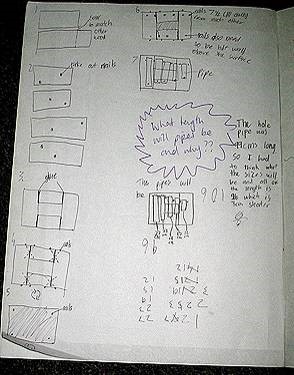
Figure 15 is of drawing 3 shown in close up. It shows the boys’ top-down view drawing and their rectangular placement of the four pieces of wood, the label glue and lines leading from this label to thickened lines indicating where they will place glue. Tayla came to the boys when they had just completed this drawing.
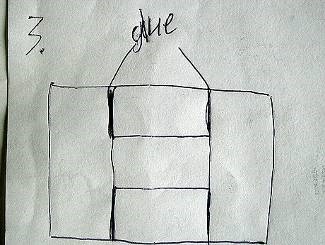
When Tayla looked at the boys’ drawings she saw that the boys had decided to glue the joints and that they had not included any detailed construction steps. The following dialogue demonstrates how she helped the boys think through the construction steps with reference to their drawings. It also shows how she led them to think about using more than glue to secure the joints.
Tayla: Remember you need to outline your equipment and your construction steps. Talk me through your steps bit by bit.
Tim: First off we’re going to cut this piece of wood, so it’s the same size as that [points to drawing 1].
Tayla: Right, that’s your first step.
Garth: Then once it’s like that, we’re going to take out all the nails [points to drawing 2].
Tayla: So that’s your second step—take out the nails. … We’re cutting the wood. We’re taking out the nails; that’s the second step.
Tim: [Pointing to drawing 3] Once it’s like that, we’re going to get a hot glue gun to join it.
Tayla: A hot glue gun! Why a hot glue gun?
David: We’re going to ask Mr. T about what might be the best connection.
Tayla: The best connection. Just one thing, what do you think makes the best connection for wood and wood?
Garth: Nail the ends.
Tayla: Nails.
David: So, we’re going to put glue in there, as well as the nails.
Tim: It’s like so it will stick together better.
Tayla: Make it stronger, robust, really strong, really robust.
Tim: Yeah, we’ll put in the glue; then nail it.
In this example, the combination of talk, drawing, and gesture were pivotal to Tayla and the boys coming to understand each other’s ideas related to a robust join being “more than glue”. The drawing process provided a forum for the boys’ discussion of how to proceed with the production of a xylophone. The drawings as a record of the boys’ thinking in Tayla’s absence provided her an entry into their thinking. Tayla was able to probe what would be “the best connection for wood and wood”. The drawings then served as tools that contributed to developing the meaning of robustness that came to be taken-as-shared by Tayla and the boys. In this case it was glue plus nails so that the wood “will stick together better”.
This example illustrates the potential of drawing to anchor and augment talk to support the development of a shared understanding of the intent and potential limitations of a particular design. It also illustrates how student drawing can support teacher provision of meaningful (and useful) feedback, leading to the expansion of student solution approaches. The necessity for a conversation to involve more than talk is evident in this example, which was just one of many occasions where the InSiTE teachers augmented talk by drawing themselves and/or asking their students to draw and explain ideas in both science and technology.
Using visual materials to anchor and augment talk
The InSiTE teachers made substantial use of pictures and images accessed from books, newspapers, and the Internet, and of digital photographs they had taken themselves. The teachers used images to stimulate student curiosity, to marshal student interest, and to co-ordinate and inform talk.
In this next example Tayla combined student examination of the real thing (moulds on fruit from home) with student analysis of large magnified images of the same items. The students had already examined the mould on feijoas brought from home, pointing at and talking about what they could see. They had looked at the mould using a normal microscope but not been able to identify any specific features. Tayla then projected a 60x digital microscope image of the mould onto an interactive whiteboard and the spores became apparent (Figure 16). When Talya increased the magnification to 200x there were exclamations of amazement from the students. They made comments such as “It’s all spores”, “You can see the hyphae”, and “It’s like a wet spider’s web. Like caves”. Once the initial buzz had died down Tayla drew student attention to a large wall chart that illustrated and labelled the parts of mould. She encouraged the students to link the shapes in the microscope image with those on the chart and to use the scientific names for the parts of mould. The students could be heard doing this. Tayla went on to show the students a number of moulds. For each mould she prompted them to identify spores, hyphae, and mycelium. Tayla concluded this sequence by stating that “Even though they are different to our own eyes, they are actually the same.”
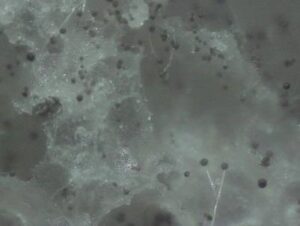
Another teacher, Carol, who also taught a unit on moulds, recalled the powerful positive impact of the interlacing of student experience of real mould and their viewing of magnified images during her final interview for the project:
Especially with our mould unit, where we were able to combine the visual, and I think that had a huge impact and it was also practical. I think because we had done the practical, growing the mould and they’d seen the mould, but until they actually knew what was going on and they could actually visualise it, the steps and actually see the parts and see over the time-lapse photography, what had happened, I think it just opened up their eyes. This is what’s going on. And I think that had a huge impact on their learning, they wanted to know more.
By using the large image Tayla was able to work with the class as a whole, rather than move around the class working sequentially with different groups, to guide the development of individual student understanding of the specific parts of mould. The scale of the interactive whiteboard image meant that all students had easy visual access to the level of detail required to identify the features. Tayla’s guided analysis of the parts of the mould was supported by the wall chart, which depicted the same information but as text and a somewhat stylised drawing. Tayla’s talk had the advantage that it pertained specifically to what the students were seeing. The chart had the advantage that the information on it was persistent and so available for ongoing student reference, even if the student had not been attending to Tayla when she was talking. Tayla’s use of a range of examples provided the students with an opportunity to discern what the actual moulds had in common, as Tayla pointed out to the students at the end of the sequence.
In this example, meaning was constituted through and constructed by the interaction of teacher and student talk with the enlarged images and the drawings and visual text on the wall chart. The public negotiation of meaning provided an equitable forum for student and teacher contributions and feedback.
Augmenting talk with modelling, demonstrative action, and dramatisation
Action as a mode for expressing, developing, and evaluating meaning includes the use of gesture, the use of space, modelling, demonstrative action, and dramatisation. The InSiTE teachers and students made use of all of these aspects. The InSiTE teachers valued hands-on activities because they considered that students learned from and enjoyed being actively involved in the learning process, and so they provided ample opportunities to use action as a mode. The teachers guided students to act out practices and ideas. The teachers themselves modelled and demonstrated skills, practices, and the conduct of tasks.

Teachers modelling the conduct of tasks and acting out ideas was an important aspect of many of the lessons we observed. The teachers modelled skills and procedures in technology and the conduct and reporting of experiments in science (see Figure 17). They modelled how to record results and complete worksheets and at the same time they introduced related vocabulary and ideas. Teacher actions and talk provided a model of how to act and speak scientifically/technologically. Modelling and demonstrations helped students gain a sense of the conduct of a task and the part they were to play in this. In an action that reinforced this possibility, the teachers often used the recording sheet the students were going to use in their own introduction and demonstration of a task.
In the following example, Jane modelled the conduct of a number of different investigative tasks using the same sheet to structure her actions, and ultimately those of her students. The sheet consisted of columns for the students to record their predictions and the results of their investigation. Jane used the same sheet for four consecutive lessons, each time reducing the extent of the scaffolding she provided. In the fourth lesson she introduced the task as a student investigation of the absorbency of a set of materials. In this example, Jane’s actions not only provided the students with a model to follow in terms of how to conduct the task, they also augmented her spoken description of what was involved. Prior to the fourth lesson individual students conducting part of the investigation within the whole-class setting allowed Jane to observe student actions as evidence of understanding. On one occasion she was able to observe that the students had not realised the importance of beginning afresh each time they tested to see if a substance dissolved in water. The students added the next material to whatever substances had been mixed up to that point. Jane realised that although she had modelled beginning afresh for each new material, she had not talked publicly about the idea of independent trials. She was able to remedy this on the spot by modelling again the process and explicitly directing student attention to her actions.
The teachers sometimes asked students to act out ideas and processes. This kind of activity was undertaken to augment the introduction of a new idea and to provide an alternative means for students to engage with and express an idea. Groups of students worked together to dramatise ideas. This provided a stimulus to and a forum for talk: students needed to explain and justify any suggestions for collective action. In one example of this process Lois introduced her Year 1–3 students to the notion of a batch production line.
Lois introduced of the notion of a batch production line as mechanism for a group of people to work together to produce a healthy snack by dramatising the process. She did this in the third lesson in a four-lesson technology unit on the development of a healthy snack.
Lois: We are going to have a production line. If we were making a sandwich, what would we do? Let’s make a peanut butter sandwich. Come up May and Nicki.
[May and Nicki move to front of class and stand side by side beside Lois]
Lois: What is my job? [She pretends to pick up a slice of bread] I am going to put on the butter. May, you will put on the peanut butter. Nicki, you will cut it. Could I put the peanut butter on?
Class: No.
Lois: Could I cut it?
Class: No.
Lois: I don’t do May’s job and she doesn’t do mine? Let’s act it out
[Lois pretends to butter the bread].
Lois: I’m buttering the bread
[She hands the sandwich on to May. May pretends to put on peanut butter.].
Lois: May is putting on the peanut butter
[May hands the sandwich on to Nicki. Nicki pretends to cut the sandwich.].
Lois: Nicki is cutting the sandwich.
Lois: In your groups you need to sit at your table. You need to work out what everyone’s job is. So what is Joss’s job? What is Olive’s job? What will be Lance’s job?
In this sequence Lois talked through, and with the help of two students, acted out, a batch production line for making a sandwich. She concluded this sequence stating:
We all have our own jobs. I don’t do May’s job. The first task for each group is to get an A3 paper to write down everyone’s job.
After this the students moved off into their groups to decide on the roles and responsibilities for each person in their particular production line. Sue, Sharon, and Adam had decided to make yoghurt ice blocks. They discussed who would do what:
Sharon: Don’t you want to do the yoghurt and I want to do the fruit?
Adam: I want to do the honey.
When Lois arrived at the group she probed to find out who was going to do what:
Lois: What’s the first thing you need to do? You need to write this down. [Sharon wrote: “Put the yoghurt in.”]
Lois: Who is going to put the orange juice in? That’s going to be a cool job you get to use a measuring cup.
[Sue wrote, “Sue put the OJ in.”]
Lois: OK write your name Adam. Do you like honey? What do we do after we put all the things in? Sharon is going to stir it, and Sue can stir it.
Lois: What is the first job that has to be done Sue? Has everyone got their jobs organised? Where are you going to put your food after the food is done?
It was obvious that the students took the job allocation seriously. Each undertook only their assigned role in the actual production process the next day. Later when the students were back sitting on the mat Lois asked about the production line.
Lois: What is your production line?
Molly: What happens to each person.
Zac: One job each.
Lois: What is a production line?
Logan: It’s a line.
Colin: Where people have different jobs.
From the acting out of the production line, to the students’ independent group work, to the whole class recap it was evident that the students understood the key features of a production line. This was confirmed the next day when they produced their actual healthy snack.
In these examples, action augmented and complemented talk to enrich the communication and meaning-making process. There was often redundancy between talk and action but, as the example of Jane’s demonstrating how to test for solubility illustrated, action alone was not necessarily sufficient to support student learning of science or technology processes and ideas.
Challenges in the use of multiple modes
There was evidence from our classroom work that student use of each of the modes was an activity that required knowledge. While the teachers were always careful to introduce and explain the language of science and technology they came to realise the need to make explicit the practices as well. For example, the use of drawing to anchor and augment talk was not without challenge. The teachers’ joint analysis of student drawings at one of the team meetings provided compelling evidence that drawing, like talk and writing, is a skilled activity and so students benefit from instruction in it.
Some of the challenges inherent in teacher use of student drawing as a mode to help students articulate and develop their ideas were evident when Jane asked her new entrant students to draw an electric circuit as part of planning the lighting for a model theatre. The task she posed required students to draw a circuit diagram on a piece of blank paper. She provided no instruction on how to do this and in consequence the students struggled to realise the connection between their drawing and the circuit they were to make. Jane realised the students’ difficulties and discussed them with Martha, the Year 2 teacher at the same school, because she knew Martha was going to do a similar activity with her students. As a result of this conversation Martha required her students to draw the plan for the wiring of an electric circuit for a light at the front door of their model house on the model house itself, rather than on a separate piece of paper. When she talked with her students Martha asked them to trace their circuit with their finger and explain to her why they thought the light would glow. The practical issues that arose included whether the circuit was complete, whether someone would be able to reach the light switch, whether a person could open the door if the circuit wiring was positioned as it was on their plan, and whether the placement of the light was sensible in terms of efficiency in lighting the room. Through this process a number of students realised that they had not considered these ideas. In this instance, the students’ drawings provided a useful forum for teacher–student talk about the notion and importance of a complete circuit and the need for the technological solution to be practical and useful. Martha’s forethought on having the students draw on the house, tracing and talking about their circuit, mitigated some of the problems Jane encountered with her students drawing to develop ideas.
Concluding comments on interaction as multimodal
To sum up, the InSiTE teachers and students employed multiple and multimodal means to make and communicate meaning. They drew on the affordances of the different modes to enhance and enrich meaning making and communication. Talk was a concise and efficient means for negotiating shared understandings and communicating ideas. The teachers explicitly focused on developing their students’ science and technology language proficiency, but almost invariably talk was augmented by action, writing, and/or the visual mode. Written text anchored, augmented, and complemented talk. Writing, in contrast to talk, was persistent and consequently it had the potential to shape what was remembered, and what came to be viewed as significant or important, about an experience. What was written was revisited and revised over time. Like writing, images are available for examination and use all at once and in their entirety. Their interpretation revolved around understanding each part and how those parts in a particular spatial relationship comprised the whole. They were used to represent ideas and past and future events that could not have been expressed or represented by words and written text alone. Actions were useful for demonstrating and illustrating understandings, skills, and practices. Teacher and student use of the modes in combination multiplied meaning (Lemke, 2000). The result of teacher and student use of multiple and multimodal means to make meaning was that if a student had not been attending or did not find a particular representation meaningful they had multiple opportunities to express their ideas and develop shared understandings. Meaning emerged from “a process of interaction, contrast and conjunction of the modes” (Kress et al., 2001, p. 25). When multiple modes were coordinated or used in conjunction with one another, teacher and student opportunities for expressing ideas and developing shared understandings were enhanced and enriched. This then contributed to teacher and student AfL interactions and practices.
Artefacts used to provide scenarios and resources for interaction
Teacher and student use of artefacts featured but was not foregrounded in the preceding examples, which focused on the multimodal nature of interaction, scenarios, and resources for interaction (Roth, 2005). For simplicity we distinguish between two kinds of artefacts—those that were real, such as fossils, tongs, and kites, and those that were designed and made by teachers and students. Teachers designed and produced artefacts, including artefacts that could be manipulated, worksheets, posters, and wall displays. Students produced artefacts including completed worksheets, models, and objects such as kites and tongs. In this section examples are provided to illustrate some of the ways artefacts supported and constrained interaction in the InSiTE classrooms.
Augmenting talk with real artefacts
The InSiTE teachers used authentic, everyday items to stimulate student interest, and as a focus for students thinking about and developing ideas and processes. In science lessons the teachers made time for students to observe and handle sets of objects to establish a basis of common knowledge of items such as seeds, fossils, and moulds. This was important because this shared experience could not necessarily be assumed and so was not available as a resource for further learning. The issue of what student prior knowledge they could reasonably assume was particularly problematic for the early years’ teachers because their students also had very little shared school experience to call on.
For instance, one student in Jane’s new entrant class did not know what a seed was and many of her students indicated they had not had any experience with planting seeds to grow plants. Jane spent some whole-class time guiding the students in the examination of different types of seeds. The students visited the school gardens with the school gardener and talked about his plans for future planting. The examination of a range of real items was also important for Lois in her unit on fossils, when her initial exploration of student prior knowledge suggested not many students knew what a fossil was.
Teacher use of real artefacts in technology differed somewhat from their use of artefacts in science in that it tended to be more elaborated, in part because technology involves problem solving and innovation based around an understanding of currently available solutions. Consistent with this, the InSiTE teachers orchestrated student analysis of a range of pertinent artefacts as part of technology teaching sequences where the macro task involved student development of an artefact. The analysis of the salient features and characteristics of a set of artefacts provided an entry point for the discussion and development of a consensus about the technological concepts and processes relevant to the macro task. Student design work was grounded in the examination of existing technological artefacts to distil key features. This examination, as with the informed use of all artefacts, required an appreciation of both the physical and conceptual aspects of an artefact, what technologists refer to as form and function. Teacher guidance was important in helping students appreciate both aspects and their relationship.
In one example of this process, Gail’s Year 4/5 students undertook a teacher-guided examination of a set of tong-like artefacts prior to their producing tongs themselves. With the students in a semicircle, Gail introduced a number of tong-like tools, naming the tool, demonstrating its action and function, and then placing it in the circle (see Figure 18). The tools included fire tongs, salad tongs, a stapler, a nutcracker, an egg slice, scissors, and a bulldog clip. One student offered her hairgrip as a pair of tongs that were similar to the bulldog clip, indicating she had synthesised the salient features of a pair of tongs. This was placed on the mat.
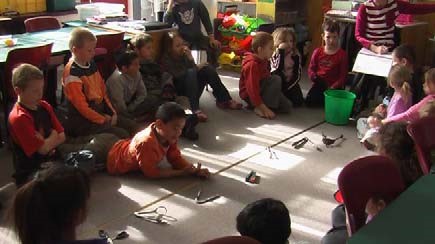
Next, the students were placed into groups of four. Each group was given a worksheet. This included a photocopy picture (real size) of one of the tong-type tools from the mat. The students recorded the tool’s measurements, shape, flexibility, and purpose. The completed work sheets were placed around the classroom with the associated real tool. Each group was given another worksheet, which took the form of a table. This had spaces for them to record the information from each of the individual worksheets under the headings: “tong name”, “size in centimetres”, “shape”, “material that it is made from”, “flexibility”, and “used for”. As a class the students discussed their summary sheets to identify “tongness” and establish the criteria for developing and making their own tongs. Gail’s recording of this discussion is shown in Figure 19.
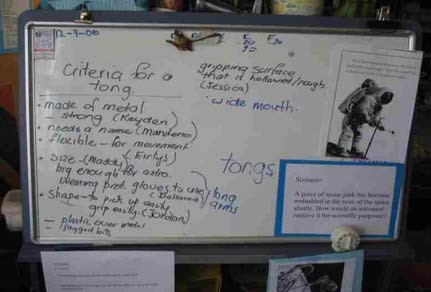
Gail then typed up these criteria overnight and the class began the next lesson by reviewing them. Gail kept the poster of the criteria on her easel throughout the unit and directed the students to use the criteria to evaluate their finished tongs. After the unit Gail discussed the value of using authentic artefacts. She stated that she had planned for the students to examine a range of tools to assist them to develop a shared understanding of tools as designed objects that have a specific purpose. As she anticipated, the use of real artefacts allowed the students to see in-depth how tong-type tools worked and to identify similarities and differences between tong-type tools leading to the development of taken-as-shared criteria for “tongness”. She explained, “Without them [the real artefacts], it would have been very hard to explain what was required in order to create the model.”
The real artefacts created the focus for each of the unit lessons by: helping the students to identify what a pair of tongs was, helping build criteria for making tongs, providing a model to support design and making, supporting student drawing a design from different perspectives, and by adding fun and interest.
Real artefacts played a role in helping students to make explicit and extend their prior knowledge. They supported the development of a shared or common knowledge. In technology, in particular, they often played a pivotal role in the development and student understanding of criteria for student assessment of design products.
Teacher-designed artefacts augmenting talk in a whole-class setting
The InSiTE teachers used a range of own-designed and produced artefacts to stimulate student interest, to cue student prior knowledge, to provoke student questions, and to introduce and explore new ideas, processes, and skills. These artefacts were designed by teachers to organise, bound, and guide the flow of activity and talk. Artefact form and function (physical and conceptual) (Engeström, Miettenen, & Punamaki, 1999) played a role in the success of and challenges to artefact use for each of these purposes.
For instance, as part of a technology unit on cheese modification Brenda got her students to taste test three commercial cheeses. Her intention was that this task would introduce students to how to conduct a taste test whilst simultaneously providing a shared experience that would be available for later reference and discussion. She planned the experience as preparation for the students modifying the flavour of a fresh cheese they had made themselves. To introduce the taste test process and the criteria students should use to analyse and rate the cheeses, Brenda prepared a “Characteristics of different cheeses” worksheet (Figure 20). In the whole-class setting Brenda held up an A3 copy of the worksheet and questioned the students about their meanings for the words it featured—ingredients, appearance, aroma, texture, and flavour. At the same time she explained to the students how they would conduct the taste test and fill in the sheet. The following extract illustrates these points.
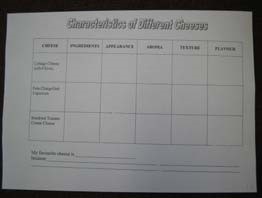
Brenda: Each student will have a worksheet [holds up a sample student A4 worksheet and points to the heading]. ‘Characteristics of Cheese’ means what they’re like, describing them. [She points to the first category] Fill in the ingredients; I’m going to put those on the board for you to fill in.
Brenda: Appearance, which means, everybody?
Students: Looks like.
Brenda: Yeah.
Brenda: Aroma, which means, everybody?
Students: Smell.
Brenda: Yeh that’s right. We’re going to use that word for smell; aroma is smell. What does it smell like?
When the students moved into small groups to taste test the three cheese samples they filled in their own A4 copy of the same worksheet. While the students were excited by the novelty of tasting in class time, and in some cases had strong reactions to the flavour of the cheeses, the worksheet provided a focus and purpose for student action and analysis. Each student recorded their evaluation of each sample for each of the taste-testing criteria.
In this example, the teacher-designed worksheet in its two guises anchored interaction. As a presentation tool it provided a persistent public representation of the key criteria to be used in taste testing, and as such served as a referent for talk and gesture. It allowed Brenda to model the process for the completion of the taste test in a way that was visible to all of the students. The students used the worksheet to guide their own taste testing. They confidently completed the task in line with proper procedures.
The pattern of this example was replicated many times in the InSiTE classrooms. The teachers frequently introduced their students to new ideas and processes using artefacts they had designed to use as a scenario and resource for interaction.
Augmenting talk with teacher-designed artefacts as an alternative to writing
The InSiTE teachers sometimes provided students with sets of material resources to be manipulated as an adjunct to talk. In both the whole-class and small-group setting these sets served as an interactive tool that provided a dynamic visual representation of the group consensus thinking at any one time. The manipulation of the sets supported the discernable involvement of a number of students. Students were encouraged to articulate and justify their ideas because they needed to explain their reasoning when they moved an artefact.
One example of the collaborative whole-class construction of a public artefact to represent and record consensus thinking using manipulatives occurred when Gail asked her students to sort a set of cards that identified different materials (paper, wood, sandpaper, and so on) (see Figure 21). The students sorted the cards along a continuum based on which would produce the most friction as a “road” for a toy racingcar. The material names were each on different cards and so the students were easily able to change their position on the basis of ongoing discussion. The large text meant that it was easy for the students to read the cards and make their own assessment of the current ranking. Ten of the 25 students actively engaged in this process, most of them initiating their engagement by re-ordering a card. This activity seemed to engage more students than a whole-class discussion based around a teacher-produced worksheet.
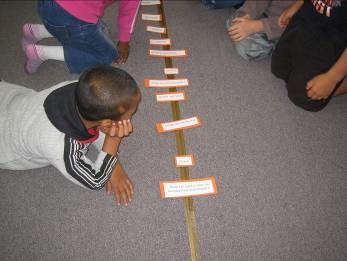
Often the set of artefacts to be manipulated included an item that problematised the idea that was the teacher’s focus for student learning. For instance, Lois orchestrated the sorting of a sample of foods as healthy/unhealthy as a prelude to her students developing a healthy snack themselves. The students’ prior learning about healthy foods informed their decision-making process. Lois produced a written record of the class decision as a student categorised the food samples. Lois set up the task explaining:
We’re going to make a chart of all the snack foods that are healthy and unhealthy. Olly, will you pull out one food? We need to put thumbs up if we think it is healthy and thumbs down if we think it is unhealthy.
Olly pulled out some carrots and all the students put their thumbs up. Olly told Lois carrots were, “Healthy cos it grows in the ground”. Lois wrote “carrots” on the “healthy” side of the twocolumn chart she had prepared. Olly put the bag of carrots on the healthy side of the chart. The “thumbs up” strategy meant that all of the students could show their decision. This process continued for all the foods Lois had collected. When the students were unsure how to classify a muesli bar, Lois suggested they justify their choice using the food pyramid displayed on the easel beside her. When Owen pulled out a muesli bar most students had their thumbs down; some students put their thumbs up. Lois asked, “Where is it on the food pyramid?” and the conversation continued:
Chevon: Middle.
Lois: Really? Does it come from the ground? [Olly had used this justification] Where is it made?
Chevon: A factory.
Lois: Let’s see how much sugar there is. [Lois picks up the muesli bar and reads out] 9.6 grams in 30 grams of food. So that’s 1/3 sugar. [She shows 1/3 on the bar] Is that healthy or unhealthy?
Students: Unhealthy.
All thumbs are now down. The muesli bar is recorded as unhealthy and placed accordingly.
When Cory pulled out a pottle of yoghurt the class went through a similar process, finally, at Lois’ insistence, making a decision and recording the yoghurt as healthy. As well as illustrating the power of an item that is ambiguous and so problematising the decision-making process, this episode illustrates the use of a chart (a food pyramid) from a previous unit. Lois activated this artefact as part of the context for current talk and thinking by drawing the students’ attention to it. She also required all the students to participate in the decision by asking them to put their thumb up or down. This strategy had the advantage that she could see their thinking.
In this example talk, action, artefacts (real foods and the chart), and inscriptions were all involved in the interactive process. This example also illustrates the need for an artefact to be activated as a resource for interaction; mere physical presence is not sufficient.
Student-produced artefacts augment talk
Teacher tasks ofte required students to produce an artefact. Typically, the teachers provided opportunities for students to present and discuss their artefacts with each other. In the technology unit on tongs, Gail set the students a group task of designing a pair of tongs. The students drew a design of a pair of tongs, which they labelled using the language of the criteria they had developed previously (flexibility, size in centimetres, wide mouth, strength, and “grippiness”). When the students stood up in groups of four to present their drawings to the whole class they gestured, pointed, and referred to their drawing to support their design explanations (see Figure 22). They pointed and spoke about the specific features, describing how the pair of tongs would work and why, and what it would be made out of. When students in the audience asked questions, the presenters often referred to their drawing to answer these. When holding and speaking about their drawing the students had a visible aura of authority and ownership of ideas they were sharing.
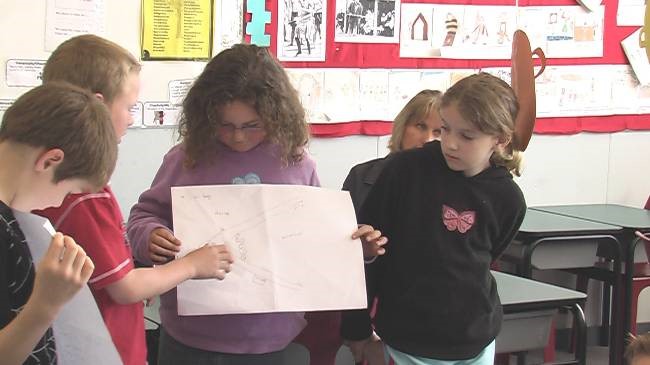
Challenges in the use of artefacts
There was evidence from our classroom work that students enjoyed hands-on tasks. The teachers also valued hands-on tasks. However, student use of artefacts was not unproblematic. Students needed to appreciate the pertinent physical, conceptual, and procedural aspects of an artefact, and the relationships between these aspects, for them to use an artefact as the teacher intended. This was just as much the case for real objects as it was for teacher-designed artefacts.
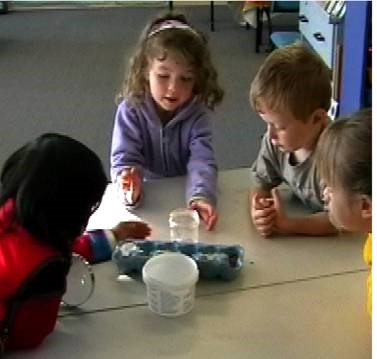
Student appreciation of the significant features of artefacts was important when students worked in small-group settings, because they then interacted only intermittently with the teacher. Their engagement with their teacher’s task relied on them understanding the task and its associated artefacts as the teacher did. Jane’s students investigating how many ingredients they needed to mix together before they had what they would call a mixture was an occasion when students did not undertake the task as a teacher intended. The artefacts Jane provided as part of the task were a glass jar, a spoon, a magnifying glass, and an egg carton filled with small quantities of different dry ingredients including rice, sugar, flour, salt, and sago. In this instance, the students each took turns to add a small amount of a different ingredient to the jar and stir the resulting mixture (see Figure 23). There was little discussion between them as each student concentrated on the task of transferring the ingredients safely into the jar without spilling. When Jane interacted with the groups she realized that the students were not systematically investigating the problem. She suggested to the students:
Do you want to start again and just put one [ingredient] in and see if that makes a mixture? And then the next person could put two ingredients in and see if that makes a mixture and then the next person could put three ingredients in and could see if that makes a mixture.
At Jane’s suggestions the students started again. They each had a turn and poured two or more spoonfuls into the jar without emptying it in between. As each student added an ingredient she or he each looked at their product with the magnifying glass. Again, the students didn’t talk much as everyone was watching and concentrating on not spilling anything. They were concerned with the technical skills involved in scooping and appeared to gain immense pleasure from successfully scooping out a small amount of a dry ingredient. When they were on their own, the students did not investigate how many ingredients were needed to make mixture. The conceptual learning faded into the background. Jane’s presence and active intervention were required for them to begin thinking about and systematically investigating just how many ingredients were needed to make a mixture. Jane commented after the lesson that although she had considered the technical skills and management issues involved in the task, she had not given such careful consideration to how the task would scaffold the student’s learning about mixtures in her absence. In this case the students did not fully appreciate the conceptual aspects of the artefacts.
The physical aspects of artefacts influenced the way collaborative activity played out. All those involved needed to be able to see or access salient aspects, whichever was required for active engagement in the learning. Tayla’s use of the digital microscope to present large images of mould illustrated the value of clear whole-class access to a detailed image. That the size of an artefact could limit student collaborative participation in a task was illustrated by the frustration teachers and students faced in wiring up electric circuits. On each of the three occasions that we observed units on electric circuits, the teachers used very small, but cheap, 1.5V light bulbs. The students needed to connect the bulbs into a circuit via the metal sleeve casing and the dimple on the bottom of the bulb (see Figure 24). Not only were the bulbs so small as to make it difficult to physically contact and connect two wires using fingers, but the bulb size compared with that of fingers made it difficult for students to appreciate the need to attach a wire to each of the two locations. The obscurity of the process was evident in the student drawings as was described earlier, and by student inability to replicate a working circuit from one lesson to the next.
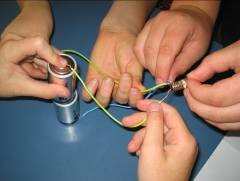
Concluding comments on artefacts as scenarios and resources for interaction
We decided to discuss the role of artefacts because our teachers spent considerable time collecting and preparing material resources to support their students’ learning. The artefacts the teachers used provided scenarios and resources for interaction through the interplay of their material and conceptual aspects. The teachers designed artefacts that posed a problem and indicated possible ways to accomplish a task, but the influence of an artefact on interaction was not a given. This depended on how an artefact was introduced to the students by the teacher, and how it came to be integrated into interaction. Its influence and meaning for interaction were situated.
Social aspects of interaction
In the previous sections we detailed the multimodal nature of the InSiTE teacher–student interactions around ideas. During their interactions the teachers and students employed a range of modes, switching from one to the other and using them in combination as they sought to express and develop ideas as part of classroom interaction. We also described how teacher- and studentproduced artefacts provided a scenario and resources for interaction. However, teacher and student opportunities and incentives to use the various modes and supporting artefacts were shaped and constrained by the nature of the classrooms as social settings in which particular patterns of interaction had been established. These social aspects had implications for why, with whom, how, and with what effect individuals and groups engaged in interaction around science and technology ideas and practices. These social aspects also had implications for whose contributions were construed to be of merit and which actions influenced what came to count as valued and legitimate knowledge in any particular classroom.
Routines and their role in interaction
The InSiTE teachers and each of their different classes interacted with each other in a number of distinct ways that operated as taken-as-shared. These included, for example, how to work together to conduct a brainstorm, how to report back on group work, how to participate in a think-pairshare activity, and how to contribute to whole-class discussions. These well-known routines appeared to assist students to maintain a focus on learning while they were working on a task and when they were making the transition from whole-class to small-group/individual work and back again. As Leinhardt and Steele (2005) point out, these “socially scripted elements reduce the complexity of the lesson by helping to highlight what is central to the lesson and by making automatic that which does not need to be a major focus every time it occurs” (p. 158).
The following examples illustrate the contribution of shared understandings of the patterns of interaction. By chance these examples both come from Lois. They were selected in part because they illustrate the ways students as young as five to six years are able to work successfully together within mutually understood patterns for interaction to share and develop their ideas. The data set includes a variety of examples from each of the different teachers that illustrate the role played by well-established patterns of interaction in supporting student learning. In this example, Lois’ students worked on a sequence of tasks that provided them with a variety of opportunities and modes to share and build ideas about kiwi. This lesson took place in 2005. Lois, as was typical of the InSiTE teachers, began the unit on kiwi, their features, and how these related to its endangered state, with a task that aimed to cue student prior knowledge and experience and stimulate student interest in her intended learning. To do this, Lois gathered the class on the mat in front of a picture that was covered with a page of paper. She then proceeded to progressively peel off the jigsaw-like pieces of the cover sheet to reveal a photograph of a kiwi. As she peeled off the jigsaw pieces Lois encouraged her Year 1–3 students to conjecture about the identity of what was being revealed (a partial sequence of the progressive disclosure is shown in Figure 25).

Students offered ideas that converged on the picture being that of a kiwi as they saw the curved shape, brown colour, and the “big” feet. The identity of the bird in the picture was confirmed in a class chorus of “It’s a kiwi” when the ninth piece of the cover sheet was removed to reveal the long beak.
Next, Lois told the students she was interested in what they knew about kiwi. She assigned the students to groups of four to brainstorm the characteristics of kiwi. For each group she nominated a leader. This person was the most experienced writer of the four. She gave each group a large sheet of paper and a marker pen. The groups moved to small tables. The nominated leaders orchestrated the task in different ways. One leader called for contributions from each child in order and recorded the contributions. Another passed the pen around and each child recorded their own idea, although the leader helped the child who had just begun school. The students listened to the ideas and explanations of other students, they commented on each other’s ideas, helped each other contribute ideas, and often worked as a group to write their ideas.
After eight minutes, Lois called the class together. The students sat in their groups in a circle on the floor with their brainstorm chart in front of them. Lois nominated group representatives to share an idea and recorded this on a flip chart. During this process the students visibly looked at each other’s group charts and listened to the shared ideas. They monitored the publicly displayed ideas against those on their own chart. The final task in the lesson was for each student to draw a kiwi.
In this example the task sequence guided the students from a focus on the physical features of the kiwi, as they were depicted in the photograph, to consideration of the characteristics of kiwi as a species. There was a progression from a particular conception of kiwi and their characteristics to a general, and more abstract, conception. The progressive disclosure of the photograph was orchestrated to build anticipation and focus the students’ attention on the physical features of the kiwi—its overall shape, feet, colour, feathers, and beak. The brainstorm, like the disclosure task, required the students to differentiate and distinguish the characteristics of a kiwi. In this case, each child needed to be able to communicate ideas in words, without the help of a visual referent. At least one member of the group needed to be able to record ideas in writing. Following on from this, the whole-class pooling of group ideas required students to engage in the joint construction of an inscribed artefact that was a public record of some of the distinctive features of kiwi. The students then needed to produce a drawing that reflected their view of these characteristics. Given that the students, who were aged 5 to 7 years, participated in four tasks in around 30 minutes, their understanding of how to accomplish brainstorms and the sharing and discussion of ideas was essential. Lois’ management of the transitions between tasks was important. Lois used familiar classroom practices and task structures as a resource to expedite the transition from one activity to the next and to help the students sustain a focus on the goals of each new task. The students were experienced in the conduct of brainstorms where a nominated leader, usually an older student, acted as co-ordinator and writer in a mixed-age group. The whole-class pooling of group brainstorm ideas was also familiar to the class. There was no need to negotiate social arrangements and so a continuity of focus on the features and characteristics of kiwi was preserved.
The influence of class norms for interaction was also apparent in student talk in the absence of the teacher. Students in the InSiTE classrooms often, but not always, drew on their prior knowledge to talk about content-specific aspects when they were working without the support of a teacher. The following dialogue is taken from the third lesson with Lois’s Year 1–3 class in 2006. The topic of the unit was fossils and the students were colouring in their drawings of a Pterodactyl dinosaur (see Figure 26). The dialogue began with a discussion about whether the Pterodactyl had wings or blades and whether it could fly. This led to a discussion about flying, space, shooting stars, and the desert as different students picked up on key words from prior contributions. Initially, only students from the one table contributed but towards the end of the sequence students from a neighbouring table also contributed. The students appeared to be very comfortable with sharing and discussing ideas.
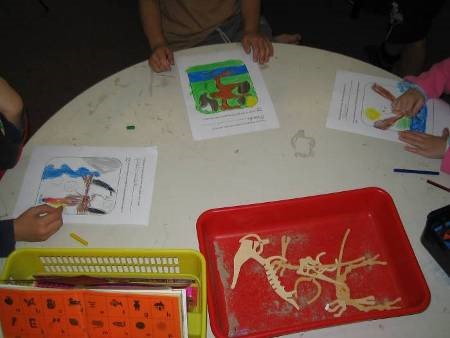
Colin: Really high. Pterodactyls can fly, but not too [far].
Olly: Balloons can. They explode [Pointing his arm upwards].
Dianna: Yes, sometimes. … Once I had this. … Once this Baby had this balloon that flies up. It flew up in the sky. …
Dianna: Some landed on the moon if it’s not hot.
Colin: Did you know the moon has holes? It’s just it’s light, so you can’t see them.
Olly: Yeah … it’s just so high up [Points up with his arm again]. There are no clouds.
Dianna: There are!
Colin: Yes because of the sun and the clouds [You can’t see holes].
Dianna: Shooting stars go around and behind the clouds.
Colin: Shooting stars go up and down.
Dianna: Once I saw a shooting star.
Mary: [from the neighbouring table] You can’t get shooting stars in New Zealand.
Colin: Yes, you can.
Olly: [turns around] You can get them anywhere, Mary.
In this classroom the norm for discussing ideas in small groups was strong. The colouring task was well within the capability of each student and so the students used the time to talk about their ideas. Individual students built on each other’s ideas and each student made a contribution.
The distribution of authority and agency
A key dilemma that confronted the InSiTE teachers was how to help their students develop a knowledge and understanding of science and technology whilst simultaneously supporting their students to develop their individual ability to create and use knowledge (Wells, 1999). The InSiTE teachers often used IRE (the teacher initiates an interaction with a question, a student responds, and the teacher evaluates the student response) questioning sequences (Mehan, 1979), particularly in whole-class settings. This interaction sequence explicitly asserted the teachers’ authority over knowledge and the students. However, the teachers also employed a range of strategies that supported the distribution of authority and expertise within the classroom. This was achieved and played out in the degrees of openness of the tasks they used. The teachers’ supported the distribution of authority by encouraging students to seek help and advice from peers and to contribute ideas and suggestions from those outside the classroom school, as has been illustrated in previous examples. Artefacts also supported student independence and autonomy, as did the teachers’ gradual reduction of their support so that they handed responsibility over to students. Student autonomy and agency was valued, promoted, and made possible through these strategies.
Tasks provide for different levels of student autonomy and agency
Teacher-prepared tasks, and their associated artefacts, enabled and constrained student thought and action to a greater and lesser extent. The implications this had for student autonomy and agency were clearly illustrated in the differences in student talk during an initial brainstorm about kiwi and a true/false sort of teacher-prepared facts. In the first instance, Lois as teacher was interested in student prior knowledge. The brainstorm task, sequenced as it was after student examination of a photograph of a kiwi, prompted student contributions (verbal and written) that revealed a breadth of knowledge and interest in kiwi as a unique New Zealand bird. Figure 27 is of one group’s brainstorm recording sheet (the students were aged 5–7 years).
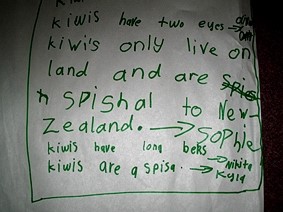
The true/false sort of statement cards was conducted towards the end of the unit. Lois prepared a set of statements about kiwi (one statement per card) with the intention of assessing student understanding of key aspects of her intended learning for the unit (see Figure 28). The card statements as physical objects encouraged the students to work in close proximity. The statements circumscribed, at least partially, student talk and ensured the students discussed the ideas Lois was interested in. In essence the cards served as a surrogate source of teacher authority and control even when Lois was not physically present.
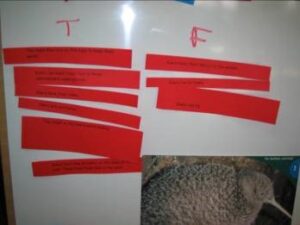
Peers and artefacts supporting student independence and agency
The teachers used artefacts to support student independence and agency as they worked on tasks and undertook self-assessment. The way Jane supported her new entrant students learning to design and make kites provides an illustration of the role a distribution of expertise can play in student learning and agency. Jane began the first lesson of a technology unit on designing and making kites by guiding student observation and handling of a simple commercial kite. She pointed out the shape, the way the corners were reinforced, the positioning of the braces and the attachment of the flying string. She then modelled the making of a kite similar to the commercial one, in conjunction with the production of an action plan. In this process she talked into meaning the link between the action plan inscription and her manipulation of the real materials culminating in the production of a kite. The students had used a different version of the action plan template in an earlier unit when they were doing a product survey, so the plan format and concept were not entirely new to the students. Jane then had the students go through the same series of steps to produce a replica kite. She repeated this sequence twice more with two different but simple commercial kites on two different days. On the fourth day the students designed and made a kite of their own.
During each of the kite-making times the students sought help from each other, referred to books, and examined the commercial kites and those they had made themselves in a preceding lesson. Several students, when they had finished their own kite, helped out or were asked for advice. They told, showed, modelled, and sometimes simply took over some stages of the kite-making process. The following conversation was with a student we had observed shifting from being the student to the teacher for another student who arrived late in a lesson.
Researcher: So did anyone help you?
Ben: Ben helped me a little bit. He just helped me taping it and then he did his own one.
Researcher: So that was really good working with another person then?
Ben: Hmm
Researcher: You also remember working on the table with the other children. Can you tell me about that?
Ben: It’s pretty easy because some people can help each other.
Researcher: I remember watching you helping—who was it again?
Ben: Joe!
Researcher: Yes, you helped Joe and how did that go?
Ben: Very good. Pretty easy.
Researcher: You remember what you did?
Ben: First I put on some paper then I glued the sticks and the bridal on, third I taped the bridal so it can stick. And then I went to do the nylon.
Researcher: When you helped Joe, did you do all this for him?
Ben: I just told him what to do.
Ben’s comments suggest he has a clear understanding of the sequence of steps for making a kite and also some of the terminology. Although he initially spoke as though he took over the task from Joe, in fact he helped Joe to accomplish these tasks in much the same way Jane worked with the children. This action provided Ben with an opportunity to further familiarise, practice, and embed skills and conceptual knowledge. This action provided Joe with timely help and support. It was made possible because of the freedom Jane allowed during the design and make process and because she encouraged students to share their expertise. It was also made possible because Ben had sufficient confidence in his own knowledge and skills to offer support—he had tested out/flown his kite and knew that it worked. It was often the case in the technology units we observed that the students validated their work through a testing process. They did not seek out or require their teacher as a source of authority. This appeared to contribute to their independence and autonomy.
For Robert, in the same class, his freedom of access to books and made kites was a source of autonomy and agency (see Figure 29). Robert was a second-language student with very poor spoken English skills. He demonstrated very little inclination to write or draw an action plan, but he was very enthusiastic about kite making. He watched closely as Jane made the first replica kite, and once released to work on his own he set off with great enthusiasm, very quickly producing a creditable kite (Figure 30). With Jane’s consent he went outside to try it out and it flew.
|
|
|
When Roger had problems with his second and third kites gaining elevation he went back and checked his first kite and examined the commercial kites and then made adjustments to the his later kites to bring them into line with the first one. This checking with his successful kite was very systematic and interspersed with test flying.
Teachers reducing their support in order to promote student autonomy and agency
The InSiTE teachers often orchestrated a sequence of tasks where they deliberately began by providing a lot of support and then gradually withdrew it as the students became more knowledgeable and skilful. Teacher modelling of conceptual and procedural skills, followed by the careful withdrawal of support, provided opportunities for students to exercise independence and autonomy.
For example, Jane began a unit on investigations by introducing a structured chart with the title “Science Experiment” and a sentence to complete that began, “I want to find out …”. The chart had three columns. The first had no heading, the second prompted students to predict what they thought would happen, and the third prompted them to record what they observed. In the first lesson Jane orchestrated every step of an investigation into whether or not a set of substances would dissolve. She modelled each step and the students replicated it under her direction. Jane recorded the results (see Figure 31). In the next lesson, she used the same chart but allowed the student to suggest steps, still in a whole-class group (see Figure 32). She repeated this process with a different investigative topic in the third lesson. In the fourth lesson she told the students they would be investigating the absorbency of different materials. Although she laid out the materials they were to use and discussed with them as a class how they might conduct such an investigation, the students undertook the investigation themselves (see Figure 33). To ensure that the students were able to record their predictions and observations, Jane provided them with sets of prediction comments to choose from. Each student glued a sample of material in the first column and then selected and glued in what they considered to be the appropriate prediction comment in the second column on the chart. They then conducted a test and glued in a statement about whether the material had absorbed water. The students were able to report back to the whole class on their findings.
|
|
|
|
Concluding comments on the social aspects of interaction
Each of the InSiTE classrooms provided a distinct social setting for interaction. The routines and ways of working together that the teachers and students had developed influenced with whom, how, and with what effect different individuals and groups interacted with each other and the teacher. Regularly used routines carried important messages about how learning was to be conducted, particularly since they pervaded every aspect of the lessons we observed. These routine aspects of interaction conveyed implicit messages about the nature of scientists’ and technologists’ work, including how these communities warrant what counts as valid and valued knowledge. The teachers encouraging students to contribute ideas from their own experience, and that of family and friends, along with the openness of tasks and their supporting artefacts distributed authority. This opened up different opportunities for student-initiated interaction and supported different forms and levels of student autonomy and agency within the classrooms.
Teacher and student comments on interactions
Science and technology are fundamentally multimodal activities. They involve technologists and scientists in drawing and talking and the manipulation and production of artefacts. A focus for this study was to help our teachers enhance their interactions around science and technology ideas and practices. Over the course of the study the teachers came to appreciate and value the multimodal nature of interaction, and the fact that science and technology are inherently multimodal in nature. This shift was evident in their comments in a final interview. By the end of study the team had developed a shared understanding of the nature of interaction as multimodal. Jane’s comment reflects this consensus. She highlights the value of teachers providing students with opportunities to explore ideas in a variety of modes:
I think that it’s [multimodal interaction] doing things in different ways. It might be a class discussion, or it might be a hands-on experiment, or it might be dramatising something or me modelling something. It is presenting an idea to children in a whole lot of different ways. You hope that by them seeing it in a variety of different ways, they’ll make some connections and their learning will be established.
As a group we deliberately focused on the multimodal nature of interaction in the last two years of the study. The teachers became more aware of the need to plan and prepare to enable students to use multiple modes as part of the teaching and learning process. This is not to say that we did not consider the role of teacher talk. The teachers thought ahead during their planning about the sorts of interactions they might have and the questions they might ask their students. Jenny, for example, discussed the importance of teacher–student and student–student talk in developing student ideas.
I just think of my kids going to other kids and talking. First of all talking to them about the concepts and then kind of playing games with each other or using the board up there with all the animals and things and talking to each other about it and moving the pictures around.
On another occasion Jenny described the interlacing of talk with artefacts where these were used to anchor, structure, and augment the talk. The task she described required students to place pictures of animals into one of two categories and so the pictures were integral to their talk and thinking.
Myself, I think of probably getting down with the kids when they were doing an activity on the mat and, like, with a small group of kids and just asking those questions. While they’re talking to me, just maybe moving a picture and then saying, ‘Why did I just move that over there?’
Using a range of modes to introduce and develop the same concept, skill, or process gave “two different ways of approaching” the same idea, which increased the chances that a student might make sense of it. Tayla commented that for some students a verbal explanation was enough but others required more support and this was where multiple modes came to the fore. For example, one of Tayla’s students had a misconception about how sound travels. Tayla was able to help her by asking her to think back on the experiment the class had conducted.
I was able to go over and say to her, ‘Well think about the experiment we did and think about that experiment’ and that was enough that she went away and she came back in five minutes and she’d sorted it for herself by going back over what we’d already done. And she was able to make those connections by just guiding.
This approach was not always helpful. For another student Tayla noted she had had to sit down and draw pictures to show and talk about sound travelling.
Tayla spoke at some length about her increased focus on artefacts, commenting on their value in the process in “talking around ideas”.
You’ve got tangible things to actually talk around and to be explaining around … tangible stuff that you can actually touch and you can smell and you can see. … So having that focal artefact there to actually have the discussions and the interactions around, as well as having the actual thing they’re making.
What the final interview suggested was that while teachers may have been developing tasks that provided multimodal opportunities they had not deliberately thought about the affordances of each of the modes in such an analytical way previously. Their involvement in the InSiTE project helped them appreciate the way interactions around ideas revolve around talk that is augmented, anchored, and structured by other modes.
The students, like the teachers, attested to the value of being able to talk, show, and draw their ideas, albeit more indirectly. Tania, a Year 4/5 student, described a range of tasks and modes when she explained how her teacher helped her learn:
We sit on the mat when our teacher wants to talk to us. She tells us what to do and tells us many things when we’re on the mat. Sometimes we go to the board and she used pictures and we had to choose living and not living. When we work in groups at a table the teacher comes to us and talks with us at the table. She might tell us if we’re going all right, she helps us, she asks us questions. It’s so we know what we’re learning about.
This breadth of opportunities to make and communicate meaning was evident in a comment by Jordan from the same class:
When we’re in a class on the mat she makes sure of the words on the board. And we have to have good listening skills because if you don’t have them you won’t know what to do. … In our groups she comes and talks to you about what you’re writing, she asks you if you’re on task and if you’re finished. Sometimes she asks questions when you’re on the mat and sometimes she asks questions when you’re at your desks. She asks hard questions to see if we are learning. She knows if you tell her the wrong one and then she knows you didn’t learn.
Marion, a Year 7/8 student, said of her experience of the percussion unit, “I was taught stuff I’ll remember, like it was hands-on work, not just sitting and looking. You go and make it.”
The InSiTE teachers were very aware of the need to manage the social aspects of interaction, such as the need to induct new entrants into what it meant to be a student, to establish and maintain social norms for whole-class discussion so that all students had an opportunity to contribute, and to allocating students to groups so that the group could work together to progress the learning. While these aspects have a management dimension, they were primarily discussed by the teachers in terms of the value of sharing and discussing ideas as part of a social process of learning.
As noted earlier, the InSiTE teachers were keen to involve students in the learning by making links to their interests and experiences and those of family and friends. Typically they provided a range of resources such as books, pictures, and other materials for students to use. While they did not speak of these strategies as distributing authority and expertise, they intimated they deliberately sought to expand the sources of knowledge available to students in the classroom.
Tayla commented that when she was planning a unit she was:
Using the You-Tube and using movies as well as images and using other people’s ideas. You can go online where you can get a scientist to talk to your kids. … Using lots and lots of different ways to get that expert knowledge in and showing it in a visual way, whether it be a movie or still images or diagrams or animations or something.
Students of all ages commented on the value of sharing and discussing with peers and the skills they had for this. Logan and Kim (Year 1–3 students) talked about how they worked together and how the teacher helped them.
Kim: Miss X helped us learn.
Logan: She helped us learn how to bake. She put out the recipes and got us lots of books.
Kim: We learned in our group cos we didn’t argue much. … In the class group we usually go in a circle to have sharing.
Logan: And it is to see what the teacher says.
Logan: In our group we all want the same thing and if you don’t go in a group it all gets messed up.
Another group from the same class discussed the challenges of collaboration:
Sharon: We worked good in a group cos we talked to each other and worked out who was going to do what. We could not decide. I disagreed on yoghurt pops. And Sharon disagreed and Aaron disagreed. But he got the recipe first. So then we all changed our minds back to yoghurt pops. Aaron said ‘we could make these’.
Sue: We enjoyed it very well cos our teamwork is good. The teacher didn’t help us make. We did it all on our own.
A group of five Year 7–8 students had this to say about what helped them learn:
Charlotte: We worked by ourselves and in groups. Group work helps you view other people’s opinions.
Melisa: Going on camp helped me learn because I understood most of the stuff cos we go to the beach. Our teacher helped me learn especially about limpets and the conditions and effects. People in the class also helped. … The teacher helps especially if you’re looking at how a particular animal is going to live. They help you explain first and think about what you’re going to write. When people ask her questions she asks ‘is that possible?’
Shika: Anna helped me quite a lot cos she sits next to me. She talked about adaptation. Miss Hart helped me learn and she is at the front or she comes up to your desk and talks to us about ideas.
Jesse: My teacher and my friends helped me learn. Miss Hart came up and helped and asked, like, what we’ve done, could you make it better? She motivates us. Your friends help when you are in groups. They come up with ideas and you get things down and put them on paper. …
Carli: Activities are very useful to help you learn and class discussions. Our teacher when she is talking to the class, some people didn’t know the differences and she explains it. My friend helped me with the flow diagram. It helped you learn when it was kind of like a group effort because sometimes the teacher is not around to help. Our discussions were kind of like explaining things, like the conditions of different zones. Discussions also help me understand things, it helps you get an idea of what you know.
Concluding comments on interaction
Our focus on multimodal interactions emerged as a key feature of our joint work with teachers as together we tried to capture, represent, and reflect on the interactions in their classrooms. It gained momentum from our discussions on assessment. Teachers discussed the issues around, and tensions between, their responsibilities for teaching and learning in the moment and their obligation to sum up and report on students’ progress to others. There has been a tendency to focus on talk, or writing. Attending to the multimodal nature of student interaction around ideas and practices provides a rich entry point into developing student ideas. Teachers providing multiple and multimodal opportunities for students to articulate, explore, and refine their ideas increases the likelihood that a diversity of students will be able to do this. The InSiTE teachers used different modes singly, and in combination, to help students articulate their ideas and to develop student understandings and skills. Through multimodal interactions, student and teachers were able to negotiate to a shared understanding and teachers were able to provide richer feedback and guidance.
The social aspects of interaction were highlighted when we examined how the teachers supported students to work together to share ideas and experiences, to develop new understandings, to conduct an investigation, and to produce a group product. The students spent time as a whole class discussing ideas, learning about the tasks they were to undertake, and considering what they had achieved. They also spent time working in small groups. The patterned ways of interacting that had been established by each class for each of these settings played an important role in the success of interaction. Our work with teachers also led us to a focus on the transitions between these different social configurations and the role played by known routines. Taken-as-shared ways of interacting, along with the degree of openness of tasks and the ways a teacher deployed and used resources, supported, or not, the distribution of authority within a classroom and influenced the nature and extent of student autonomy and agency. These aspects had flow-on effects on student opportunities to engage in self-assessment, and provided ample opportunities for teachers to assess student learning.
The temporal aspects of teaching and learning science and technology: pathways and trajectories
One aim of the InSiTE project was to trace trajectories in student learning, including conceptual, procedural, and attitudinal outcomes. As we proceeded through the study our deepening understanding of the implications of a sociocultural view of learning led us to broaden our conceptualisation of what it means to trace student learning. Sociocultural views of learning highlight the situated and distributed nature of learning, along with the multiple timescales in which learning can take place. School is only one of the many places where children learn, but students’ learning in school has the potential to impact on what they know and can do in the short term, and how they see themselves, think about, and interact with the world in the long term.
The InSiTE teachers were well aware they were responsible for supporting their students’ learning in the moment, over the duration of a unit, and over the course of the school year, as well as for developing their skills and dispositions as lifelong learners. The temporal organisation of the school day, and the teachers’ ongoing contact with students, manifest as both a resource and a challenge in the teaching and learning of science and technology. One advantage, but one which posed a challenge to the research process, was that teachers were able to pick up on and develop student science and technology learning outside of scheduled lesson times. The teachers saw the making of connections to students’ out-of-school lives, and across the curriculum, as part of their being responsive to their students’ interests and learning needs. Given that the teachers usually scheduled lesson times over a period of days they had to help students develop a sense of continuity and coherence across lessons, tasks, and ideas.
In this section we describe networks of teaching, task, and student-learning pathways to take into account the notion that individual knowledge and understanding develops in dynamic interaction between the people, resources, and tools in a setting, which is also taken to be developing.
Teaching pathways and trajectories
The InSiTE teachers worked to establish a sense of connection, continuity, and coherence in student learning experiences. This was evident in their planning where they developed a series of nested and linked tasks. It was also evident in their responsiveness to occasions when they could progress the development of student learning. They talked about the connections between ideas, tasks, and lessons and their deliberate use of artefacts to link tasks, ideas, and lessons.
Planning of nested and linked tasks to support continuity and connection
When deciding on the topic of their science or technology unit the InSiTE teachers made every effort to link the teaching topic into students’ everyday interests, knowledge, and experiences so as to make the learning meaningful and coherent to their students. The teachers sought to link science and technology topics to other aspects of students’ school lives and to students’ everyday lives through their selection of contexts and tasks: Brenda asked her students to design a light tower like the one they had used in the recent school production; Gail’s students explored the points of friction on a bike; Tayla investigated mould in the environment; and Jenny’s students worked out what plants needed to grow so they could plant a disused flower bed in the school grounds.
InSiTE teacher planning focused on developing teaching sequences of nested and linked tasks, as was detailed in the section on PCK. This form of planning ensured that the teachers were clear about the links and connections between the ideas, tasks, and lessons they intended to work through with their students. The benefits of this process were that when the teachers interacted with their students they were able to make decisions in the moment to follow particular ideas and practices whilst still maintaining a focus on their overall planned science idea or technology task. That is, they were able to be responsive to their students’ interests and abilities, and at the same maintain the integrity of the students’ science and technology learning.
Responsiveness to occasions to progress student learning
Primary teachers are responsible for their students’ learning across the whole of the curriculum. The InSiTE teachers were proactive in taking up opportunities to progress their students’ science and technology learning. Table 4 records the sequence of occasions, distributed over time, materials, and contexts that Jane provided for her Year 1 students to engage with the idea of solid and liquid. Being able to identify and differentiate solids and liquids was one of the learning goals for Jane’s science unit on foods. Jane’s first science lesson was the biscuit ingredient sort described previously. She followed this with a number of short tasks. In the afternoon of the same day Jane noticed that during a maths sorting and classifying task the students were not able to explain the concepts of wet/dry, solid/liquid even though they could do the physical sort. The next day, when she recapped the previous day’s lesson with the class she questioned the students about the differences between solid and liquid. She used a “Food Science Book” that she added to each day to stimulate the discussion. The book included photographs of the students working on the sorting tasks. Her intention was:
To provide another opportunity to explain their ideas and also for the children to hear each other’s ideas. It is not easy for the children to make explanations (partly because it is a difficult concept) but also because [I think] they have not had a lot of experiences with making explanations and also it is a developmental stage.
| Date: | Task | Task description |
|---|---|---|
| 30 May | Sorting biscuit ingredients | Producing two categories—these were not exclusive as egg straddled them |
| 30 May | Observing whole and broken egg | Observation of the egg—evidence to support ambiguous categorisation (the solid shell and liquid inside) |
| 30 May | Melting the butter for the biscuits | Observation of solid and then melted butter—difference in properties with the change from solid to liquid |
| 30 May (during maths) | A maths sort | Not observed—children to sort selection of items into solid/liquid |
| 31 May | Reviewing photographs of yesterday’s tasks | Recap on biscuit ingredients, including the egg—were they solid or liquid? Butter melting—changing from solid to liquid |
| 31 May | Observing peaches and peach juice in fruit salad | (An aside as part of making a fruit salad mixture) Teacher questioned children to identify and justify which was solid and which liquid |
| 1 June | A picture sort | Sort pictures of food to produce a class poster, giving reasons for placement |
| 8 June | Mixture dance | The students perform a mixture dance, with different groups being solid and wet ingredients |
Jane used the making of fruit salad task as another opportunity to discuss solid/liquid. She had the students sort pictures of food. A week later the students discussed the properties of solids and liquids as they collaborated to choreograph a dance to show their understandings of mixture. Through this approach Jane was able to provide the students with multiple opportunities and contexts to build and express their ideas about solid and liquids.
Talk to develop continuity and connection
Typically, the InSiTE teachers began a lesson by recapping on tasks and ideas from previous days. Sometimes the recap gained authenticity through the provision of information for students who had been away the previous day. The teachers signalled next steps at the beginning of a lesson. To conclude a lesson they reviewed that day’s work and foreshadowed what might happen next time. For example, Brenda outlined to her students that the next day they would learn how to make a circuit so that they could design and make a workable light tower. She also signalled to the students that they needed to begin thinking about what materials might be appropriate for the construction of the tower itself.
Tomorrow we’re going to start using circuits: bulbs, batteries, and wires, so that when you build your light tower you can make sure that your bulbs will go. So tomorrow we’re going to start making a circuit so that you can learn that. I’d like you to start thinking of a good material to build your light tower out of. Over the holidays I was thinking and I came up with coat hanger wire. You may think of something better. As I said, you might want to make it out of thin bits of wood, if you know how to attach those. You may want to build it out of cardboard. How could you build it out of that?
She reminded the students that the material they used had to meet the requirements of the success criteria the class had just negotiated, again making a link to the future.
Brenda: Now, how big is it going to be? Look at the success criteria, how big is it going to be?
Keanu: 25–35 cm.
Brenda: That’s right. So you have to think of a material, Keanu, that you can make it out of that would fit that. OK Now we did choose that height because, look at our stage, our stage is about 30 cm [she measures again]. So your lighting tower has to be between that height and that height [she points to height criteria written up on board].
The teachers making explicit the links between ideas, tasks, and lessons was pivotal to students experiencing a sequence of tasks and lessons as connected and coherent. It was quickly apparent that when the teachers did not discuss connections and make them explicit students struggled see to the overall purpose of what to them were discrete activities. This was brought to the fore when students needed to know and be able to use ideas and skills from other disciplines as part of the process of designing and making a technological artefact. For instance, the challenges in students coming to appreciate the requirement of a complete circuit and the mechanisms that can be utilised to represent a 3-dimensional object diverted student attention from the technological goal, which was to design a light tower. Once the teacher introduced the macro task as part of the context for each lesson and task, student consideration of this overall task was manifest in their talk.
Some of the InSiTE teachers taught composite classes. They deliberately used their knowledge of what their returning students had learned with them the previous year to enhance the current learning experience. They prompted students to recall what they had done. Tayla probed, “What happened to the guitar we made [last year]?” A student replied, “The strings kept coming off.” Talya re-voiced the student’s comment to highlight the technology idea of attachments, “So attachments. How we attach is really important.” One student offered the insight that, “Last year we didn’t think enough about things to hit with. We couldn’t make a loud sound.” The student suggested the following solution to this problem: “I think we needed to make the striker bigger, longer, heavier.” Tayla elaborated on the idea, “So, when you are looking at the materials to make beaters, you need think about what might be a good beater and how the beater will work on your instrument.” Another student suggested there was a need to “test them [the beaters]”. Tayla summed up this line of discussion by confirming, “Yes you need to play with the materials to find out about the sound.” In this way the Tayla activated past student experiences as relevant in the current task.
Teacher talk about tasks and ideas from the past and in the future played an important part in making connections between ideas, tasks, and lessons. Teacher talk organised, foreshadowed, summarised, and connected classroom tasks, ideas, and practices to help their students to “keep track of the multilayered nature of classroom activity and work” (Leinhardt & Steele, 2005, p. 92). This linking talk played an important role in shaping the direction and pace of learningfocused interactions.
Using artefacts to link ideas, tasks, and lessons
The InSiTE teachers used artefacts to generate a sense of continuity and connection over a series of lessons and between tasks and ideas. The teachers often set aside wall space for the public display of student work. They displayed student work between one lesson and the next. The displayed work provided an evolving record of tasks and student thinking about a topic. Displays of this sort expanded the time children devoted to thinking about the ideas and practices their teacher intended them to learn. The students often spent time viewing and talking about what was displayed. Figure 34–36 depict the evolution of the wall display associated with a sequence of lessons on friction.
|
|
|
|
Some of the teachers also produced “books” as an evolving record of student work and thinking. The teachers who did this often began a lesson with the shared reading of the book and what had happened in the previous lesson. Jane compiled photographs and text that illustrated what her students had done and said from one day to the next to produce a class book. She read the page pertaining to the previous day’s activities at the beginning of a lesson, questioning the children to prompt them to recall what they had done and talked about. The students read this book in their free time. Her students continued to read the book after the unit had finished.
On a shorter timescale, the teachers’ use of artefacts supported students’ continued focus on ideas and tasks when they moved from small-group to whole-class tasks. When Lois assigned her children the task of answering the question, “Where are fossils found?”, she handed out a “thought bubble” worksheet for the students to use. They took this to their group table to complete and then brought it back to the whole-class discussion. Lois held up and talked about what the students had recorded on the bubbles. The bubbles provided a visible connection between the initial introduction of the task, the small-group work and the whole-class review of student ideas (see Figures 37–39).
|
|
|
|
Teachers’ deliberate use of artefacts provided a sense of continuity and connection between ideas, tasks, and lessons, and took advantage of the material nature of artefacts. These linking artefacts helped students experience their lessons as coherent and with a sense of continuity.
Student learning pathways and trajectories
Sociocultural views of learning acknowledge that learning is situated, distributed, and takes place along multiple timescales. This prompted us to consider the contribution of student out-of-school experiences. It directed our attention to the ways students might demonstrate understanding over time and in different teaching contexts, including before and after a particular teaching sequence.
Problematising student prior knowledge and experiences
Student comments and actions indicated that they often came to lessons with understandings that differed from those that are considered viable by scientists and technologists. Added to this, they were not always aware of the most efficient and effective ways of undertaking tasks or carrying out activities such as taste testing, making microscope slides, and cutting to a prescribed shape. When tasks or teacher interactive questioning made these discrepancies explicit it was possible to trace changes in student ideas and practices.
For example, Jenny’s action of including a person in a picture sort using the categories “living” and “nonliving” and then “animal” and “plant” ensured that student alternative views would surface. It came as no surprise to Jenny that her students organised their selections into three stand-alone groups: living, nonliving, and humans. Through guided discussion of similarities and differences the students concluded that the characteristics of people and animals were predominantly the same. For instance, Caleb, having initially created three stand-alone groups, rearranged his pictures into plants and animals, with humans in the animal category. He reasoned, “These are plants and these are animals with humans.” Jenny asked, “Why is this? [pointing to the animal set]” Caleb replied, “Plants have sap. Animals and humans have blood.” Jenny’s deliberate incorporation of a picture of a person in the sort ensured the task generated dialogue in support of the bigger science idea of classifications.
In this example, as with other tasks that targeted student alternative conceptions, the apparent discrepancy within the task encouraged students to articulate their evolving ideas. The task proved to be a strong connection point for the students to develop an understanding of classification systems that bridged their everyday and science/technology understandings.
Students demonstrating different ideas before and after teaching
We were able to track changes in student learning by comparing what they knew and were able to do before and at the conclusion of a teaching unit. These data came from our own student interviews, and from information the teachers gathered as part of the teaching process.
In a preunit interview, Colin, a Year 1 student of Lois’, first responded he did not know what a fossil was. When prompted with a photograph of a fossil he related his experiences:
They are black and smooth and you can find them in rock and dirt. I found a fossil at my friend’s farm in a big rock. It was a circle with a dark mark and I found it under the ground.
In the postunit interview Colin picked up on the fieldtrip the class had undertaken at the end of their fossil unit and explained that fossils could be found on the farm, in the desert, and at the beach, and that they could be quite large, indicating an expanded understanding of where fossils are found. When Colin was interviewed approximately a year later he described a fossil as being ‘A living thing and it died and you had to wait for millions of years.’ He reiterated that fossils could be found on a farm, in the desert, or at the beach. He recalled that he had found a big fossil that had been too heavy to carry at the beach. He also mentioned that he found some little shell fossils. Colin demonstrated his learning through the evolution in his use of the language of science.
Pre and post interviews with students from Jenny’s Year 4/5 class provided similar evidence. In the research interviews students were provided with a cartoon and were asked to show through drawing how people hear sound. The cartoon showed a person standing opposite to a radio. Comparing the before and after interviews showed a progression in student understanding of how sound travels. Before the unit on sound, Caleb drew sound as a series of curved lines (see Figure 40). He explained these as follows:
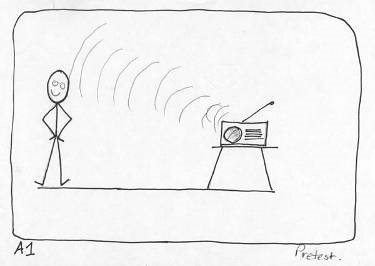
Researcher: What are the curved lines you’re drawn?
Caleb: All the sound coming out.
Researcher: And how does it get to us? What happens?
Caleb: It gets to us, it moves. The volume moves straight across the room and then it comes to you so you can listen to it.
After the unit, Caleb drew a more complex picture to depict how sound moves and explained the movement in terms of sound waves (Figure 41).
Caleb: The sound waves travel to the person. If they (sound waves) are close together they are high. If they are wide they are low. If they are tall they are loud and if they are small they are quiet.
Researcher: Is there only one sound wave?
Caleb: No there are lots of sound waves and they are travelling around the room.
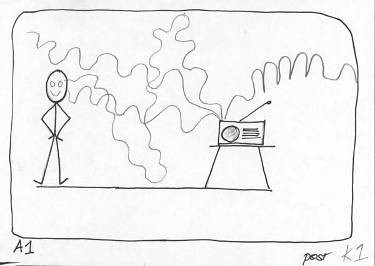
Lois used a drawing task to assess student prior knowledge of kiwi. At the end of the unit Lois asked the students to draw a kiwi. This time she emphasised the students were to think carefully about the shape and features of kiwi and also their colour. They were to draw a kiwi as a scientist might. She also asked the students to sort a set of statements into true or false to assess their content knowledge. Some of the student drawings are shown in Figure 42. They indicate good overall understanding of the features kiwi have.

In technology student learning was usually evidenced when students were able to explain how their product met the class-agreed product specifications using the language of technology.
For example, Brenda’s Year 5/6 students were able to talk about the taste and texture of their cheese and how it was palatable for people of their age. Ellie’s Year 4/5 students talked about their masks as being robust and functional. Tayla’s Year 7/8 students were able to analyse and explain the strengths and weakness of their percussion instruments in terms of the contribution they would make to the overall musical performance that was being planned. Jane’s Year 1 students demonstrated that their kites could fly and explained that they needed to run into the wind to make this happen.
Students demonstrating understanding over time and in different teaching contexts
Students linking what they learned in science or technology to different teaching contexts and different curriculum areas provided powerful evidence that they had understood an idea or practice. This is because for students to make connections they need to appreciate that an idea or practice is relevant outside the context in which it was taught. Evidence of this kind is hard to capture. Robert’s use of an action plan to design and make a fridge magnet in a technology unit a term after he had prepared an action plan as part of the process of designing and making a kite is illustrative of this type of connection. A student using a drawbridge as a door for a model house is another example. His Year 2/3 class had studied and made castles the previous term. In a further example, a Year 7 student who had studied animal adaptation in the context of the rocky shore gave a broader explanation of adaptation. Unprompted, she made the general statement, “Animals need special features to live in a particular environment.” She provided instances to illustrate this point—polar bears can’t live in the desert and a camel can’t live in the freezing cold. She extrapolated the idea of adaptation further saying, “It is not necessarily animals, plants have adapted too.” She gave examples of a water plant needing to live in water and plants on land having adapted to sun and dryness. In yet another example, some of the students in Tayla’s class were making a percussion instrument for the second time. As they began the design process some students commented that this time they would take more care with the making so that their instruments would last through the rehearsal and performance. Some students commented that because this time they had studied sound, its qualities (pitch, volume, and resonation) and production (vibrations), they would be able to consider these aspects in designing, making, and evaluating their instrument.
Students linking learning with their out-of-school experiences
During lessons the teachers invited students to contribute their prior knowledge and experiences and linked these into the class discussion. In Gail’s unit of friction, Rob explained how his father was mechanic who worked with engines. He said that he often spent time with his dad in the workshop. Rob explained to the class the ways oil was used to reduce friction in motors. During Jane’s unit on designing and making the lighting for a puppet theatre, Anna (a five-year-old) explained to her group that lights work because of an electric current that comes through the wires. She said that she had read and talked about this with her father. Simon (a seven-year-old) commented during a lesson with Lois that it was easy for him to make the healthy snacks because he did “heaps of cooking at home”. In Carol’s unit about adaptation, Mary (an eleven-year-old) explained that she was not afraid of doing a dissection because she was “used to guts being pulled out by Dad”. These examples are illustrative of how students made unprompted connections between their out-of-school experiences and the ideas they were learning in school. We present them here as evidence of depth in student understanding.
Concluding comments on temporal aspects
The findings highlighted the ways time served as both a resource and a challenge for teachers and students, and for us as researchers. The InSiTE teachers acted to provide a sense of continuity and coherence between and across ideas, tasks, and lessons. The continuing and connecting actions they used were at times particular artefacts, which provided platforms of continuity for developing skills, and deepening thinking. Continuity was also supported through teachers articulating the ways individual tasks fed into the bigger learning objective. Students making connections was supported by teacher talk about the links and connections between ideas and tasks. As a team of teachers and researchers we were able to trace change through specific tasks and by being alert to when students linked what they knew and could do from out-of-school activities, from previous lessons and school years, and from different topics into the current tasks or talk.
Section 3.5: Student perceptions of the nature of science and technology
Student perceptions of science and technology were a focus for the InSiTE study. They are reported in this section.
Perceptions of the nature of science
Students understanding the nature of science as part of their developing scientific literacy was a goal in Science in the New Zealand Curriculum (Ministry of Education, 1995). This aspect has been strengthened in the revised science curriculum (Ministry of Education, 2007). The nature of science includes understanding something of science as culture: the ways scientists work, their values, the ways scientific knowledge is generated and authenticated, ways of investigating scientifically, and so on. In planning the teaching units the teachers explicitly detailed aspects of the nature of science. They teased these out during lessons. For example, Jane noticed that when her Year 1 students went to test out whether or not a substance dissolved they added the new substance to the existing mixture not realising that each test needed to be independent of the previous ones. She explained that when scientists conduct controlled experiments they need to repeat an experiment in the same way each time with only one variable being changed in order to provide a comparison, although she did not use these terms but simpler language that her students would understand.
After a unit of classification Jenny’s year 4/5 class were asked what they thought science was and what scientists did. The students emphasised putting things into groups, although they realised not all science did this. For example:
They put things into groups and you can tell if it’s alive or not alive. We’re doing science too cos we put things into groups. We looked at animals, plants, things that are alive and not alive, and sorted into groups. There is different science though. We did sound science before, there’s lots of kinds of science. (Kevin, Y5)
Our teacher said that scientists put things into groups. That’s what scientists do. They put all animals into different groups like mammals, birds, arachnids, fish, and amphibians. Last year we did sound, but we didn’t put things into groups. But it is still science. That’s another thing they might have done. (Toni, Y5)
It’s science cos we’re putting animals and plants together, but both alive, that was the tricky bit. You had to do that flowers are not the same as animals. We haven’t got sap, we’ve got blood and because plants droop and we don’t, the petals fall off and then they die. (Jan, Y5)
After a unit on the rocky shore Carol’s Year 7–8 students were asked about their perceptions of science and scientists. The students highlighted aspects of investigations, and making things. However, their view of scientists themselves was traditional in that some viewed scientists in terms of their appearance and age. For example:
Science is about experimenting and adding liquids to liquids to create a new thing. It’s investigating. We investigated adaptation and investigated fish. … Scientists find out about new medicines. … They work both in the laboratory and out and about. They go out to find things they want to use in the laboratory like investigating plants … There are women scientists and men. Both can be scientists. I think of them as old with big, white, funny coats and with lots of pockets in their jackets full of lots of things. Scientists do good things for good causes. (Sara, Y7)
Science is usually about making explosions and experiments. … They make stuff and sometimes it goes wrong. … They wear big, googly glasses and are just a bit out there. They are professors with big glasses and big teeth and I think they are in the middle, not old and they can be males and females. They always do some experiments. (Karen, Y8)
Science is finding out about life’s mysteries. It can be a big finding, a big discovery. Science can help us and it is for good. … Scientists are clever and they help us. They teach some students and they discover science ideas that haven’t been found, and they make. … I think of white coats and sometimes they wear white and tight gloves. Some scientists wear glasses and they use lots of equipment. Edison, Einstein, and Aristotle are all scientists. (Jon, Y8)
These quotes illustrate the importance of helping students to understand science and who scientists are as well as what they do.
Perceptions of the nature of technology
Consideration of the nature of technology is an important part of developing student technological literacy. The Nature of Technology is a strand in the New Zealand Curriculum (Ministry of Education, 2007). Technology can include electronics and control technology, materials technology, food technology, structures and mechanisms technology, and production and process technology. It is about artefacts, it includes products, systems, and environments, and how and why those are developed and the impact they might have on people and our world. In planning their technology units our teachers included activities in their technology programmes that specifically addressed the nature of technology. For example, Carol and Tayla (Year 7 and 8 teachers) focused on enhancing their students’ perceptions of technology as part of their technology units. They brought some of their students to an InSiTE meeting to jointly plan a technology unit. Time was spent clarifying with the teachers and students the nature of technology. This discussion assisted the students developing a more robust understanding of the nature of technology. In the classroom these students then acted as key discussants with their peers about the nature of technology. Students also wrote statements throughout the unit about what they thought technology was. They were encouraged to add to or change any ideas they previously had. Most of the ideas initially written were related to the technicraft classes they had at school and included things like art, cooking, fabrics, wood, music, hard materials, soft materials, sewing, computers, and crafts. In comparison, their ideas at the end of the unit were much broader, for example:
Things used and created by everyday people. (Mandy, Y7)
Inventing things, changing, modifying, new ideas. It could be your job. (David, Y8)
Interacting with things, inventions, things that improve your living, modifying something. (Janet, Y8)
Things people have made that make life easier. (Zaki, Y7)
It’s all different stuff. It can be food even. Things are made from technology like the desk and chair and robots. (Shika, Y7)
Their comments depicted the nature of technology as including ideas about making life easier for people by making, modifying, and inventing products and systems. Some of these concepts were developed as they worked on the unit. However, Tayla and Carol reinforced these ideas throughout the unit. Their explicit teaching helped to develop and consolidate student ideas.
Younger students were also able to engage in conversations about the nature of technology. For instance Gail’s Year 3 and 4 students commented:
It’s about other people and how things would work for them and for me. It’s about making. (Adam, Y3)
We would go and make something you can use, like a chair, a computer, a clock. (Mandy, Y3)
It’s about making something else. You make things like a fork. (Emma, Y4)
All students who commented on the nature of technology viewed it as a practical activity to do with making. However, older students’ views were more comprehensive. They related to purposeful designing and making, with particular artefacts and activities being designed for specific groups of people. For example:
It’s something that helps us do something. For example, the whiteboard is like a pen and paper but a development, like chairs are to help us sit instead of sitting on the ground. A cup is to drink water from easier. Technology helps us see better with glasses. It helps us do things and makes things better. Like in the sewing room we have heaters to keep us warm in winter. It’s not just electrical things. (Tim, Y8)
Technology is lacking something and kind of improving it and enhancing it in different ways. For example, the tyre went from wood to wood and tyres to tyres and then tyres have improved over time and now they are easier to us. … Technology can be helpful and harmful. For example machinery can be dangerous, like guns. (Mike, Y7)
When teachers specifically included opportunities for students to have “nature of technology” conversations, a broadening of concepts was fostered. The strategies the teachers undertook to broaden student concepts included class and group conversations about technology, using charts to summarise ideas, and students recording their personal ideas on several occasions and then comparing their ideas.
In the next section we examine ways of introducing the idea of students as scientists and technologists as a way of enhancing their understanding of the nature of science and technology.
Positioning students as scientists/technologists
From a sociocultural perspective, learning science and technology is not just a matter of students mastering a body of knowledge and skills. It also involves them in developing some understanding of the nature of scientists and technologists and how they work (McCormick, 2004). Some of the InSiTE teachers, notably Jane, Ellie, and Lois positioned their students as scientists/technologists through their talk. This positioning was sometimes prospective and entangled with the teachers setting out the parameters of a task. The attribution of identity was explicit and the teachers were quite specific about the behaviour and attitudes they expected.
The following example from Lois’ class involved her positioning her students as scientists—as being palaeontologists. In the third lesson of a unit on fossils Lois asked her Year 1–3 students to be, or rather pretend to be, palaeontologists. Lois’ positioning of her students was in part an attempt to make the school-based task of digging for fossils in the school sandpit more authentic. The fossils were wooden dinosaur bones. Lois had begun the unit by getting the students to examine a set of actual fossils and they had considered how fossils were formed. The dig was intended to help the students appreciate how fossils were located and accessed. This task however was inherently contradictory: the students needed to engage in the task as authentic whilst simultaneously appreciating which aspects reflected the real situation and which did not. The fossil dig involved the students digging wooden dinosaur “bones” out of the school sandpit. She introduced the dig saying, “Today we are going to pretend we are palaeontologists.” She read aloud from a picture book about how palaeontologists find bones and that fossil bones are very “fragile” and so scientists need to be “careful” and use “special tools” (brushes) on a dig. She showed students another book that explained how palaeontologists sketched the site and any fossils before removing them. She then gave them the special tools (a brush and ice cream stick) they were to use. At the dig (the sandpit) the students were very careful as they brushed the sand and looked for the fossils. They discussed the need to be careful because the fossils were fragile.
Some of the students also discussed whether or not the fossils and the dig activity were real:
Sue: Are these real dinosaur bones?
Colin: Fake.
Jill: Just practice before we find real ones.
Although some of the students were uncertain, the general consensus was that what they were doing was practice for later, a precursor for a real experience. When Lois told them exactly how many “bones” they needed to find they counted what they had and extended their search enthusiastically even though this might be seen to further undermine the authenticity of the activity. Back in the classroom, Lois prompted the students to consider the difference between their recent experience and the real thing.
An example of teacher positioning students as technologists, in this case their being a “designer”, occurred in the second lesson of a unit on mask making. Ellie talked with her Year 3/4 students about them being designers. Their task for the day was to design the mask they were going to make for their forthcoming school production. Ellie introduced this task to the students by saying, “Today we’re carrying on with our mask work. We are going to decide on our specifications for our masks and we are going to draw our plans for making them.” However, before they began on the specific task Ellie asked her students what they knew about designing. Marcus replied, “It’s drawing what you are going to make.” Aviner added that, “It is showing everything about what you are going to do. You draw it.” Ellie confirmed their ideas. Then she led a whole-class discussion to establish the mask specifications. She instructed the class that their design drawings had to include these specifications. Ellie then showed the students an architectural drawing of a house elevation commenting, “This is a design drawing of a house. Can you see the roof, the walls, the windows, the doors?” The students nodded affirmatively each time. Ellie then said:
The designer had to put all those things in his drawing. They were his specifications. You are going to be designers just like him. You need to show in your drawing that you have thought about all of the specifications we’ve decided. You need to draw what you are going to make. Can you do this?
The students were positive they could and their subsequent designs successfully addressed all specifications. Ellie’s positioning of her students as designers served to help make their task of designing masks an authentic technology task.
Concluding comments on student perceptions of the nature of science and technology
Sociocultural views of learning emphasise that learning a subject involves more than learning the content. It involves students learning about what is means to be a scientist or a technologist and how they conduct their work. This section has illustrated how introducing students to ideas around the nature of science and technology contributed to their understandings of science and technology and contributed to the authenticity of their experiences.
Summary of the findings
This section has set out some of the key findings from the InSiTE project as they relate to the research questions. The structure of the main body of questions provided for a focus on:
- the influence and contribution of what a teacher brings to the teaching and learning of science and technology through a focus on teacher PCK
- the joint construction of what it means to learn, know, and do science and technology through a focus on interactions around the ideas and practices of science and technology
- the temporal aspects of teaching and learning, and more particularly the networks and pathways of student learning in terms of continuity, connection, and coherence in the development of their ideas, their mastery of the practices of science and technology, and understandings about what it means to be a scientist or a technologist.
The findings of the project indicate that the dimensions of interactions pertain to their involving multimodal means for making and expressing meaning. They were supported by shared understandings and patterns for interacting around ideas, and the distribution of authority over what counted across people, artefacts, and practices. These aspects also contributed to the construction of student autonomy and agency. The temporal aspect of interaction not only relates to what knowledge can be taken as common and which patterns of interaction are taken-as-shared, but also to the dynamic iterative and evolutionary nature of interaction.
4. Limitations
This section details the limitations of the project.
Teachers as teacher-researchers
One of the goals of the TLRI programme was that teachers participate in the projects as teacherresearchers. Although there are many meanings of this term in the literature, we do not consider that the way we came to work as a team of teachers and researchers resulted in teachers taking up a role as teachers as researchers in the pure sense. Rather, we conceptualised our joint involvement as a partnership in which teachers acted in support of the research process and researchers acted in support of the teaching and learning process. In our case we always intended to work within the classroom with the teachers, thereby reducing the need for them to take full responsibility for data generation. This decision was deliberate because we were well aware of the complexity of the classroom and the demands on teachers in supporting the learning of diverse groups of students. Our focus was on interaction: how interactions played out and how they might be made more effective. We did not want to divert our teachers’ attention from this focus. Given our long-term commitment to research on interaction and PCK, the questions that we have as researchers are similar to those teachers ask themselves every day. These questions include: What do we know about this student? What do we know about how students best learn this science or technology content? How can we help these students learn this science or technology process? What support can we provide to guide these students to become independent learners in science and technology? These questions proved to be of interest to our teachers.
The teachers were actively involved in the research process. They participated in the analysis of the data, in the refinement of the research focus and direction, and in the writing up and presentation of research findings. They participated as equals who had different and complementary knowledge and experience, thereby enriching the research process and any possible benefits deriving from the project. Working with our teachers in this way helped us to maintain a focus on the “how” as well as the “what” and “why” of interactions around ideas, of PCK development, and student learning pathways.
A three-year project
We set up the project as a three-year longitudinal study in anticipation that it would be possible to trace teacher and some individual student learning over this period of time. However, by 2007, for various reasons, only six of the original 12 teachers and four of the original six schools remained actively involved in the project. This reduced our capacity to examine learning across Years 1 to 8 and in a diversity of schools. Originally there were two teachers from each of the six schools involved in the project. In the first year it was obvious that the teachers valued the support of a same-school colleague. In the final year four of teachers were sole participants from their school, meaning that the profile of the project in these schools was reduced and the teachers lacked a colleague-in-support.
Initially, we had anticipated we might be able to trace individual students over the three-year period or at least work with teachers teaching the same year group across this time. The goal was to develop robust data of student learning pathways over a time of more than a year. However, teachers were allocated different class levels by their school, and except in a few cases it proved impossible to work with the same students over more than a year.
Another constraint on the project gathering longitudinal data was the location of science and technology in the school curriculum, meaning that these subjects were not often taught more than once or twice during a year. This contributed issues around scheduling classroom work and sustained focus and development within each of the curriculum areas.
The long-term nature of the project also had repercussions for the research team. Over the three years the composition of the team changed somewhat, influencing the direction of the research process.
Recommendations for future research: tracing student learning
The issue of how to generate reliable and valid evidence about student learning and the forms that this evidence might take remains a somewhat unresolved issue for the InSiTE team. This issue was discussed and debated at every team meeting, and with increasing intensity as the project drew to a close. As a team of teachers and researchers, we were convinced that students need to have multiple and multimodal opportunities to represent what they know, are thinking about, and able to do. We discussed the need to provide opportunities for students to talk, write about, draw, and use action as modes for meaning making and communication. Through this discussion we identified issues around the affordances of each of these modes in terms of what and how students might be able to use them. We consider that further research is required into the student use of multiple and multimodal means to make and communicate meaning, and the role of the social, cultural, material, and temporal aspects of the context in which students are learning.
5. Strategic, practice, and research value
Whether and how they might need to change their classroom practices is a question that faces teachers in times of reform. While the InSiTE study was conducted prior to the introduction of the revised New Zealand Curriculum (Ministry of Education, 2007), the findings of the study have implications for teachers and policymakers as they work to implement the curriculum. This section sets out the contribution of the study to the TLRI strategic, practice, and research goals.
Strategic and practice value
Understanding the processes of teaching and learning
Recent research highlighted that the majority of New Zealand primary teachers consider they lack the confidence and knowledge needed to teach science and technology (McGee et al., 2003). The key strategic value of the research was in terms of gaining a greater understanding of the complex and dynamic processes of classroom interactions and their contribution to student learning within science and technology.
This study has explicated the nature and means for development of teacher PCK. Subject-specific planning frameworks proved to be an effective means for helping teachers to articulate and extend their PCK. It seems likely that the planning frameworks were particularly successful in this function because all the teachers involved were using the same framework, and their use of the framework supported the development of a shared language and understanding of the key aspects of science and technology, and of means for teaching these subjects. The use of a common format was also supported by researcher involvement in the planning process, leading to greater mutual understanding of classroom interactions and their anticipated outcomes. The planning process was enhanced through a multilayered analysis and provision for teaching and learning. This multilayered process facilitated effective teacher PCK, which led to enhanced classroom AfL practices.
Data from the classrooms illustrated the multimodal nature of classroom interactions that support effective assessment for learning, particularly in the development of student ideas and practices in science and technology. It has foregrounded the often taken-for-granted role played by the artefacts teachers use to support student learning and their own teaching as part of eliciting and providing feedback on student ideas. Artefacts provide a scenario and resources for interaction. They anchor and augment talk. Publicly visible and accessible artefacts in whole-class settings provide direction, guidance, and support for interactions between large groups of students.
The InSiTE teachers were making active use of tasks that provided students with multiple opportunities to make and express meaning through a combination of modes—drawing, talking, writing, action as dramatisation, and the use and production of artefacts. Over the course of the study, the teachers, as they came to appreciate the ways that artefacts provide scenarios and resources for interaction, paid more attention to the form and function of the artefacts they used. In the case of their use of the planning framework, the nested task structure meant they had more deliberately thought through connections between tasks and between tasks and their intended student learning outcomes. Their use of a framework that focused on key features of the discipline guided their preparation of opportunities for interaction and encouraged them to think through the questions they might ask. In the same way, artefacts as partial scripts and objects for illustration, demonstration, and elaboration supported collective meaning making. The use of real artefacts and activities in particular helped teachers to elicit student prior knowledge and experiences that could then be used as resources to expand the pool of ideas available for public discussion. The focus of research and professional development has tended to be on teacher talk, but we would recommend a concurrent focus on material resources as a means to support meaning making. The design of tables and charts incorporate understandings that have been developed over time. They are intended to be interpreted in a particular way that may not be known to students. Teacher time and attention to their introduction as objects with form and function would support student learning and help students access them as culturally developed and validated tools for thinking.
Both science and technology as disciplines rely heavily on the production and use of the visual mode. In both cases, becoming competent in the subject requires students to develop proficiency with a range of graphics, drawing techniques and conventions, and other image-based representations. As they focused more on student use of the visual, the InSiTE teachers become aware that drawing, in particular, was a knowledge-based practice, and students benefited from direct instruction. This finding will be of interest to teachers as they work to develop pedagogies around the key competency of using text and symbols. Science and technology provide authentic contexts to explore the use of the visual in conjunction with and as an alternative to text (oral and written). While talk of new literacies has tended to be located in the English curriculum, science and technology curricula have a contribution to make in this area. The InSITE teachers also used other curriculum areas as sites for the development of student science and technology skills. This is to be encouraged given the recommendation by Nuthall (2007) that students need to encounter the same ideas across a number of contexts. The use of multiple modes and opportunities for students to access ideas also fits with best practice as detailed within the Quality Teaching Best Evidence Synthesis (Alton-Lee, 2003).
Our examination of artefacts to highlight their ideal (conceptual) and physical attributes, where relevance is talked into meaning, has implications for the production and introduction of resource material for teachers, in much the same way as we have demonstrated the implications of teacher introduction of designed artefacts to their students. It is not enough to make an artefact available. It needs to be talked into social action. This was amply illustrated by the evolution of the planning framework and the practices that it afforded. Teacher appropriation of this as a tool was embedded in and progressed through collaborative talk about planning and about subsequent action and interaction in the classroom.
Addressing diversity/reducing inequalities
The study has examined the way teachers introduce and develop subject ideas with diverse groups of students. It has provided the opportunity for teacher-researchers to make explicit, build on, and share more widely the subject-specific PCK teachers need to interact with students in ways that support and enhance student understanding for diverse groups of students. The role of the visual, action, and artefacts in classroom interaction has tended to be overlooked and underplayed, perhaps because of their ubiquity and everydayness. Classroom studies in science and technology education are only just beginning to explore teacher and student use of multiple and multimodal resources for meaning making and communication. Our data suggests that New Zealand primary teachers and students make extensive use of a wide variety of modes in the teaching and learning of science and technology. The InSiTE teachers and students used talk in conjunction with written text, visual materials, gesture, demonstrative actions, and the manipulation and production of objects and artefacts to express and develop science and technology ideas and practices. Teacher and student talk played a pivotal role in interaction, but their talk was invariably anchored and augmented by other modes. When multiple multimodal opportunities are provided, the chance of all students being able to contribute is enhanced.
Research value
Consolidating and building knowledge
Sociocultural perspectives are increasingly being used to make sense of classroom teaching and learning because they acknowledge complexity and the impact of interactions between people, ideas, tools, and settings over time. Sociocultural perspectives allow for a focus on individual diversity and the development of collective understanding for students and teachers.
Identifying and addressing gaps in our knowledge/being forward looking
If research-informed practice is to be encouraged then classroom-based research is essential. This research has attempted to bring together the various threads of research in classrooms and focus on the complexity of interactions. Previously little or no work had been undertaken on the interrelationships between subject ideas in science and technology as they might pertain to groups of students, teacher PCK, and classroom interactions. This research has provided evidence of ways to enhance teacher PCK and classroom interactions, with a flow on effect on student learning. In this way its focus resonates with what Loewenberg Ball and Forzani (2007) identifies as research in education; that is, research that attends to the contextualised interactions between teachers, students, and content.
Building capacity
The research built capacity in classroom-based research both at the teacher-researcher level and at the researcher level. The teachers involved developed an understanding of research processes and the ways in which these can enhance classroom practice. They developed research skills themselves through discussing and analysing their classroom practice, and negotiating and evaluating a research-based intervention. The researchers extended their knowledge and practices for working collaboratively in classrooms.
6. Conclusions
A significant goal of the Classroom InSiTE (Classroom Interactions in Science and Technology Education) research project was to develop a more robust understanding of and to enhance classroom interactions to support teacher and student involvement in AfL. The project set out to investigate this goal through a focus on teachers and the way their PCK informs interaction, a focus on the nature and outcome of teacher–student interaction around the ideas and practices of science and technology, and a focus on the nature of student learning pathways.
The importance of teacher PCK (Jones & Moreland, 2003) and the beneficial role that subjectspecific planning can play in helping teachers to articulate and refine their PCK has been reaffirmed by the project. Teachers need a rich and flexible PCK if they are to be able to respond to student learning in the moment of interaction as part of AfL. The findings of the project have explicated the representational and social aspects of interactions around ideas in science and technology. The project classroom work highlighted the multimodal nature of classroom interaction when teachers and students come together to express, explore, and extend student understanding, skills, and abilities in science and technology (Kress et al., 2001; Roth, 2005). Scientists and technologists rely heavily on charts, diagrams, visuals, written text, gesture, modelling, artefacts, and other means in the development and dissemination of new ideas and practices. Students talking about, and using these means to represent what they know and can do is an important aspect of their learning and their understanding about the nature of science and technology. Science and technology knowledge and practices are validated through peer review as a collaborative consultative process. In the classroom, the routines teachers established and the ways they set up the distribution of authority over valid and valued knowledge and practices shaped student autonomy and agency. In addition to shaping what it meant to do science and technology in a particular classroom these aspects shaped student opportunities for selfassessment. The project also focused on the temporal aspects of interaction and learning in the classroom. Time was shown to be both a resource and a constraint in the teaching and learning process. Teachers acting to create a sense of continuity, connection, and coherence was important to their students maintaining a focus on learning. However, tracing student learning across the multiple timescales and contexts that are of interest when learning is viewed from within a sociocultural lens (Mercer, 1995; Pea, 2004; Wertsch, 1991) proved problematic. In part this was because this lens also draws attention to the emergent situated nature of interaction, learning, and teaching. The project, in highlighting the communicative, social, material, and temporal aspects of interaction, has gone some way towards illuminating the complexity of classroom interactions. This mapping provides an alternative perspective on interactions for assessment for learning, one that resonated with our teachers and proved useful in informing their planning and interaction.
Long-term studies open up different possibilities for teachers and researchers to develop generative relationships and practices to investigate what/how teaching, learning, and assessment for learning are accomplished in the classroom. Our working across the two subjects highlighted that these will be accomplished in different ways depending on the subject. Our collaboration with the teachers in the InSiTE project has affirmed for us the value of educational research that focuses on the multiple and dynamic interactions and relationships between teachers, students, and content (Loewenberg Ball & Forzani, 2007). We consider further research is needed to explicate this instructional dynamic and to understand how the findings of such research might be introduced and used in the same instructional sense by teachers.
References
Alton-Lee, A. (2003). Quality teaching for diverse students in schooling: Best evidence synthesis. Wellington: Ministry of Education.
Appleton, K. (2003). How do beginning primary school teachers cope with science? Toward an understanding of science teaching in practice. Research in Science Education, 33, 1–25.
Appleton, K., & Kindt, L. (1999). Why teach primary science? Influences on beginning teachers’ practices. International Journal of Science Education, 21, 155–168.
Atkin, M., & Black, P. (2003). Inside science education reform: A history of curricular change. New York: Teachers College Press.
Ball, D., & Cohen, D. (1996). Reform by the book: What is—or might be—the role of curriculum materials in teacher learning and instructional reform? Educational Researcher, 25(9), 6–8, 14.
Black, P., & Wiliam, D. (1998). Assessment and classroom learning. Assessment in Education, 5(1), 7–74.
Cowie, B. (2000). Formative assessment in science classrooms. Unpublished PhD thesis, University of Waikato, Hamilton.
Cowie, B., & Moreland, J. (2007). It’s a kiwi: Multimodal approaches to exploring and extending young children’s science ideas. Australian Research in Early Childhood Education, 14(2), 37–46.
Engeström, Y., Miettenen, R., & Punamaki, R-L. (Eds.) (1999). Perspectives on activity theory (pp. 323–347). Cambridge, UK: Cambridge University Press.
Erickson, F. (1998). Qualitative research methods for science education. In B. J. Fraser, & K. G. Tobin (Eds.), International Handbook of Science Education (pp. 1155–1173). Dordrecht: Kluwer Academic Publishing.
Goodrum, D., Hackling, M., & Rennie, L. (2001). The status and quality of teaching and learning of science in Australian schools. Canberra, ACT: Commonwealth of Australia.
Grossman, P. (1990). The making of a teacher: Teacher knowledge and teacher education. New York: Teachers College Press.
Harlen, W. (1997). Primary teachers’ understanding in science and its impact in the classroom. Research in Science Education, 27, 323–337.
Jones, A., & Moreland, J. (2003). From classroom-based research to school-wide reform in science and technology teaching practices: The case of Mountview school. Paper presented at the annual conference of the Australasian Science Education Research Association, Melbourne, 9–13 July.
Kress, G., Jewitt, C., Ogborn, J., & Tsatsarelius, C. (2001). Multimodal teaching and learning: The rhetorics of the science classroom. London: Continuum.
Lampert, M., & Ball, D. L. (1998). Mathematics, teaching, and multimedia: Investigations of real practice. New York: Teachers College Press.
Leinhardt, G., & Steele, M. (2005). Seeing the complexity of standing to the side: Instructional dialogues. Cognition and Instruction, 23(1), 87–163.
Lemke, J. (1990). Talking science: Language, learning, and values. Norwood, N.J.: Ablex Publishing.
Lemke, J. (2000). Across the scales of time: Artefacts, activities, and meanings in ecosocial systems. Mind, Culture and Activity, 7(4), 273–290.
Loewenberg Ball, D., & Forzani, F. (2007). What makes education research “educational”? Educational Researcher, 36(9), 529–541.
McCormick, R. (2004). Issues of learning and knowledge in technology education. International Journal of Technology and Design Education, 14(1), 21–44.
McGee C., Jones, A., Cowie, B., Hill, M., Miller, T., Harlow, A., & MacKenzie, K. (2003). Teachers’ experiences in curriculum implementation: Mathematics, science and technology. Report to Ministry of Education. Hamilton: University of Waikato.
Mehan, H. (1979). Learning lessons: Social organization in the classroom. Cambridge, MA.: Harvard University Press.
Mercer, N. (1995). Guided construction of knowledge: Talk amongst teachers and students. United Kingdom: Multilingual Matters.
Ministry of Education. (1993). Science in the New Zealand curriculum. Wellington: Learning Media.
Ministry of Education. (1995). Technology in the New Zealand curriculum. Wellington: Learning Media.
Ministry of Education. (2007). New Zealand curriculum. Wellington: Learning Media.
Moreland, J. (2003). Becoming effective technology teachers: Enhancing assessment practices in primary classrooms. Unpublished PhD thesis, University of Waikato.
Moreland, J., & Cowie, B. (2007). Making masks for Maui: Keeping the macro in mind. Australian Research in Early Childhood Education, 14(1), 81–93.
Nuthall, G. (2007). The hidden lives of learners. Wellington: New Zealand Council for Educational Research.
Pea, R. (2004). Commentary: The social and technological dimensions of scaffolding and related theoretical concepts for learning, education, and human activity. The Journal of Learning Sciences, 13(3), 423–451.
Prain, V., & Waldrip, B. (2006). An exploratory study of teachers’ and students’ use of multi-modal representations of concepts in primary science. International Journal of Science Education, 28(15), 1843–1866.
Rogoff. B. (2003). The cultural nature of human development. Oxford, UK: Oxford University Press.
Roth, W.-M. (1994). Experimenting in a constructivist high school physics laboratory. Journal of Research in Science Teaching, 31, 197–223.
Roth, W.-M. (2005). Talking science: Language and learning in science classrooms. Lanham: Rowman & Littlefield.
Roth, W.-M., McGinn, M., Woszczyna, C., & Boutonne, S. (1999). Differential participation during science conversations: The interaction of focal artifacts, social configuration and physical arrangements. Journal of Learning Sciences, 8, 293–347.
Shulman, L. (1987). Knowledge and teaching: Foundations of the new reform. Harvard Educational Review, 57(1), 1–22.
Stein, M., Smith, M., Henningsen, M., & Silver, E. (2000). Implementing standards-based mathematics instruction: A casebook for teacher professional development. New York: Teachers College Press.
Tytler, R., Peterson, S., & Prain. V. (2006). Picturing evaporation: Learning science literacy through a particle representation. Teaching Science, 52(1), 12–17.
Wells, G. (1999). Dialogic inquiry: Towards a socio-cultural practice and theory of cognitive and computational perspectives. Cambridge, UK: Cambridge University Press.
Wertsch, J. (1991). Voices of the mind: A socio-cultural approach to mediated action. Cambridge, MA.: Harvard University Press.
Acknowledgements
We are grateful to Julie, Glenis, Tanya, Candy, Julie, Bronwyn, Louise, Erin, Greg, Mary, Deidre, and Graham for being prepared to make a commitment to a three-year project and for their willingness to accept us into their classrooms and discuss ideas and issues with us. We wish to thank the students for allowing us to investigate their learning and for their willingness to talk with us. We also wish to thank the principals of the schools involved for their ongoing support of the project. We appreciated the research contributions of Paula Wine, Christine Deeley, Marianne Robertson, and Barbara Ryan who worked with us at various stages during the project.

